inbox and environment news: Issue 563
November 20 - 26, 2022: Issue 563
The Ku-Ring-Gai GeoRegion UNESCO Proposal
Pittwater’s zonings have been critical to protecting this spectacular and precious area. Large swathes of our suburbs were classified as Environmental Zones - later redefined by the NSW government as Conservation zones. Much of Pittwater’s residential areas are currently zoned C4 (Environmental Living).
Conservation zones, such as C4, are applied to properties with significant environmental values - which may be ecological, scientific or aesthetic - and to those potentially exposed to significant hazards such as bushfires, flooding and landslides. The zones help determine what owners are allowed to do on their land.
- Cliffs, beaches, and lagoons from Long Reef to Barrenjoey.
- Ku-ring-gai Chase National Park.
- Muogamarra Nature Reserve.
- Northern Garigal National Park.
- Berowra Valley National Park.
- Numerous geological sites, including several sites of international significance. Currently more than 45 key geosites have been identified across the area.
- Extensive rare and threatened flora and fauna
- Ku-ring-gai Chase National Park was registered on the National Heritage List in 2006, with the following assessment:
‘Summary of Significance: Ku-ring-gai Chase National Park and Long Island, Lion Island, and Spectacle Island Nature Reserves contain an exceptional representation of the Sydney region biota, a region which is recognised as a nationally outstanding centre of biodiversity. The place contains a complex pattern of 24 plant communities, including heathland, woodland, open forest, swamps and warm temperate rainforest, with a high native plant species richness of over 1000 species and an outstanding diversity of bird and other animal species. The place is an outstanding example of a centre of biodiversity.’
- The area provides a vast array of Aboriginal heritage sites including rock engravings, cave art sites, grinding grooves, shell middens, occupational deposits, stone arrangements and burials. It is one of Australia’s most dense areas for Aboriginal sites. Over 570 sites recorded, some with multiple site traits.
- The proposed ‘Ku-ring-gai’ GeoRegion reveals the best exposed geological section of early to mid-Triassic period (240 million years ago) sedimentary rocks in the Sydney Basin.
- The sediments were deposited in Gondwana adjacent to a high latitude coast under a cold climate in fluvial, lacustrine, and shallow marine environments. Various rock units contain a diversity of fossils that inform us of past environments over nearly 50 million years.
- The GeoRegion includes eight volcanic diatremes (pipes) and associated dykes with the Hornsby diatreme having perhaps the best known exposed geological section in NSW, if not in all Australia.
Ku-Ring-Gai GeoRegion: A New Concept In Landscape Conservation
Help Guide Future Decisions For Manly Dam
The Council are calling for expressions of interest from the community to sit on the advisory committee that will guide decisions about how Manly Dam is managed over the next four years.
Officially known as the Manly Warringah War Memorial State Park, we’re seeking to appoint three community members to the Advisory Committee including:
- an environment representative
- a recreational representative
- a community representative.
Manly Dam is a popular spot for enjoying picnics, bushwalking, mountain biking, swimming, and water-skiing. Loved by locals and visitors, this dedicated war memorial and State Park is home to a wide variety of significant ecological communities and flora and fauna.
This is your opportunity to have your say on how this beautiful park is managed over the next four years.
The Manly Warringah War Memorial State Park Advisory Committee includes three community members, and representatives from Council and the NSW Government.
If you’re interested in a position, submit your expression of interest on the council website before 11 December 2022
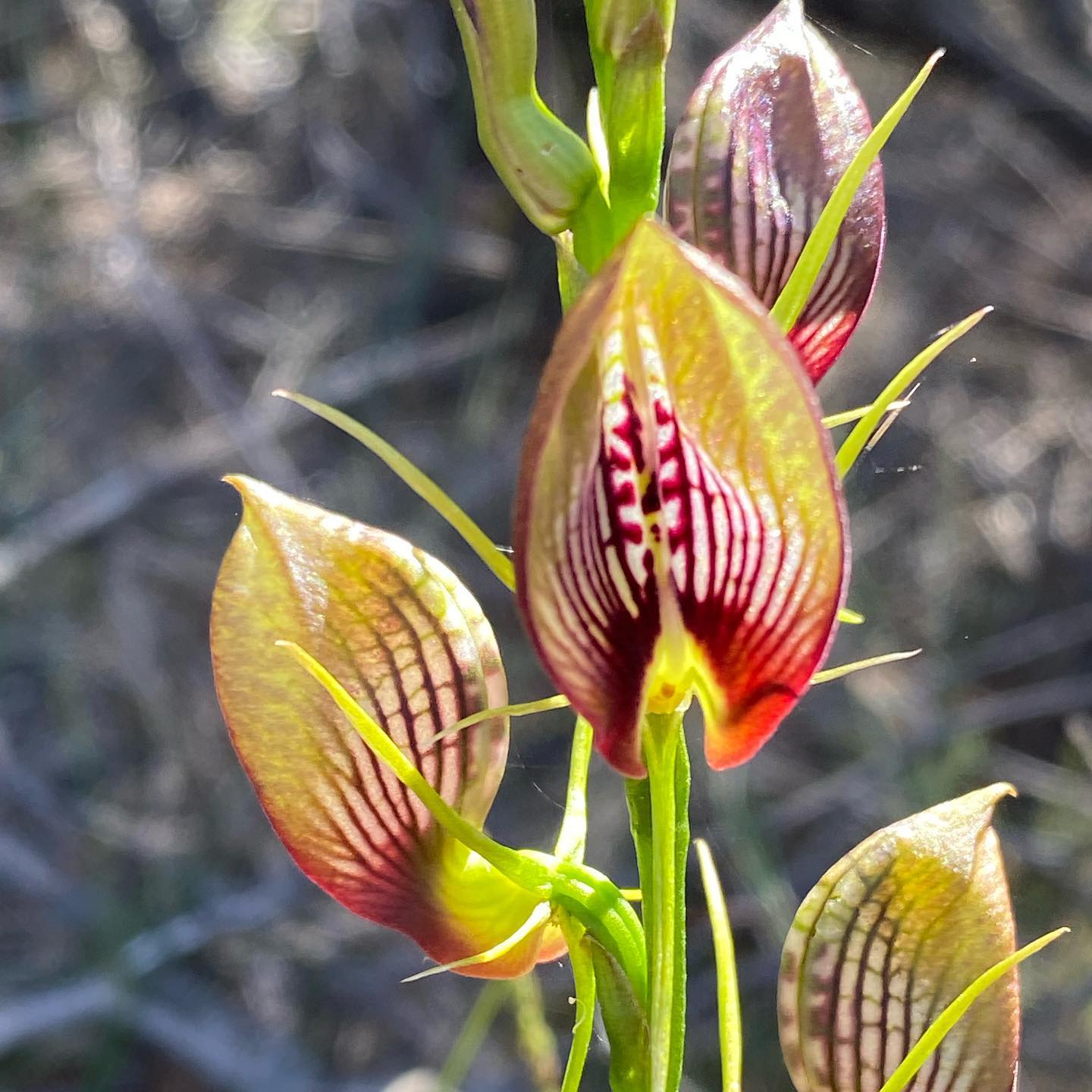
Orchid at Manly Dam. Photo: Selena Griffith
Mozzies are everywhere right now – including giant ones and those that make us sick. Here’s what you need to know
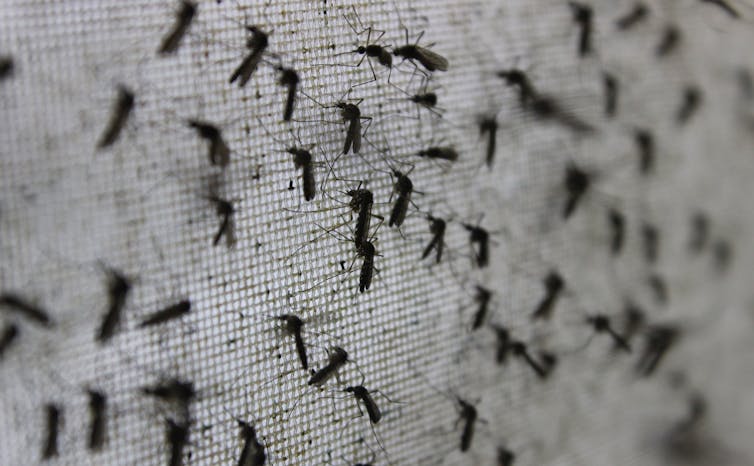
Like all insects, mosquitoes thrive in warmer weather. But what they really need is water. La Niña rainfall and flooding are providing the perfect breeding ground for mosquitoes, with numbers exploding in recent weeks.
People are also seeing giant mosquitoes, tiny mosquitoes, and species they haven’t noticed before. Some of these mosquitoes are around every season but their numbers are booming, thanks to the favourable conditions.
Australia has around 300 species of mosquito. So which do you need to look out for?
First, let’s go over some mozzie basics.
Mozzies Live For Around 3 Weeks
The mosquito life cycle is complex. Eggs are laid on or around water. When immature mosquitoes hatch, they’re completely reliant on being in water.
During the warmer months, it may take as little as a week for an adult mosquito to emerge from the water to start buzzing and biting.
Adult mosquitoes only live for about three weeks.
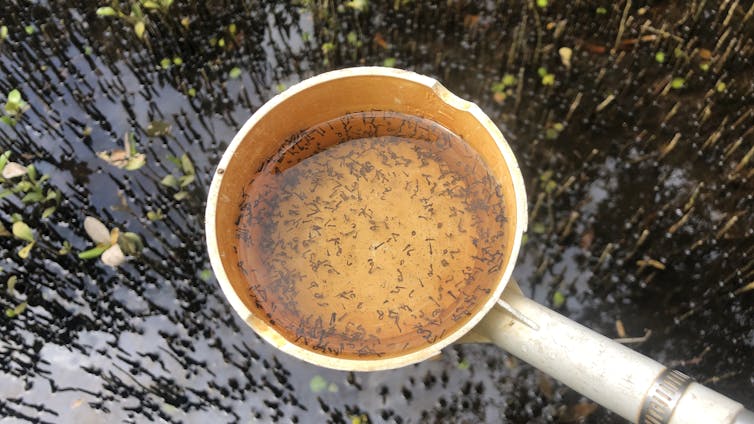
Only Females Bite
As well as water and warmth, mosquitoes also need blood. But only female mosquitoes bite, as they need the extra nutritional hit to help develop eggs.
Mosquitoes don’t just bite people. They will bite a wide range of mammals, birds, reptiles and amphibians. They can even bite earthworms, mudskippers (amphibious fish) and maybe even whales.
What Are ‘Giant’ Mosquitoes?
One mosquito in Australia that doesn’t bite at all is Toxorhynchites speciosus, a “giant” mosquito, common in eastern Australia.
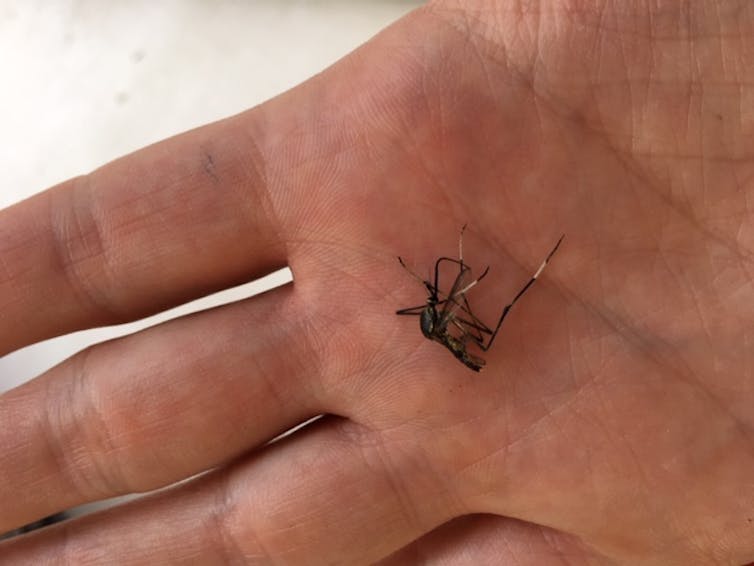
The mosquito is predatory: their “wrigglers” often eat those of other pest mosquitoes. Closely related mosquitoes have even been used for mosquito control in other counties.
But it isn’t these “friendly” mosquitoes causing all the problems after flooding.
Other mosquitoes, commonly known as “floodwater mosquitoes”, can bite and are found in large swarms following flooding. They’re a serious nuisance. Examples of these mosquitoes include Aedes sagax, Aedes vittiger, and Aedes aculeatus. They often disappear as quickly as they appear.
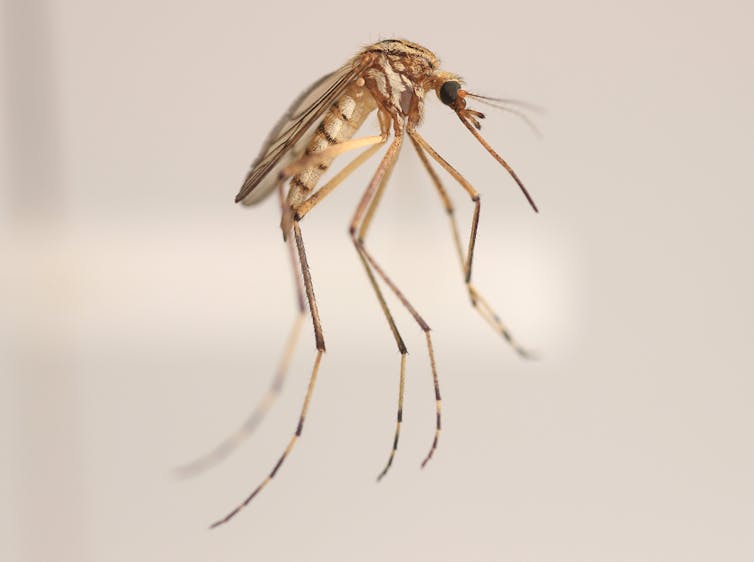
Mosquito surveillance programs, such as the NSW Arbovirus Surveillance and Mosquito Monitoring Program, are picking up these mosquitoes (and lots of smaller species) already this season. Perhaps the most famous of them all is the large, sandy-coloured mosquito Aedes alternans. Commonly known as the Hexham Grey, this mosquito has had poems written about it and there is even a “big mozzie” in Hexham, NSW.
Which Mosquitoes Make Us Sick?
Despite the diversity of mosquitoes in Australia, only a few pose a serious public health threat.
Aedes notoscriptus mosquitoes have given up their natural habitat and adapted to life in water-filled containers around our homes. They’ve proven to nuisance-biting pests as well as transmitting viruses that make us sick.
In coastal regions of Australia, Aedes vigilax (commonly known as the saltmarsh mosquito) and Aedes camptorhynchus (commonly known as the southern saltmarsh mosquito) are found in estuarine wetlands. These include mangrove and saltmarsh habitats where water is often brought in with “king tides”. The mosquitoes tolerate the salty conditions. These mosquitoes can emerge in huge numbers in summer, are aggressive biters, and can fly many kilometres from wetlands. They are also the mosquito most likely to be causing outbreaks of mosquito-borne disease in coastal regions due to their ability to spread Ross River virus.
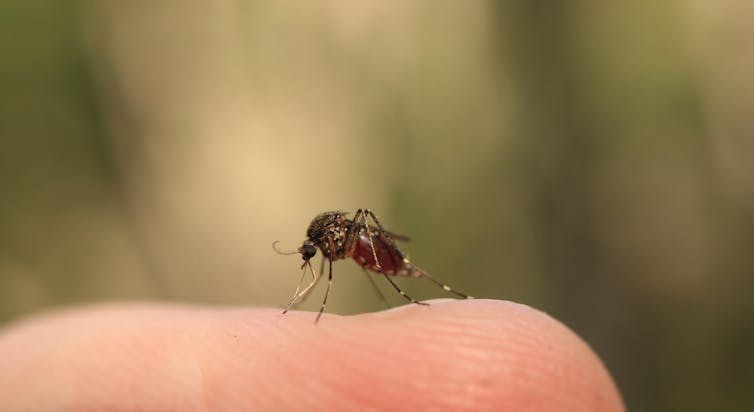
There are a number of pest mosquitoes found in freshwater wetlands. The biggest pest is Culex annulirostris (commonly known as the banded freshwater mosquito). This mosquito is found in a range of habitats, from wetlands to stagnant puddles. The banded freshwater mosquito is probably the most important species when it comes to spreading pathogens such as Ross River virus, Murray Valley encephalitis virus, and Japanese encephalitis virus.
How Can We Beat Their Bites?
After three years of above average rainfall, and recently flooding, most of eastern Australia is just one giant mosquito habitat. While some efforts to use insecticides to control mosquitoes may be effective, the reality is the task of adequately controlling mosquito numbers is insurmountable.
There are some steps you can take to protect yourself and family from mosquito bites. When outdoors, wear a loose-fitting long sleeved shirt, long pants, and covered shoes. You can even treat your clothing with chemicals such as permethrin or transfluthrin.
Insect repellents also provide protection. Products that contain deet, picaridin, or lemon eucalyptus oil will provide the longest-lasting protection but ensure you cover all exposed areas of skin.
Mosquito coils and other products may help when paired with repellents.
Now the bad news. The floods may pass quickly but the water is going to remain in pools and puddles across much of eastern Australia for most of the summer. That is great news for mosquitoes but not so good for those of us already nursing arms and legs full of itchy red mosquito bites.![]()
Cameron Webb, Clinical Associate Professor and Principal Hospital Scientist, University of Sydney
This article is republished from The Conversation under a Creative Commons license. Read the original article.
Flowering Now
The Pittwater Natural Heritage Association (PNHA) tell us Bottlebrushes are done, and now it’s time for Melaleucas.
They have fluffy flowers because their many stamens grow five bundles on each flower. Photos; Small tree Snow in Summer aka Melaleuca linariifolia is white, flowers attracting lots of insects, in Warriewood Rd, and Etival St Avalon. Hillock Bush aka Melaleuca hypericifolia a sprawling shrub is dusty red.
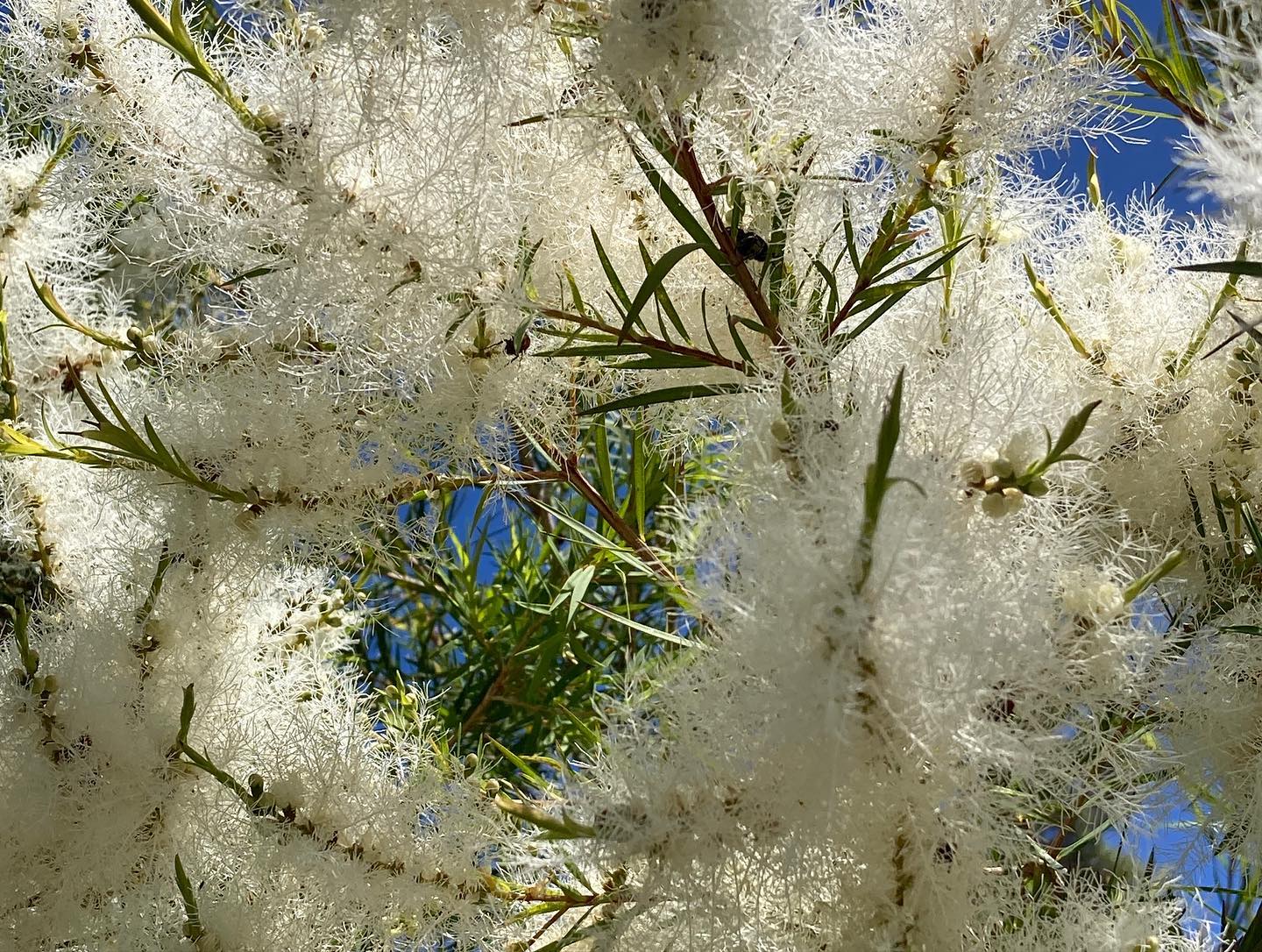
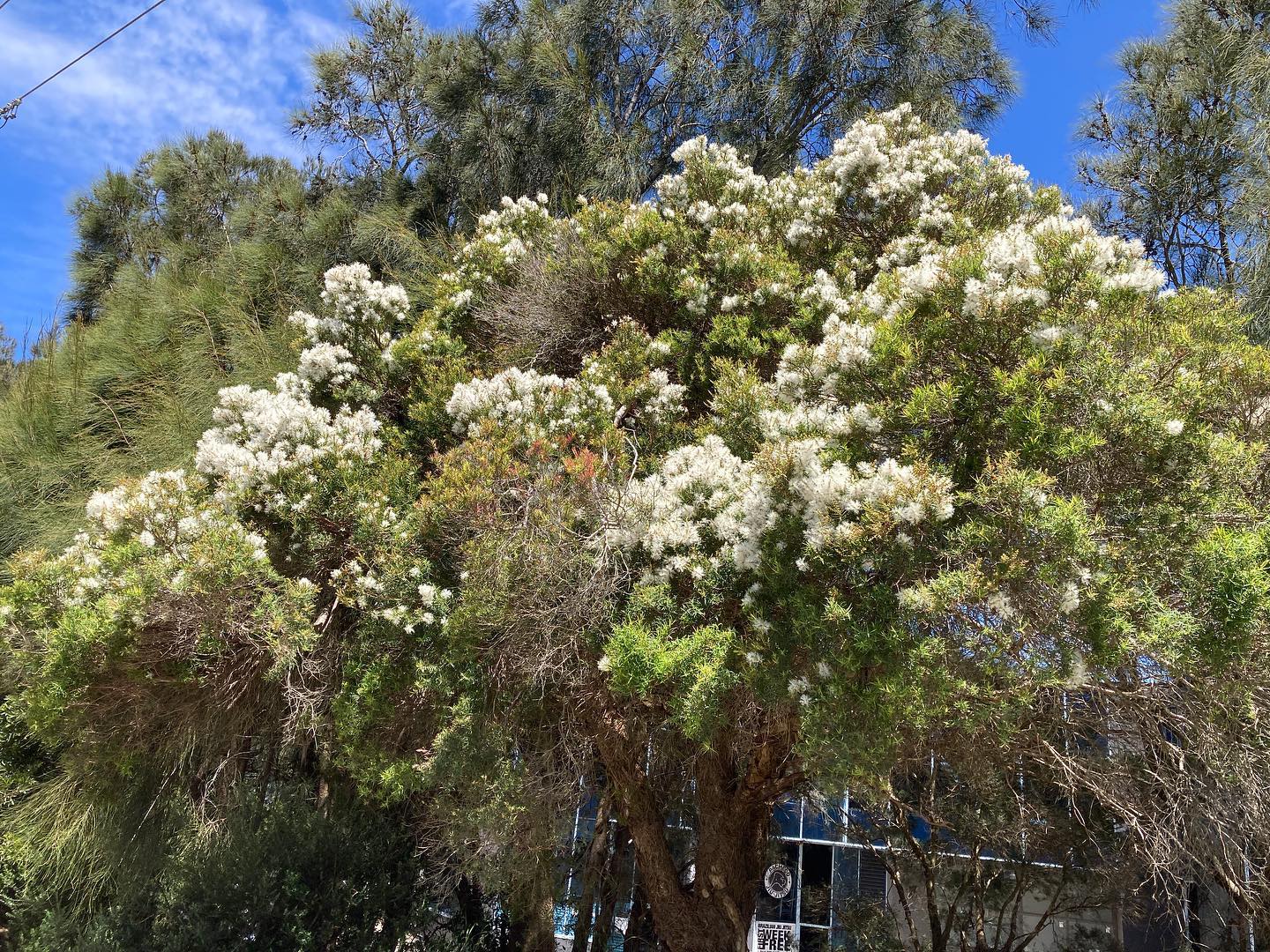
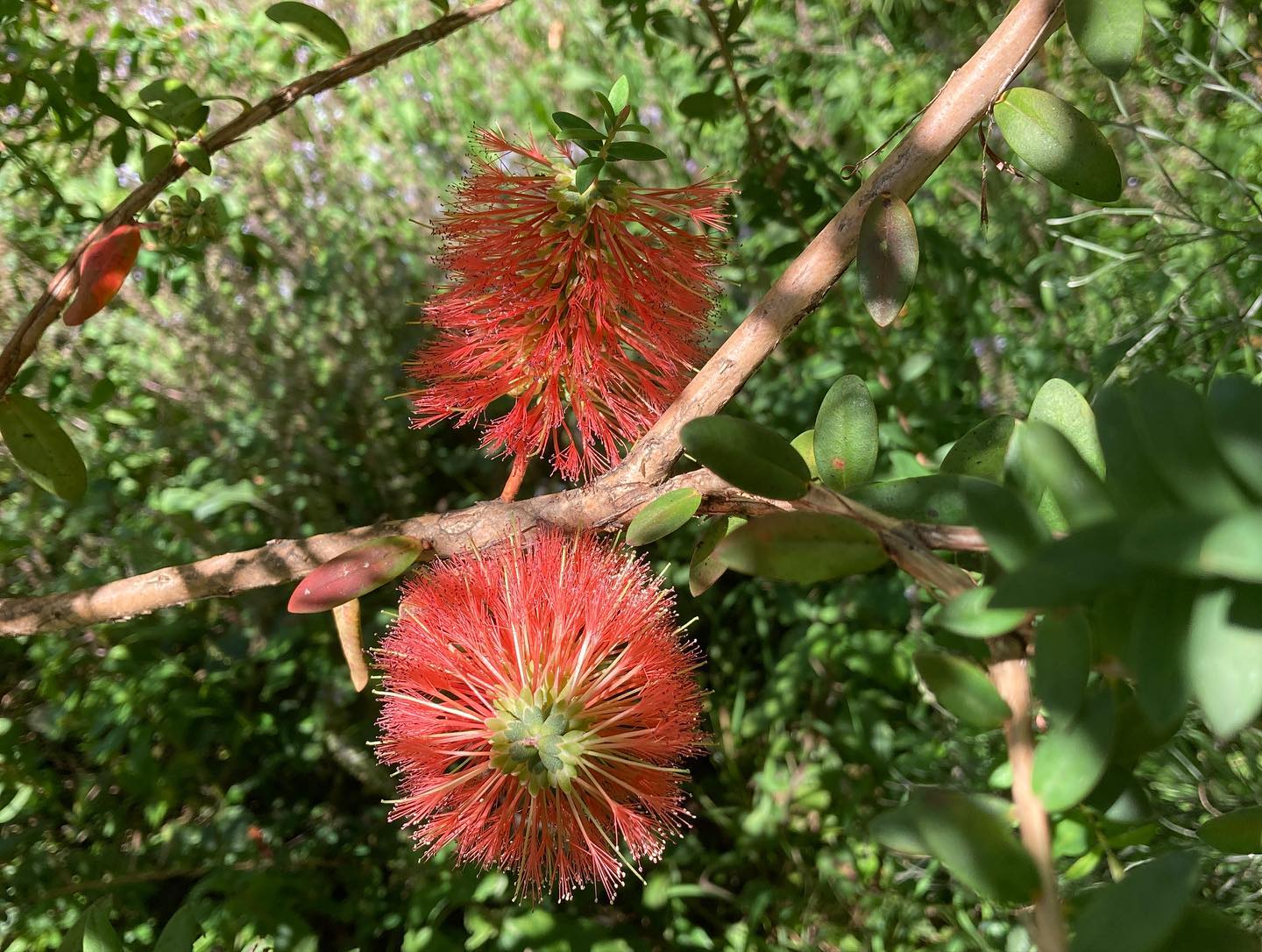
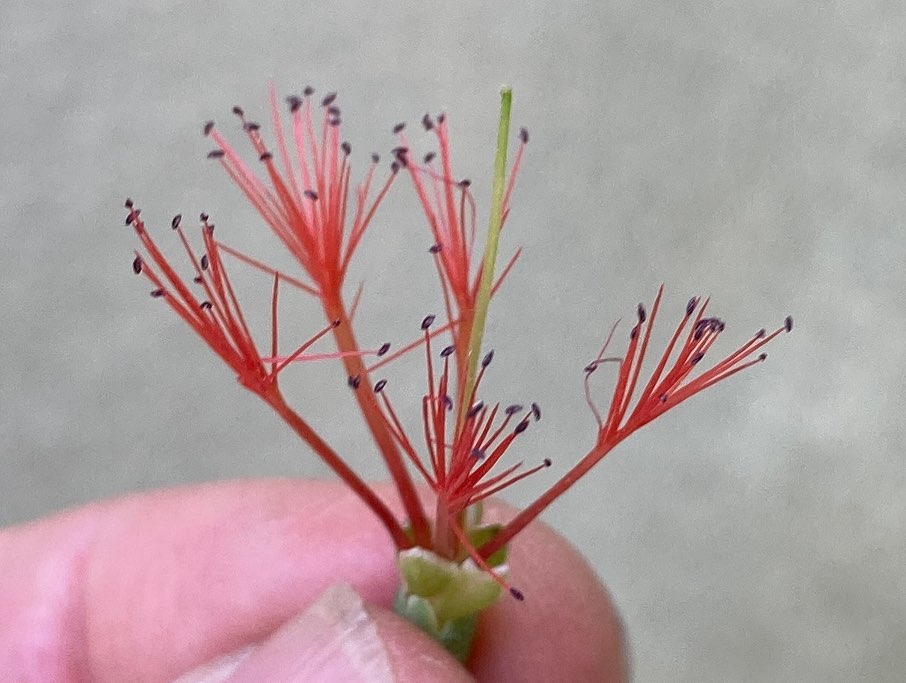
Also Flowering Now
PON staff photos
Misty Morning At Turimetta Beach
photos taken by Joe Mills, Monday November 14th, 2022
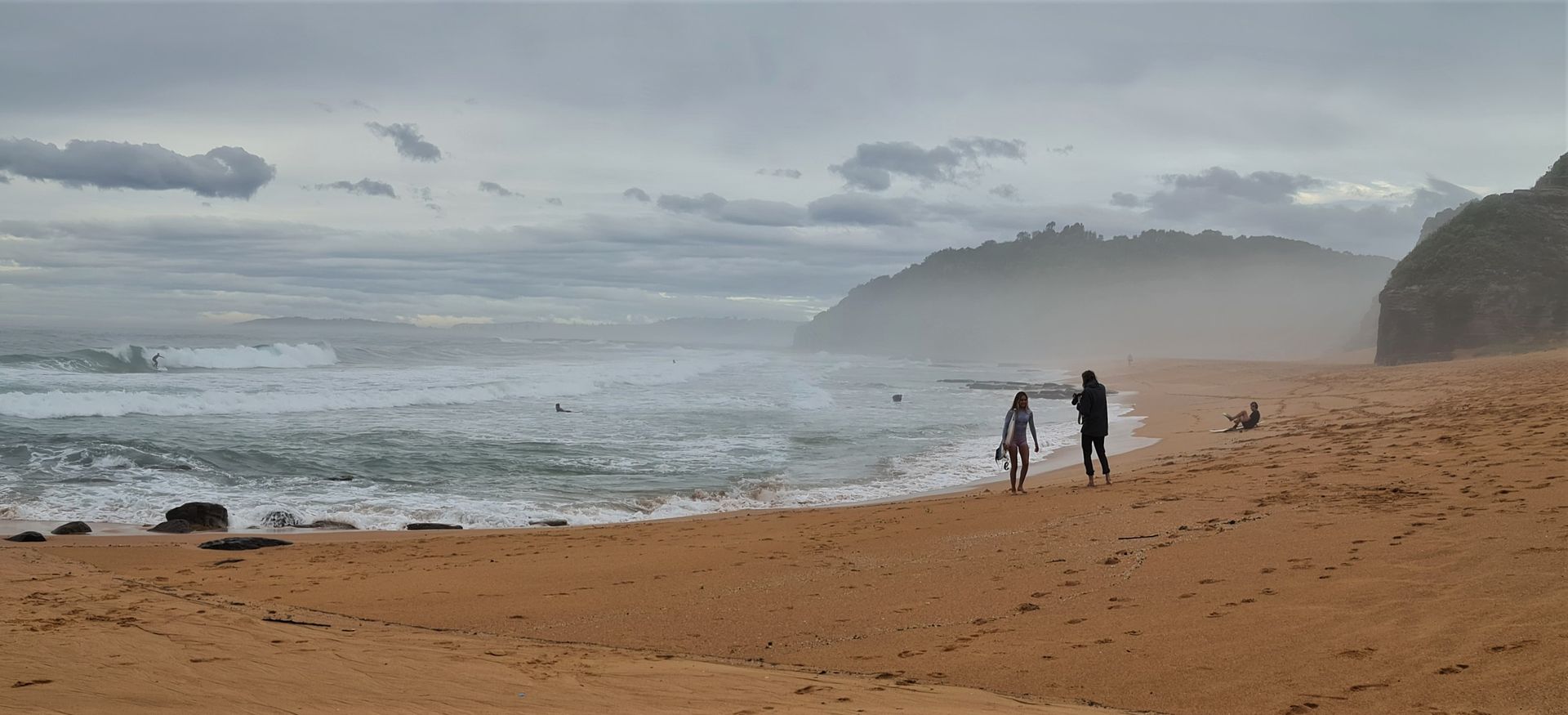
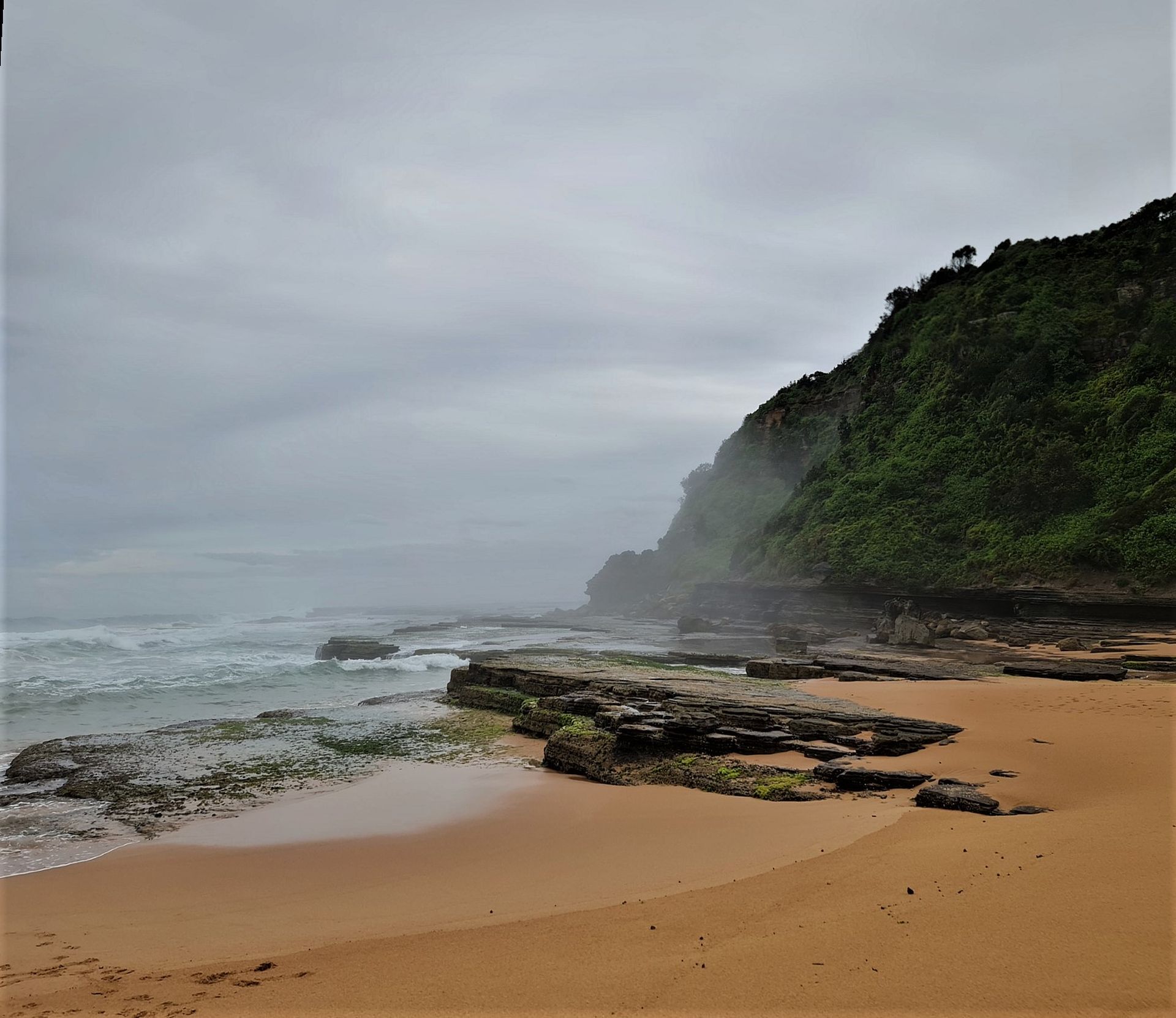
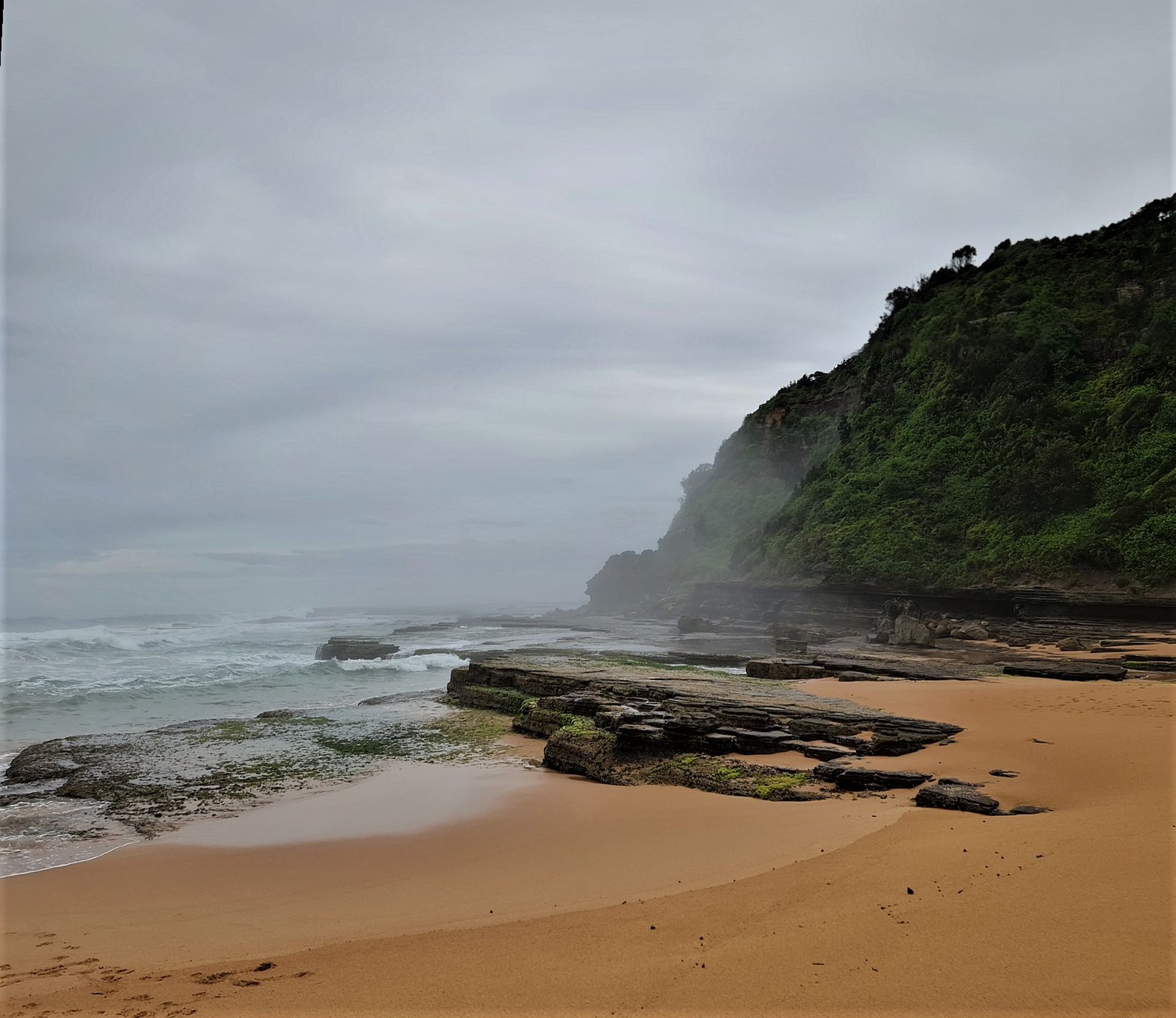
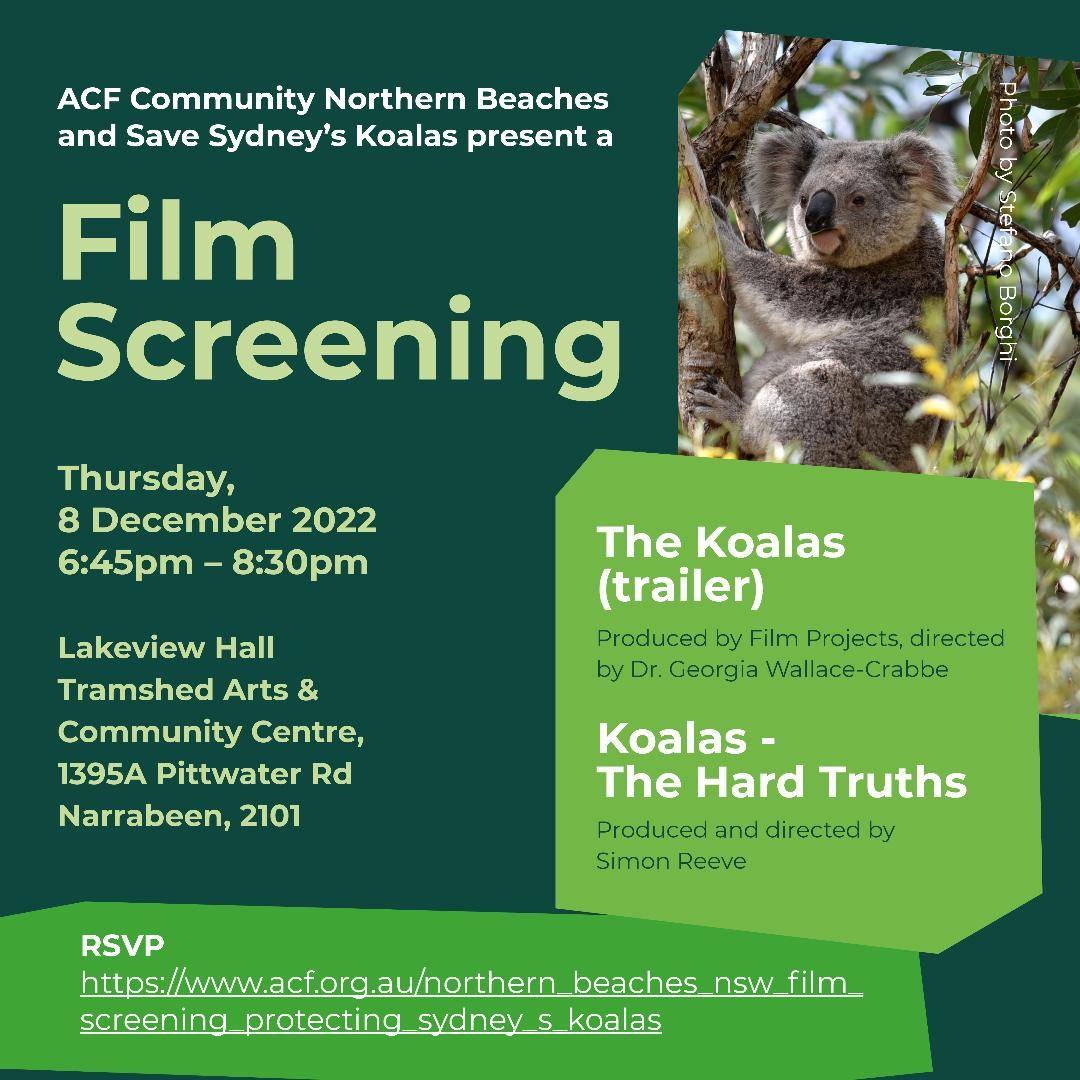
Gardening With Brush Turkeys: November 24 At Narrabeen - PNB End Of Year Event
THURSDAY, 24 NOVEMBER 2022 FROM 19:30-21:00
Hosted by Permaculture Northern Beaches
At: Tramshed Arts and Community Centre
Spring is well and truly here and so are the brush turkeys. We are very lucky to have turkey expert, Dr Ann Goeth, author of “Mound Builders”, deliver this month’s PNB talk. Ann will provide her unique insights into the life of brush turkeys and help us uncover fascinating facts about their foraging habits, breeding, and why they build such large mounds. She will also give tips on how to deal with them in the garden.
Come and see and hear a different side of one of our most common garden visitors.
This is our last meeting for the year for PNB and we will be celebrating all that has gone before us in 2022 and welcoming in 2023. If you would like to bring some snacks and non-alcoholic drinks to share with other members on the night for our end-of-year gathering.
Entry is by donation to help pay for room hire.
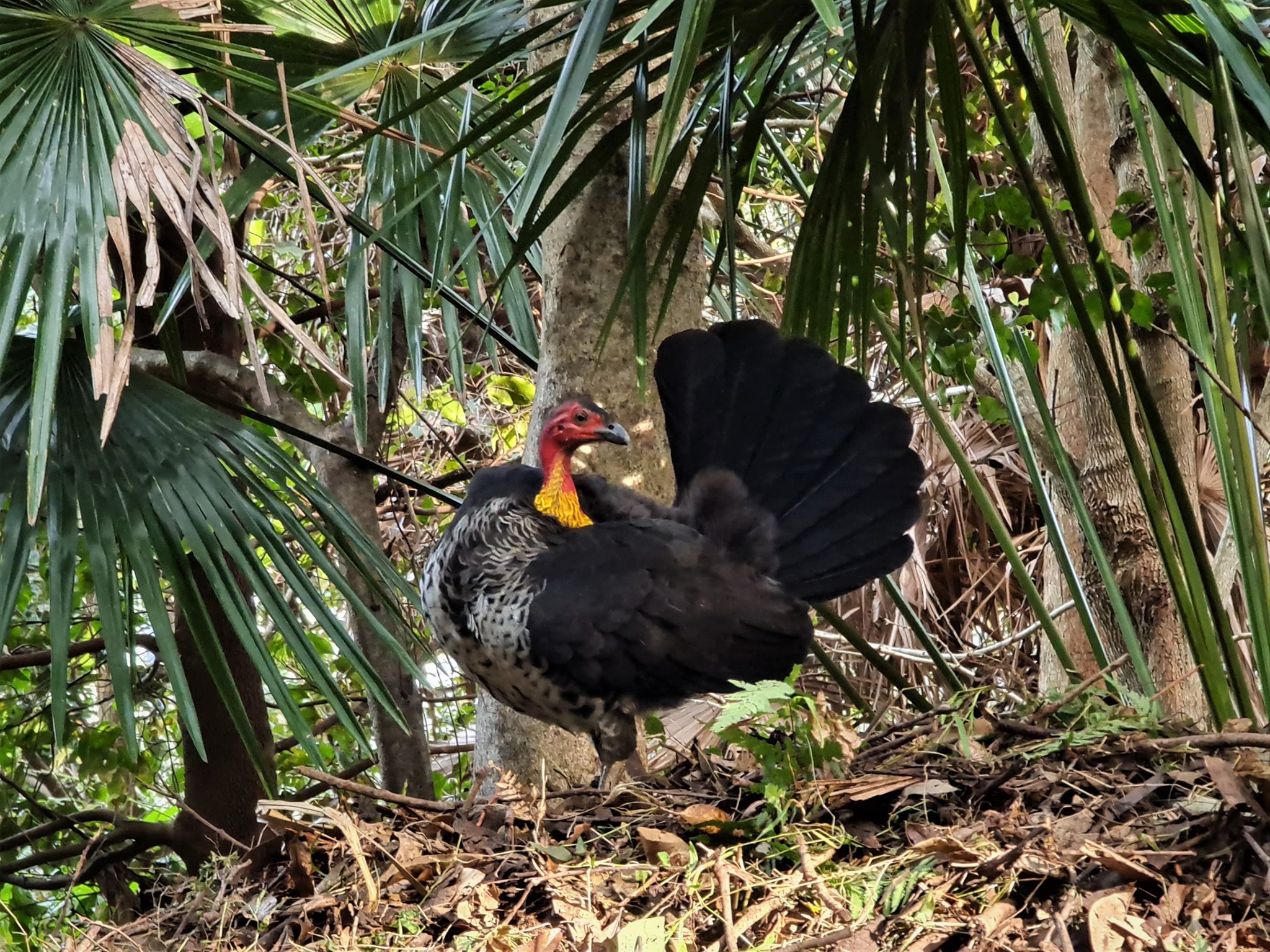
Photo: Joe Mills
Northern Beaches Clean Up Crew South Curl Curl Beach Clean Up: Sunday November 27
Northern Beaches Clean Up Crew, meets the last Sunday of every month at 10am on Sydney's northern beaches. We update our location every month. Come and join us for our South Curl Curl clean up. It will be our last clean up this year, because the last Sunday in December falls on Christmas Day. We'll meet in the grass area, close to the beach - see the map on our website or social media. For exact meeting point look at the map or type in "75 Carrington Parade, Curl Curl in NSW" - we'll be at opposite that address.
We have clean and washed gloves, bags and buckets. We'll clean up the surrounding area and the beach, to try and catch the litter before it hits the beach, trying to remove as much plastic, cigarette butts and rubbish as possible.
The ones in the crew that are certified wildlife rescuers will also look for an entangled seagull that has been reported needing help.
We're a friendly group of people and everyone is welcome to this family friendly event (just leave political, religious and business messages at home so everyone feel welcome). It's a nice community - make some new friends and do a good deed for the planet at the same time. Send us a message if you are lost - email or on our social media. Please invite family and friends and share this event.
We meet at 10am for a briefing. Then we generally clean between 60-90 minutes. After that, we sort and count the rubbish so we can contribute to litter research. We normally finish around 12.30 when we go to lunch together (at own cost). Please note, we completely understand if you cannot stay for the whole event. We are just grateful for any help we can get. No booking required. Just show up on the day. Looking forward to meeting you at South Curl Curl beach.
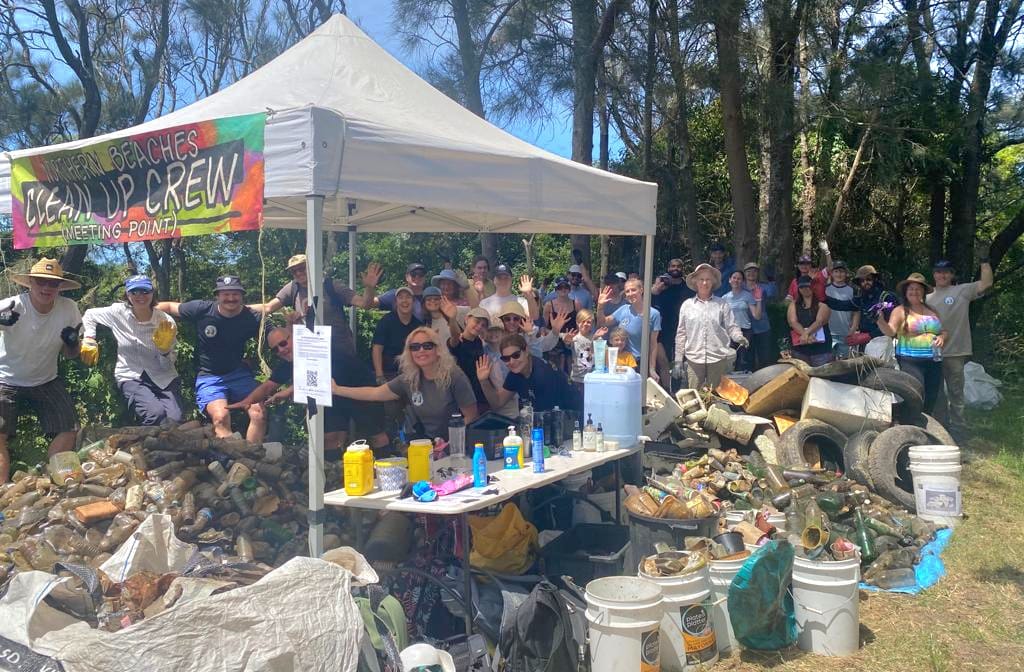
Help Needed To Save Sea Turtle Nests As Third La Nina Summer Looms
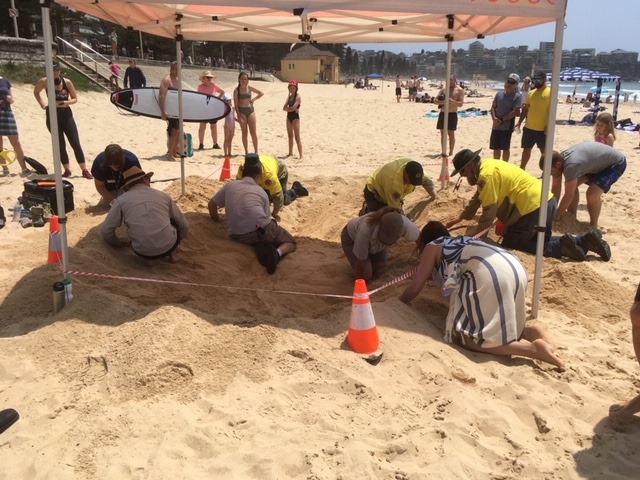

Watch Out - Shorebirds About
.JPG.opt1460x973o0,0s1460x973.jpg?timestamp=1663629195339)
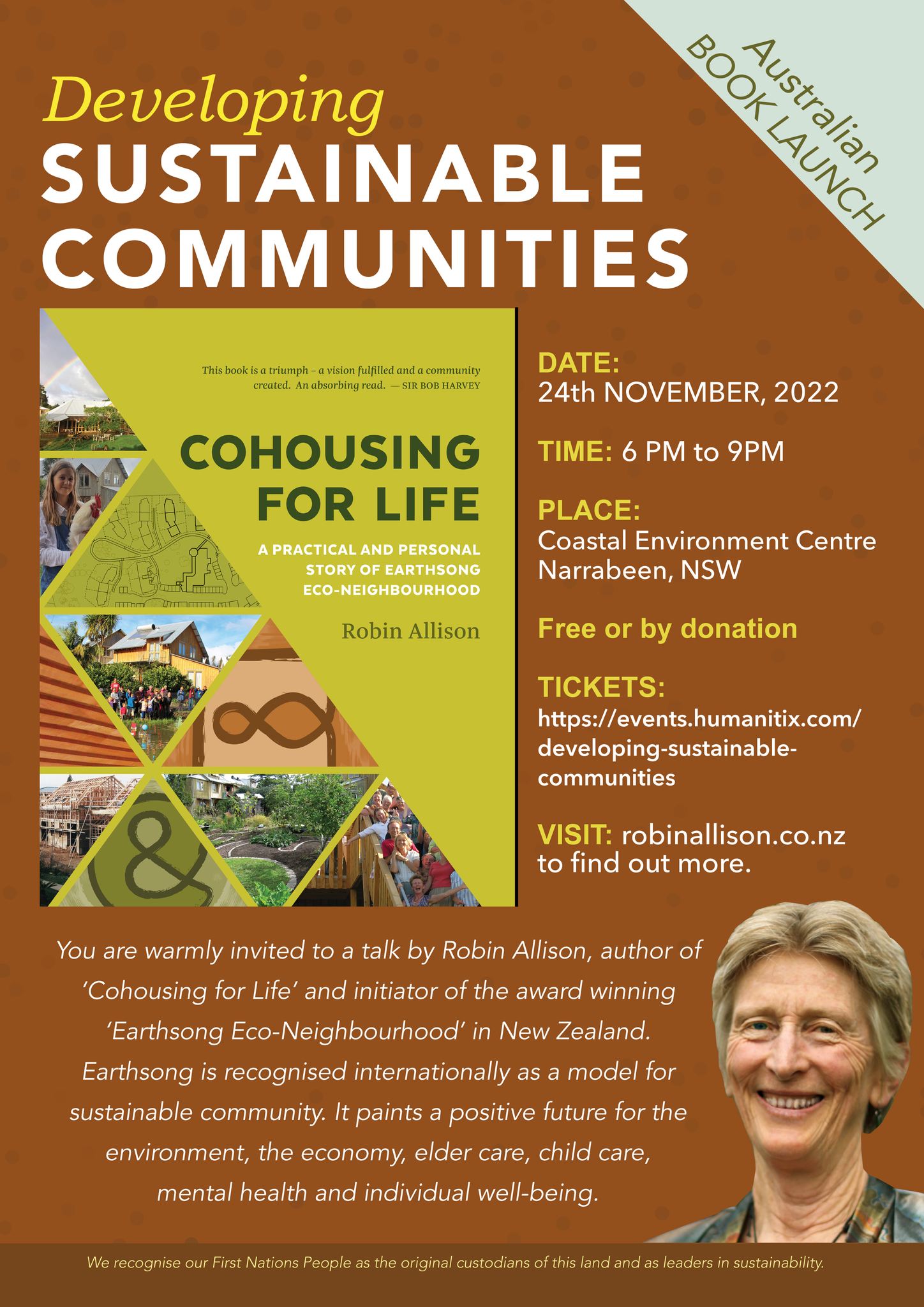
TALK & BOOK LAUNCH
Book Your Free Ticket To: Developing Sustainable Communities
Wanted: Photos Of Flies Feeding On Frogs (For Frog Conservation)
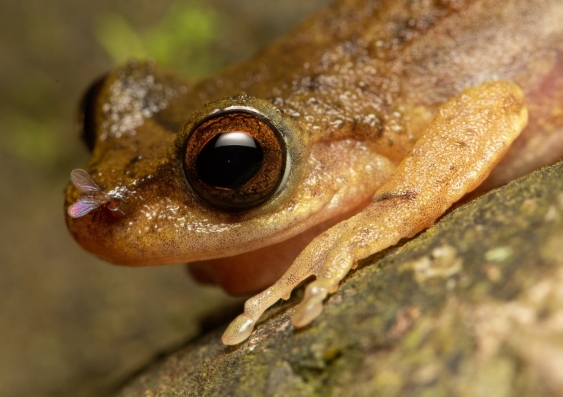
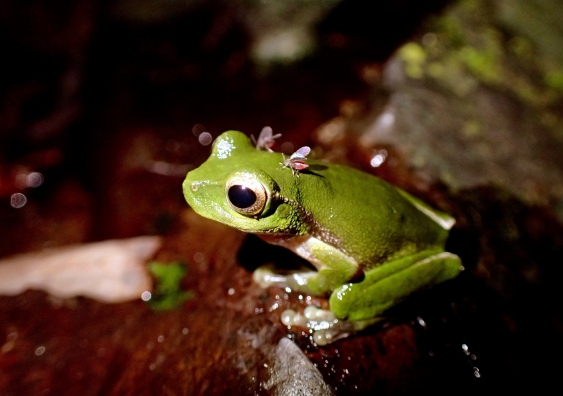
Possums In Your Roof?: Do The Right Thing

Local Wildlife Rescuers And Carers State That Ongoing Heavy Rains Are Tough For Us But Can Be Tougher For Our Wildlife:
- Birds and possums can be washed out of trees, or the tree comes down, nests can disintegrate or hollows fill with water
- Ground dwelling animals can be flooded out of their burrows or hiding places and they need to seek higher ground
- They are at risk crossing roads as people can't see them and sudden braking causes accidents
- The food may disappear - insects, seeds and pollens are washed away, nectar is diluted and animals can be starving
- They are vulnerable in open areas to predators, including our pets
- They can't dry out and may get hypothermia or pneumonia
- Animals may seek shelter in your home or garage.
You can help by:
- Keeping your pets indoors
- Assessing for wounds or parasites
- Putting out towels or shelters like boxes to provide a place to hide
- Drive to conditions and call a rescue group if you see an animal hit (or do a pouch check or get to a vet if you can stop)
- If you are concerned take a photo and talk to a rescue group or wildlife carer
There are 2 rescue groups in the Northern Beaches:
Sydney Wildlife: 9413 4300
WIRES: 1300 094 737
Please be patient as there could be a few enquiries regarding the wildlife.
Generally Sydney Wildlife do not recommend offering food but it may help in some cases. Please ensure you know what they generally eat and any offerings will not make them sick. You can read more on feeding wildlife here
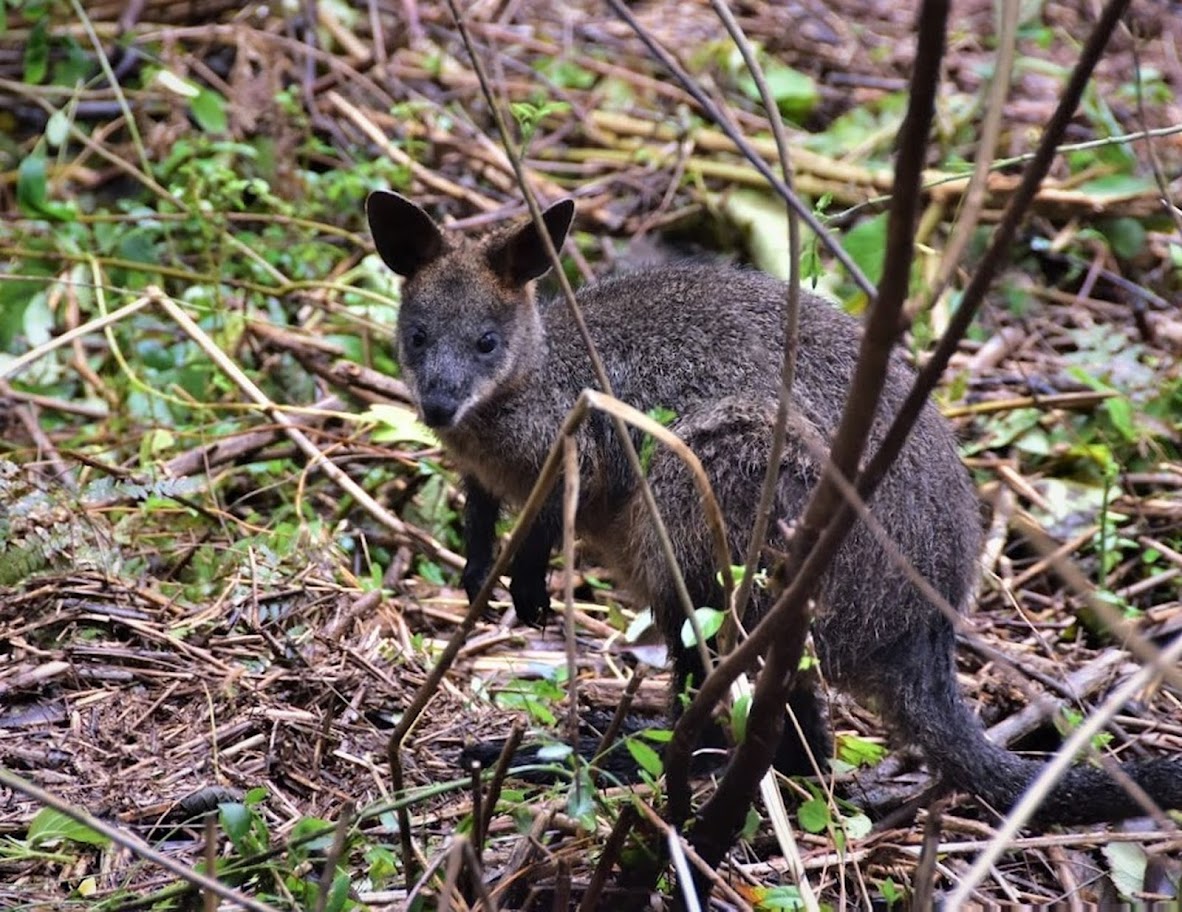
Information courtesy Ed Laginestra, Sydney Wildlife volunteer. Photo: Warriewood Wetlands Wallaby by Kevin Murray, March 2022.
Aviaries + Possum Release Sites Needed

Sydney Wildlife Rescue: Helpers Needed
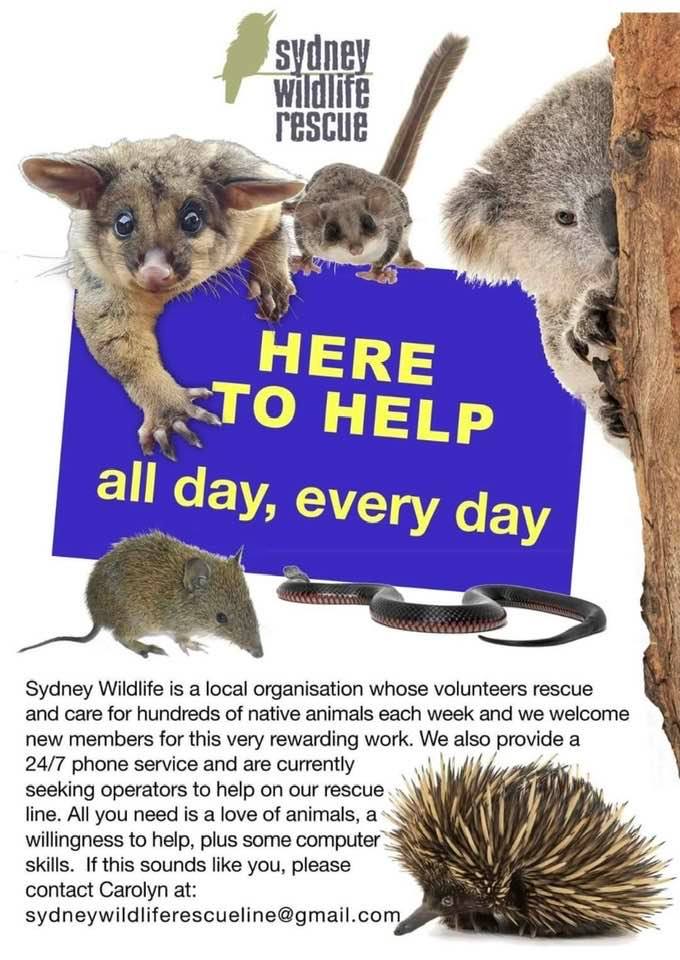
Bushcare In Pittwater
Where we work Which day What time
Avalon
Angophora Reserve 3rd Sunday 8:30 - 11:30am
Avalon Dunes 1st Sunday 8:30 - 11:30am
Avalon Golf Course 2nd Wednesday 3 - 5:30pm
Careel Creek 4th Saturday 8:30 - 11:30am
Toongari Reserve 3rd Saturday 9 - 12noon (8 - 11am in summer)
Bangalley Headland 2nd Sunday 9 to 12noon
Bayview
Winnererremy Bay 4th Sunday 9 to 12noon
Bilgola
North Bilgola Beach 3rd Monday 9 - 12noon
Algona Reserve 1st Saturday 9 - 12noon
Plateau Park 1st Friday 8:30 - 11:30am
Church Point
Browns Bay Reserve 1st Tuesday 9 - 12noon
McCarrs Creek Reserve Contact Bushcare Officer To be confirmed
Clareville
Old Wharf Reserve 3rd Saturday 8 - 11am
Elanora
Kundibah Reserve 4th Sunday 8:30 - 11:30am
Mona Vale
Mona Vale Beach Basin 1st Saturday 8 - 11am
Mona Vale Dunes 2nd Saturday +3rd Thursday 8:30 - 11:30am
Newport
Bungan Beach 4th Sunday 9 - 12noon
Crescent Reserve 3rd Sunday 9 - 12noon
North Newport Beach 4th Saturday 8:30 - 11:30am
Porter Reserve 2nd Saturday 8 - 11am
North Narrabeen
Irrawong Reserve 2nd Saturday 2 - 5pm
Palm Beach
North Palm Beach Dunes 3rd Saturday 9 - 12noon
Scotland Island
Catherine Park 2nd Sunday 10 - 12:30pm
Elizabeth Park 1st Saturday 9 - 12noon
Pathilda Reserve 3rd Saturday 9 - 12noon
Warriewood
Warriewood Wetlands 1st Sunday 8:30 - 11:30am
Whale Beach
Norma Park 1st Friday 9 - 12noon
Western Foreshores
Coopers Point, Elvina Bay 2nd Sunday 10 - 1pm
Rocky Point, Elvina Bay 1st Monday 9 - 12noon
Friends Of Narrabeen Lagoon Catchment Activities

Gardens And Environment Groups And Organisations In Pittwater
As New South Wales reels, many are asking why it’s flooding in places where it’s never flooded before
Mark Gibbs, Queensland University of TechnologyOn Monday, residents of Eugowra in New South Wales had to flee for their lives. They had only minutes to get to higher ground – or their rooftops – to escape what’s been dubbed an “inland tsunami” of water. This week, many other towns across western NSW faced renewed floods. For many people affected, the real shock is how unexpected it was – and how fast the water came. Their houses and land had never flooded, as far as they knew. What had changed?
This is an important question with a number of answers. When we make these assessments, we’re drawing on two sources: local knowledge and, increasingly, what flood maps tell us.
While tremendously useful, local knowledge has limits. Human memory is fallible and written records do not stretch back far. Flood maps also have constraints. That’s because floods can differ greatly depending on where the rain falls, at what intensity, and over what period of time. We will also have to redraw flood maps more often, as climate change brings more extreme weather. As climate change progresses, the atmosphere can hold more water. This supercharges atmospheric rivers – huge torrents of water carried above our heads.
The result? You might think you’re safe if you drew on local knowledge and flood maps when choosing where to live. The reality is there always have been gaps in our knowledge, and homes built on floodplains once thought safe may not be any more.
This doesn’t mean we should ignore credible sources of information. But it does mean we have to remember every information source has some uncertainty.
What Are The Limits Of Our Knowledge?
Local knowledge held by long-term residents, historical records and hearsay are tremendously useful sources.
But these only reach back a short way in terms of the history of flooding. Indigenous knowledge of flooding reaches back far further, with oral stories of the flooding of Port Phillip Bay and many other locations passed down over many generations.
Australia’s floodplains have periodically flooded for millennia, renewing ecosystems.
What’s new are the towns and cities built along their banks. Early European settlers were often taken by surprise by the size of the floods, and a number of rescues were undertaken by Indigenous peoples.
In our time, communities are increasingly turning to flood maps produced by local and state governments to take stock of their vulnerability. This is broadly a good thing, as these maps can drill down to which streets are more vulnerable.

But they aren’t perfect – and they’re mostly only updated every few years. Some councils are still relying on outdated maps.
Flood maps are generated from computer flood models and simulate how floods develop and spread. To do this, you need to consider a range of variables. How much rain falls? When? Where? For how long? Is the ground sodden already, or dry as a bone? What has changed in the catchment since the last flood modelling study that may alter the overland flows of water?
Rain doesn’t fall evenly across catchment areas. Intense rain can carpet some areas and leave others all but untouched. In the devastating 2011 floods in South East Queensland, huge volumes of rain fell in the upper catchment of the Brisbane River, across foothills of the Great Dividing Range. Flash floods hit communities like Toowoomba and Grantham hard, while bayside Brisbane was experiencing light rain and sunshine – and had more time to prepare.
Many of this year’s floods, by contrast, have come from heavy rain falling on lower catchment areas, with repeated soaking priming the area for near-instant floods. That’s partly why cities like Forbes have been taken by surprise, with the worst floods in decades.
In short, every intense or extreme rainfall event is different – and that, in turn, means the resulting floods can differ dramatically.
What Information Should We Rely On?
You can see the challenge for flood modellers. Which events do you model? You can’t model all of them, as it’s impractical to model all possible combinations of rainfall, location and so on. So you model the most likely combinations.
This is a major reason why major floods may not actually flood all of the houses in a designated flood zone in every flood, as it depends in part on where the rain is falling in the catchment.
In turn, this leads to confusion. People in affected communities may believe the flood models and warnings are wrong.
It’s been long understood this kind of information can be complicated and confusing for the people relying on it. Does the Annual Exceedance Probability mean the chance of a 1 in 100 year flood, or not? And if so, how can it flood twice in quick succession? There’s jargon galore.
When vital information is hard to understand, many people may give up and ignore the information. Others may make decisions based on their own interpretation or with social media.
It is hard to sift through complex information. We will need to continue to find ways to make clearer the likely risk for prospective home-owners as well as the danger from the more severe floods we can expect as the world warms.
For now, we need to stay as vigilant as possible on flood risk when choosing where to live. And we need to heed official warnings issued months ahead as seasonal outlooks as well as in the lead up to major rains. It hasn’t flooded here before? Unfortunately, it may be more accurate to say it hasn’t flooded here yet. ![]()
Mark Gibbs, Adjunct Professor, Queensland University of Technology
This article is republished from The Conversation under a Creative Commons license. Read the original article.
To stop new viruses jumping across to humans, we must protect and restore bat habitat. Here’s why
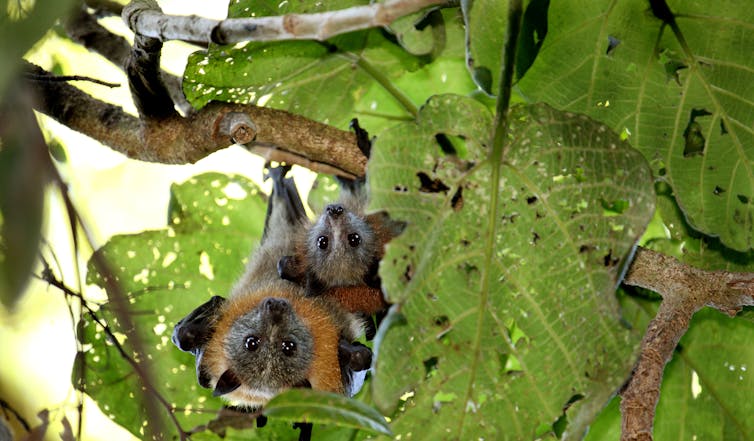
Bats have lived with coronaviruses for millennia. Details are still hazy about how one of these viruses evolved into SARS-CoV-2, which causes COVID in humans. Did it go directly from bats to humans or via another animal species? When? And why? If we can’t answer these questions for this now-infamous virus, we have little hope of preventing the next pandemic.
Some bat species are hosts for other viruses lethal to humans, from rabies to Nipah to Hendra. But their supercharged immune systems allow them to co-exist with these viruses without appearing sick.
So what can we do to prevent these viruses emerging in the first place? We found one surprisingly simple answer in our new research on flying foxes in Australia: protect and restore native bat habitat to boost natural protection.
When we destroy native forests, we force nectar-eating flying foxes into survival mode. They shift from primarily nomadic animals following eucalypt flowering and forming large roosts to less mobile animals living in a large number of small roosts near agricultural land where they may come in contact with horses.
Hendra virus is carried by bats and can spill over to horses. It doesn’t often spread from horses to humans, but when it does, it’s extremely dangerous. Two-thirds of Hendra cases in horses have occurred in heavily cleared areas of northern New South Wales and south-east Queensland. That’s not a coincidence.
Now we know how habitat destruction and spillover are linked, we can act. Protecting the eucalyptus species flying foxes rely on will reduce the risk of the virus spreading to horses and then humans. The data we gathered also makes it possible to predict times of heightened Hendra virus risk – up to two years in advance.
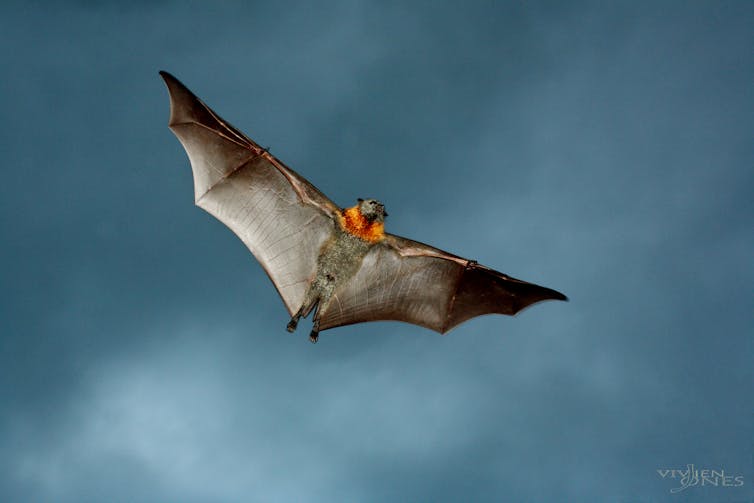
What Did We Find Out?
Many Australians are fond of flying foxes. Our largest flying mammal is often seen framed against summer night skies in cities.
These nectar-loving bats play a vital ecosystem role in pollinating Australia’s native trees. (Pollination in Australia isn’t limited to bees – flies, moths, birds and bats do it as well). Over winter, they rely on nectar from a few tree species such as forest red gums (Eucalyptus tereticornis) found mostly in southeast Queensland and northeast NSW. Unfortunately, most of this habitat has been cleared for agriculture or towns.
Flying foxes are typically nomadic, flying vast distances across the landscape. When eucalypts burst into flower in specific areas, these bats will descend on the abundant food and congregate in lively roosts, often over 100,000 strong.
But Australia is a harsh land. During the severe droughts brought by El Niño, eucalyptus trees may stop producing nectar. To survive, flying foxes must change their behaviour. Gone are the large roosts. Instead, bats spread in many directions, seeking other food sources, like introduced fruits. This response typically only lasts a few weeks. When eucalypt flowering resumes, the bats come back to again feed in native forests.
But what happens if there are not enough forests to come back to?
Between 1996 and 2020, we found large winter roosts of nomadic bats in southeast Queensland became increasingly rare. Instead, flying foxes were forming small roosts in rural areas they would normally have ignored and feeding on introduced plants like privet, camphor laurel and citrus fruit. This has brought them into closer contact with horses.
In related research published last month, we found the smaller roosts forming in these rural areas also had higher detection rates of Hendra virus – especially in winters after a climate-driven nectar shortage.
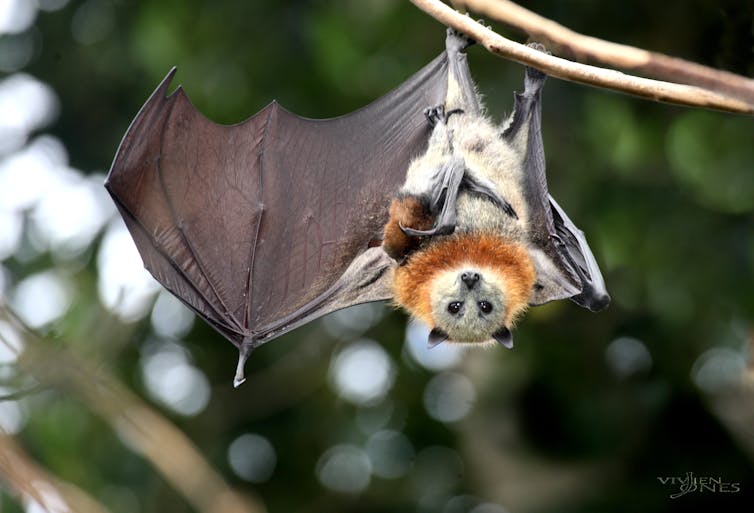
An Early Warning System For Hendra Virus
Our models confirmed strong El Niño events caused nectar shortages for flying foxes, splintering their large nomadic populations into many small populations in urban and agricultural areas.
Importantly, the models showed a strong link between food shortages and clusters of Hendra virus spillovers from these new roosts in the following year.
This means by tracking drought conditions and food shortages for flying foxes, we can get crucial early warning of riskier times for Hendra virus – up to two years in advance.
Biosecurity, veterinary health and human health authorities could use this information to warn horse owners of the risk. Horse owners can then ensure their horses are protected with the vaccine.
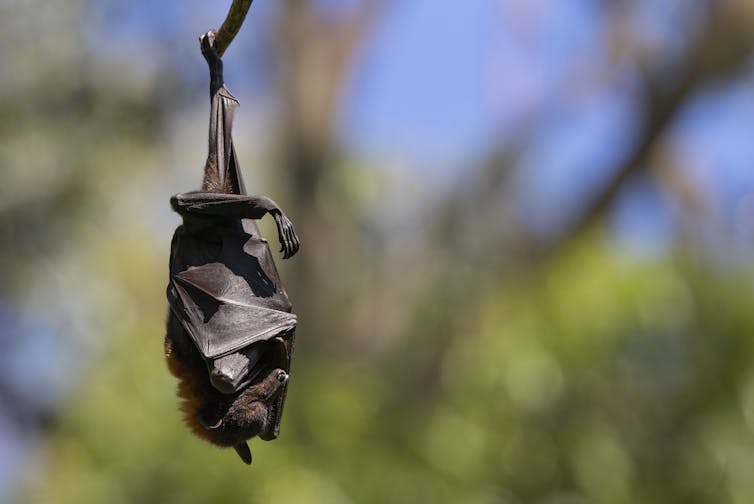
How Can We Stop The Virus Jumping Species?
Conservationists have long pointed out human health depends on a healthy environment. This is a very clear example. We found Hendra virus never jumped from flying foxes to horses when there was abundant winter nectar.
Protecting and restoring bat habitat and replanting key tree species well away from horse paddocks will boost bat health – and keep us safer.
Flying foxes leave roosts in cities or rural areas when there are abundant flowering gums elsewhere. It doesn’t take too long – trees planted today could start drawing bats within a decade.
SARS-CoV-2 won’t be the last bat virus to jump species and upend the world. As experts plan ways to better respond to next pandemic and work on human vaccines built on the equine Hendra vaccines, we can help too.
How? By restoring and protecting the natural barriers which for so long kept us safe from bat-borne viruses. It is far better to prevent viruses from spilling over in the first place than to scramble to stop a possible pandemic once it’s begun.
Planting trees can help stop dangerous new viruses reaching us. It really is as simple as that. ![]()
Alison Peel, Senior Research Fellow in Wildlife Disease Ecology, Griffith University; Peggy Eby, Adjunct Senior Lecturer, Centre for Ecosystem Science, UNSW Sydney, and Raina Plowright, Professor, Cornell University
This article is republished from The Conversation under a Creative Commons license. Read the original article.
New electric cars for under $45,000? They’re finally coming to Australia – but the battle isn’t over

If you’re shopping for an electric vehicle in Australia at the moment, your options are limited. Of more than 300 electric vehicle models on sale globally, only about 30 are available here.
What’s more, waiting lists for vehicles are long and the purchase cost is still higher than many consumers are willing to pay.
Australia might now have a federal government with stronger climate ambition than the last. But major new policies are still needed to accelerate the road transport transition.
There’s good news, however: Australian motorists have been promised more choice soon. So let’s take a look at the cars we might be driving in the next few years.

Why Make The Switch?
Transport is Australia’s third-largest – and fastest growing – source of greenhouse gas emissions. Cars are responsible for the greatest share of these emissions.
Most of Australia’s vehicle fleet uses polluting fossil fuels. A switch to electric vehicles, coupled with a transition to renewable energy, is vital if Australia is to meet its commitments to tackle climate change.
Electric vehicles are also cheaper to run than their traditional counterparts, and don’t rely on expensive imported fuel.
Despite all the benefits, electric vehicle uptake in Australia is still low. They accounted for just 3.39% of new vehicle sales (or 26,356 cars in total) to September this year, according to the Electric Vehicle Council of Australia.
It’s an increase on last year, but still well below other nations. In the UK, for example, 19% of new cars sold are electric.
The ACT buys the most electric vehicles (9.5% of new vehicles) followed by New South Wales (3.7%), Victoria (3.4%), Queensland (3.3%), Tasmania (3.3%), Western Australia (2.8%), South Australia (2.3%) and the Northern Territory (0.8%).

Which Electric Vehicles Are We Buying?
Almost 40% of new battery electric vehicle sales this year were Tesla Model 3 (8,647 sales) and 25% were Tesla Model Y (5,376 sales). Other top-selling models include the Hyundai Kona (897 sales), MG ZS EV (858 sales) and Polestar 2 (779 sales).
Less than 20% of vehicles sold had a purchase price below $65,000.
The Porsche Taycan, one of the most expensive electric vehicles on the market, was in 11th place with 401 sales. Its price ranges from $156,000 to more than $350,000, depending on the model grade.
Some buyers are yet to receive the cars they purchased. Supply shortages mean consumers can wait 11 months for their vehicle.
But despite the frequent delays, consumers keep placing orders. Hyundai recently offered 200 of its Ioniq 5 electric SUVs for sale online; they were snapped up within 15 minutes.
Price Is A Sticking Point
Clearly, some Australians are willing to buy an electric vehicle despite the price tag. But the purchase cost remains a big concern for others.
In a recent survey, more than half of Australian respondents preferred electric vehicles over fossil fuel cars – but 67% said price was the main barrier preventing them from making the switch.
Only 13% were willing to spend between $45,000 and $54,999 on an electric car.
In another survey of around 1,000 Australians, about 72% said they would budget less than $40,000 for their next car purchase.
But few battery electric vehicles cost less than $55,000, and many cost more than twice this. Others are nearly 60% more expensive than their petrol-powered counterparts.

Choice Coming Soon
Carmakers have promised a suite of new battery electric vehicles will soon be available in Australia.
Two are expected to be the among the cheapest new battery electric vehicles available here: the Atto 3 by carmaker BYD and MG’s updated ZS compact SUV.
Both will be available for less than $50,000 including on-road costs. The MG model is the cheaper of the two, at $44,990 for the Excite variant.
Other models expected to arrive in the next two years include the Aiways U5 SUV, Fiat 500e, Kia Soul, Peugeot e-2008, Skoda Enyaq, Toyota bZ4x and Volkswagen ID series.
The Chinese LDV electric ute is already on sale in New Zealand and may be on Australian roads by the end of this year. It remains to be seen, however, if electric utes and vans will be embraced by Australia’s tradespeople.
What Policy Settings Are Needed?
Clearly, Australia needs more affordable mid- and low-end electric vehicles. But one key policy setting is holding us back: the lack of mandatory fuel efficiency standards for road transport vehicles.
Australia is the only country in the OECD without such a policy. The standards help drive demand for low-emissions vehicles – so electric vehicle manufacturers often prefer to sell into those markets.
Car importers also tend to promote top-end models first because they have higher profit margins.
Meanwhile globally, competition between manufacturers of cheaper battery electric vehicles is expected to intensifying. Multinational automakers in China have been gearing up. Their lineup of new models is already selling in international markets.
Heavy trucks are also ripe for electrification, and progress has been rapid in recent years. Broad deployment in Australia will accelerate emissions cuts and improve air quality.
The Road Ahead
Electric vehicles are not the total solution to cutting transport emissions. We also need strategies to change our travel behaviour, reduce the number of cars on the roads and improve walkability and access to public transport.
But electric vehicles are a crucial piece of the puzzle. To improve their uptake in Australia, policymakers can draw from a range of effective electric vehicle policies that can be adapted from other nations. They include investment in charging stations and providing financial incentives to buy and run electric vehicles.
Australians want to drive electric vehicles, and governments must respond. Without a variety of affordable electric vehicles, Australia’s dependence on fossil fuels will deepen, and reaching our emissions reduction goals will become harder.![]()
Hussein Dia, Professor of Future Urban Mobility, Swinburne University of Technology
This article is republished from The Conversation under a Creative Commons license. Read the original article.
REDcycle’s collapse is more proof that plastic recycling is a broken system
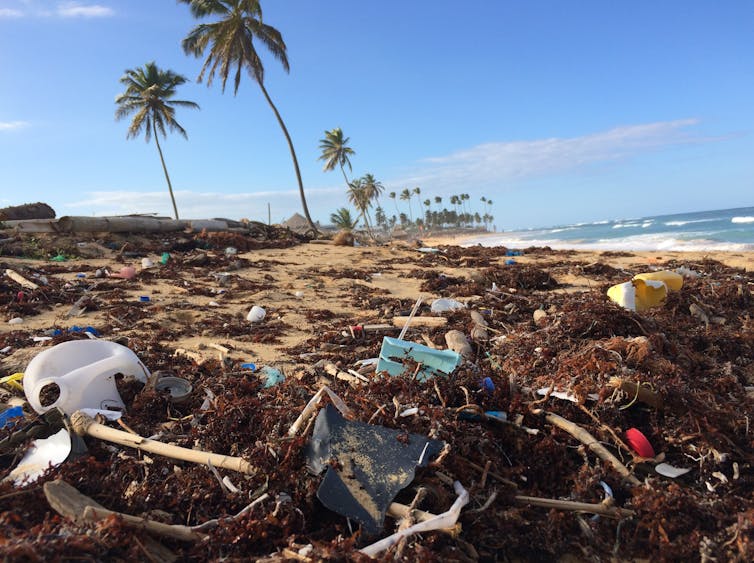
This week the federal government joined an international agreement to recycle or reuse 100% of plastic waste by 2040, putting an end to plastic pollution. But major obstacles stand in the way.
The most recent is the collapse of Australia’s largest soft plastic recycling program, REDcycle. The program was suspended after it was revealed soft plastic items collected at Woolworths and Coles had been stockpiled for months in warehouses and not recycled.
The abrupt halt to the soft plastics recycling scheme has left many consumers deeply disappointed, and the sense of betrayal is understandable. Recycling, with its familiar “chasing arrows” symbol, has been portrayed by the plastics industry as the answer to the single-use plastics problem for years.
But recycling is not a silver bullet. Most single-use plastics produced worldwide since the 1970s have ended up in landfills and the natural environment. Plastics can also be found in the food we eat, and at the bottom of the deepest oceans.
The recent collapse of the soft plastics recycling scheme is further proof that plastic recycling is a broken system. Australia cannot achieve its new target if the focus is on the collection, recycling and disposal alone. Systemic change is urgently needed.
Recycling Is A Market
Australia has joined the High Ambition Coalition to End Plastic Pollution, a group of more than 30 countries co-led by Norway and Rwanda, and also including the United Kingdom, Canada and France.
It aims to deliver a global treaty banning plastic pollution by setting global rules and obligations for the full life cycle of plastic. This includes setting standards to reduce plastic production, consumption and waste. It would also enable a circular economy, where plastic is reduced, reused or recycled.
The idea behind recycling is simple. By reprocessing items into new products, we can conserve natural resources and reduce pollution.
Unfortunately, the recycling process is much more complex and entwined in the economic system. Recycling is a commodities market. Who buys what is usually determined by the quality of the plastic.
Sitting in the middle of the chasing arrow symbol is a number. If it’s a one or a two, it’s high value and will most likely be sold on the commodities market and recycled. Numbers three to seven indicate mixed plastics, such as soft plastics, which are considered low value.
Sadly, it often costs more to recycle most plastics than to just throw them away. Up until 2018, low value plastics were exported to China. The reliance on the global waste trade for decades precluded many countries, including Australia, from developing advanced domestic recycling infrastructure.
What Are The Biggest Problems?
One of the biggest problems with plastics recycling is the massive diversity of plastics that end up in the waste stream – foils, foams, sachets, numerous varieties of flexible plastic, and different additives that further alter plastic properties.
Most plastics can only be recycled in pure and consistent form, and only a limited number of times. What’s more, municipal plastic waste streams are very difficult to sort.
Achieving high levels of recycling in the current system requires the mixed plastic waste stream to be sorted into hundreds of different parts. This is unrealistic and particularly challenging for remote, low-income communities, which are typically far away from a recycling facility.
For example, throughout the developing world, single-use “sachet” size products are often directed towards low socio-economic communities and low-income families, who may buy most of their food in small daily portions.
Waste from small single-use packaging is notoriously difficult to recycle and is particularly prevalent in remote and rural communities which have less sophisticated waste management infrastructure.
Furthermore, high transportation costs associated with shipping plastic waste to a reprocessing facility make recycling a difficult issue for remote communities everywhere, including Outback Australia.
Failing Corporate Responsibility
Worldwide production and consumption of plastic per capita continues to increase, and is expected to triple by 2060. For many consumer-packaged goods companies, recycling remains the dominant narrative in addressing the issue.
For example, a study this year examined how companies in the food and beverage sector address plastic packaging as part of their wider, pro-active, sustainability agenda. It found the sector’s transition to sustainable packaging is “slow and inconsistent”, and in their corporate sustainability reports most companies focus on recyclable content and post-consumer initiatives rather than solutions at the source.
Although producer responsibility is growing, most companies in the fast-moving consumer goods sector are doing very little to reduce single-use plastic packaging. Special consideration should be given to products sold in regions lacking waste management infrastructure, such as in emerging economies.

Like A Band Aid On A Bullet Wound
The Australian government’s new goal to end plastic pollution by 2040 is encouraging to see. But putting the onus on recycling, consumer behaviour, and post-consumer “quick fix” solutions will only perpetuate the problem.
In the context of the global plastic crisis, focusing on recycled content is like putting a band aid on a bullet wound. We need better and more innovative solutions to turn off the plastic tap. This includes stronger legislation to address plastic waste and promote sustainable packaging.
One such approach is to establish “extended producer responsibility” (EPR). This involves laws and regulations requiring plastics producers and manufacturers to pay for the recycling and disposal of their products.
For example, in 2021, Maine became the first US state to adopt an EPR law for plastic packaging. Maine’s EPR policy shifts recycling costs from taxpayers and local government to packaging producers and manufacturers. Companies that want to sell products in plastic packaging must pay a fee based on their packaging choices and provide easily recyclable product options.
Currently, the burden of managing plastic disposal typically lies with local councils and municipalities. As a result, many municipalities worldwide are championing EPR schemes.
It’s the responsibility of everyone in the value chain to limit the use of single-use plastic and provide sustainable packaging alternatives for consumers. We need better product design and prevention through legislation.
The exciting thing is that businesses transitioning towards a more sustainable way of producing, distributing, and re-using goods are more likely to improve their competitive position.![]()
Anya Phelan, Lecturer, The University of Queensland
This article is republished from The Conversation under a Creative Commons license. Read the original article.
Climate change will clearly disrupt El Niño and La Niña this decade – 40 years earlier than we thought

You’ve probably heard a lot about La Niña lately. This cool weather pattern is the main driver of heavy rain and flooding that has devastated much of Australia’s southeast in recent months.
You may also have heard of El Niño, which alternates with La Niña every few years. El Niño typically brings drier conditions to much of Australia.
Together, the two phases are known as the El Niño-Southern Oscillation – the strongest and most consequential factor driving Earth’s weather. And in recent years there has been much scientific interest in how climate change will influence this global weather-maker.
Our new research, released today, sheds light on the question. It found climate change will clearly influence the El Niño-Southern Oscillation by 2030 – in just eight years’ time. This has big implications for how Australians prepare for extreme weather events.
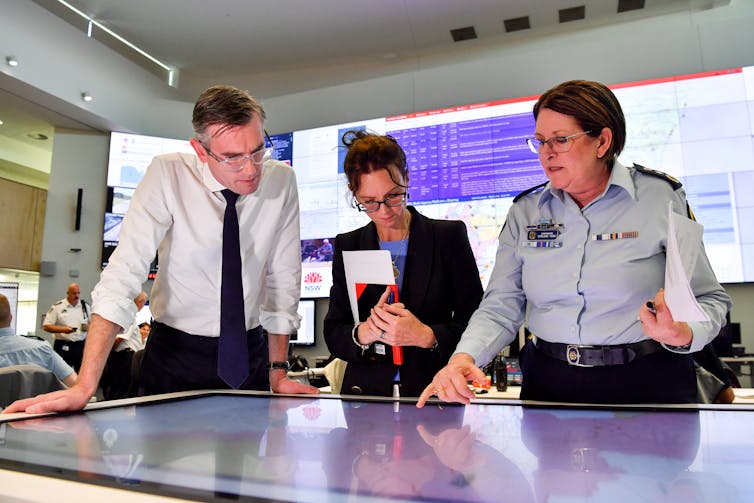
A Complex Weather Puzzle
The El Niño-Southern Oscillation occurs across the tropical Pacific, and involves complex interplays between the atmosphere and the ocean. It can be in one of three phases: El Niño, La Niña or neutral.
During an El Niño phase, the central and eastern tropical Pacific Ocean warms significantly. This causes a major shift in cloud formation and weather patterns across the Pacific, typically leading to dry conditions in eastern Australia.
During a La Niña phase, which is occurring now, waters in the central and eastern tropical Pacific Ocean are cooler than average. The associated changes in weather patterns include higher than average rainfall over much of Australia.
When the oscillation is in the neutral phase, weather conditions hover around the long-term average.
Previous research has suggested El Niño and La Niña events may vary depending on where in the tropical Pacific the warm or cold ocean temperatures are located.
But climate change is also affecting ocean temperatures. So how might this play into El Niño and La Niña events? And where might the resulting change in weather patterns be detected? These are the questions our research sought to answer.
What We Found
We examined 70 years of data on the El Niño–Southern Oscillation since 1950, and combined it with 58 of the most advanced climate models available.
We found the influence of climate change on El Niño and La Niña events, in the form of ocean surface temperature changes in the eastern Pacific, will be detectable by 2030. This is four decades earlier than previously thought.
Scientists already knew climate change was affecting the El Niño–Southern Oscillation. But because the oscillation is itself so complex and variable, it’s been hard to identify where the change is occurring most strongly.
However, our study shows the effect of climate change, manifesting as changes in ocean surface temperature in the tropical eastern Pacific, will be obvious and unambiguous within about eight years.
So what does all this mean for Australia? Warming of the eastern Pacific Ocean, fuelled by climate change, will cause stronger El Niño events. When this happens, rain bands are drawn away from the western Pacific where Australia is located. That’s likely to mean more droughts and dry conditions in Australia.
It’s also likely to bring more rain to the eastern Pacific, which spans the Pacific coast of Central America from southern Mexico to northern Peru.
Strong El Niño events are often followed by strong and prolonged La Niñas. So that will mean cooling of the eastern Pacific Ocean, bringing the rain band back towards Australia – potentially leading to more heavy rain and flooding of the kind we’ve seen in recent months.

What Now?
Weather associated with El Niño and La Niña has huge implications. It can affect human health, food production, energy and water supply, and economies around the world.
Our research suggests Australians, in particular, must prepare for more floods and droughts as climate change disrupts the natural weather patterns of the El Niño-Southern Oscillation.
Our findings should be incorporated into policies and strategies to adapt to climate change. And crucially, they add to the weight of evidence pointing to the urgent need to reduce greenhouse gas emissions to stabilise Earth’s climate.![]()
Wenju Cai, Chief Research Scientist, Oceans and Atmosphere, CSIRO, CSIRO
This article is republished from The Conversation under a Creative Commons license. Read the original article.
Urban planning is now on the front line of the climate crisis. This is what it means for our cities and towns
Barbara Norman, University of CanberraInternational climate talks in Egypt known as COP27 are into their second week. Thursday is Solutions Day at the summit. Recognising that urban planning is now a front-line response to climate change, discussions will focus on sustainable cities and transport, green buildings and resilient infrastructure.
The COP26 Glasgow Pact expects countries to update planning at all levels of government to take climate change and adaptations into account. Urban planning is also included in the most recent report by the Intergovernmental Panel on Climate Change (IPCC).
The Australian Royal Commission into National Natural Disaster Arrangements similarly reinforced the urgency of planning for climate change. Its report recommended making it mandatory for land-use planning decisions to consider natural disaster risks.
Australian communities have been through a series of recent disasters. We have had extremes of drought, bushfires and now storms and floods. Some towns have been evacuated repeatedly.
Land-use planning needs to be updated to respond to a changing climate. This means working with nature, involving communities and, importantly, including the tools needed to plan for risk and uncertainty. Examples include scenario planning, carbon assessments of developments, water-sensitive urban design and factoring in the latest climate science into everyday decisions on land use.
We Can’t Avoid The Issue Of Resettlement
Climate-driven resettlement, in my view, will be one of the most significant social challenges of this century. The IPCC estimates that “3.3 to 3.6 billion people live in contexts that are highly vulnerable to climate change […] unsustainable development patterns are increasing exposure of ecosystems and people to climate hazards”.
The costs are staggering. The OECD estimates, for example, that in the past two decades alone, the cost of storms reached US$1.4 trillion globally.
In my review of recent climate-induced resettlement around the world, two important lessons are:
it must actively involve the community
it takes time.
The relocation of houses in Grantham, Queensland, is a positive example of resettlement. The repeated floods across eastern Australia – and the Black Summer bushfires of 2019-20 – show why a national conversation with urban and regional communities on this very challenging issue needs to start very soon.
What Are The Essential Actions For Planning?
Based in part on interviews with urban leaders around the world for my new book, Urban Planning for Climate Change, I have put forward ten essential actions. Particularly relevant to Australia are the following actions:
map the climate risks and overlay these on existing and future urban zones to identify the “hot spots” – then publicly share the data
make it mandatory to consider natural disaster and climate risks in all land-use planning decisions for new development and redevelopment
plan for the cumulative impacts of climate change on communities and their consequences – this includes planning resettlement with those at risk
provide an inclusive platform for community conversations about carbon-neutral development and adaptation options – such as climate-resilient housing and smart local renewable energy hubs – together with up-to-date, accessible information on predicted climate risks so communities and industry can make informed decisions
invest in strategic planning that integrates action on carbon-neutral development and climate adaptation. Do not build housing any more on flood-prone land or areas of extreme fire risk.
The outcome must be that policymakers and the public have a clear understanding of where the risks are, where to build, where not to build, and the range of options in between.
For example, not building on the coastal edge does not mean quarantining that land. It means allowing activities, such as recreation, that can withstand increasing coastal flooding, as well as coastal-dependent uses such as fisheries and coastal landscapes designed to absorb storm surges.
What Are The Next Steps For Australia?
Architects, engineers, planners and builders around the world are working with communities to make development more sustainable. They need support from all levels of government.
To better plan for climate change, we in Australia can take a few key steps:
1. Update the 2011 National Urban Policy
An updated national policy should incorporate the latest climate science, national emission targets, energy policies and adaptation plans. This will help ensure new development, redevelopment and critical infrastructure are designed and built to be carbon-neutral and adapt to a changing climate.
2. Audit planning at all levels to ensure it considers climate change
The federal government should host a meeting of state and territory planning and infrastructure ministers as soon as possible after COP27. Climate change needs to be a mandatory consideration in all future land-use planning. The ministers should commission an audit of all planning legislation and major city and regional centre plans to ensure this happens.
Engagement with wider industry will be important to ensure effective implementation. Partnering in demonstration projects that showcase affordable, climate-resilient urban development can help promote the uptake of leading practice. Examples range from affordable retrofitting of housing with renewable energy solutions to recycled building materials and heat-reducing landscaping.
Extending this approach to whole neighbourhoods and suburbs is the next step.
3. Engage with the region
The federal government should continue its positive first steps on climate change with our regional neighbours, including Indonesia, New Zealand and Pacific Island nations. This long-term work needs to include support for developing climate-resilient towns and cities, as well as for resettlement.
We can learn from each other on this challenging pathway, which will connect us more than ever as a region.
4. Ensure all levels of government work together on strategic funding
Funding is needed to develop climate-resilient plans for communities across Australia. This will help minimise future impacts and ensure we are building back better now and for future generations.
Most of the developments being approved today will still be here in 2050. This means these developments must factor in climate change now.
We now have a national government that is committed to action on climate change, thank goodness. Much is being done on renewable energy and electrification of the transport system. It is time to turn our attention to making our built environment more climate-resilient.![]()
Barbara Norman, Emeritus Professor of Urban & Regional Planning, University of Canberra
This article is republished from The Conversation under a Creative Commons license. Read the original article.
You are now one of 8 billion humans alive today. Let’s talk overpopulation – and why low income countries aren’t the issue

Today is the Day of Eight Billion, according to the United Nations.
That’s an incredible number of humans, considering our population was around 2.5 billion in 1950. Watching our numbers tick over milestones can provoke anxiety. Do we have enough food? What does this mean for nature? Are more humans a catastrophe for climate change?
The answers are counterintuitive. Because rich countries use vastly more resources and energy, greening and reducing consumption in these countries is more effective and equitable than calling for population control in low income nations. Fertility rates in most of the world have fallen sharply. As countries get richer, they tend to have fewer children.
We can choose to adequately and equitably feed a population of 10 billion by 2050 – even as we reduce or eliminate global greenhouse gas emissions and staunch biodiversity loss.

Why Is The World’s Population Still Growing?
We hit 7 billion people just 11 years ago, in October 2011, and 6 billion in October 1999. And we’re still growing – the UN predicts 9.7 billion humans by 2050 before potentially topping out at 10.3 billion at the end of the century. But modelling by the Institute for Health Metrics and Evaluation predicts the population peak much earlier, in 2064, and falling below 9 billion by century’s end.
Why is it still growing? Momentum. The number of women entering child-bearing age is growing, even as the average number of children each woman is having falls. Plus, we are generally living longer.
In 1950, the world’s population was growing at almost 2% a year. That growth rate is now less than 1%, and predicted to keep falling. There’s little we can do to change population trends. Researchers have found even if we introduced harsh one-child policies worldwide, our population trajectories would not change markedly.
In many ways, the story of population growth is evidence of improvement. Better farming techniques and better medicine made the population boom possible. And slowing population growth has come from falling rates of poverty, as well as better health and education systems, especially for women.
Increased gender equality and women’s empowerment have also helped. Put simply, if women can choose their own paths, they still have children – just fewer of them. That’s why climate solutions group Project Drawdown ranks female education and family planning as one of the top ways to tackle climate change.
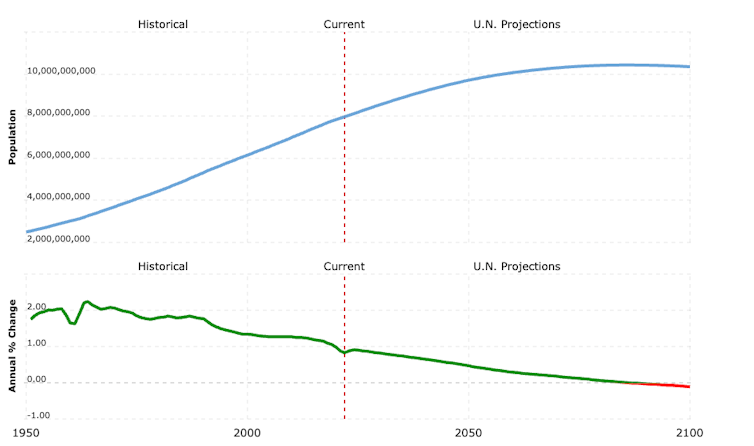
Should We Worry About Overpopulation At All?
You are now one of 8,000,000,000 humans alive today. How should we feel about this?
The modern fear of overpopulation has old roots. In 1798, Reverend Thomas Malthus warned population grows exponentially while food supply does not. Close to two centuries later, Paul and Anne Erlich’s 1968 book The Population Bomb triggered a new wave of concern. As our numbers skyrocketed, they argued, we would inevitably hit a Malthusian cliff and run out of food. Famine and war would follow. It didn’t happen.
What resulted was inhumane population control policies. The book – replete with racially charged passages about a crowded Delhi “slum” – directly influenced India’s 1970s forced sterilisation policies. China’s notorious one-child policy emerged from similar concerns.
Low- or middle-income countries are most often called on to tackle overpopulation. And the people calling for action tend to be from high-income, high-consumption countries. Even David Attenborough is concerned.
Recent calls by Western conservation researchers to tackle environmental degradation by slowing population growth repeat the same issue, focusing on the parts of the world where populations are still growing strongly – sub-Saharan Africa, Latin America and some Asian countries.
People from lower income countries reject these calls. Pakistani academic Adil Najam has observed these countries are “weary of international population policy in the name of the environment.”
Overall, the world’s wealthiest 1% account for 15% of the world’s carbon emissions. That’s more than double the emissions of the poorest 50% of the planet – who are the most vulnerable to climate change.
Prince William, for instance, has linked African population growth to wildlife loss – even though he has three children and comes from a family with a carbon footprint almost 1,600 times higher than the average Nigerian family.
What about saving wildlife? Again, a mirror may be useful here. It turns out demand from rich countries is the single largest driver of biodiversity loss globally. How? Your beef burger may have been made possible by burning the Amazon for pasture for cows, as well as many other global supply chain issues. Rich countries like Australia are also notoriously bad at protecting their own wildlife from agriculture and land clearing.
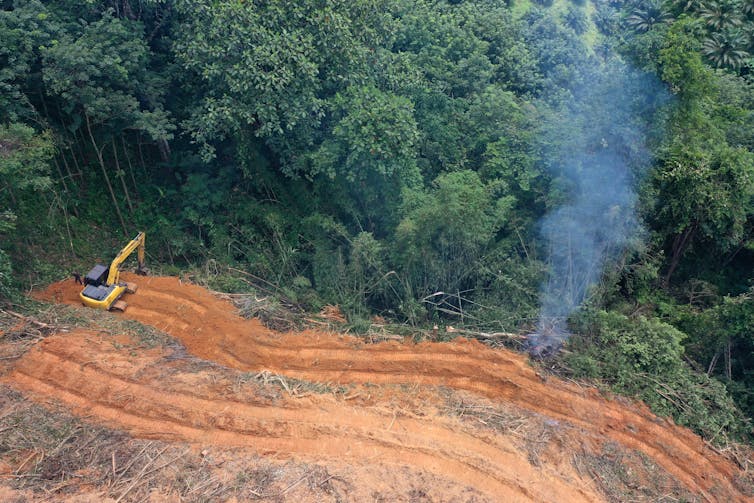
This is not to say population growth in lower income countries isn’t worth discussing. While many countries have seen their populations taper off naturally as they get wealthier, countries like Nigeria are showing signs of strain from very fast population growth. Many young Nigerians move to cities seeking opportunities, but infrastructure and job creation has not kept pace.
For Western environmentalists and policymakers, however, it would be better to shift away from a blame mentality and tackle drivers of inequality between and within nations. These include support for family planning, removing barriers to girls’ education, better regulation of global financial markets, reduced transaction costs for global remittances, and safe migration for people seeking work or refuge in higher income countries.
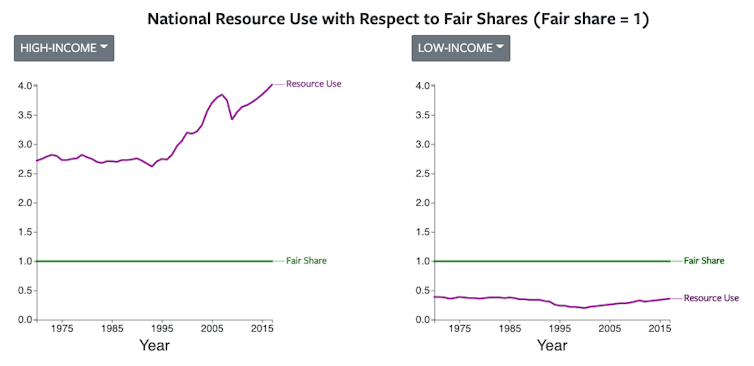
As we pass the eight billion mark, let’s reconsider our reaction. Blaming low-consumption, high-population growth countries for environmental issues ignores our role. Worse, it takes our attention away from the real work ahead of transforming society and reducing our collective impact on the planet. ![]()
Matthew Selinske, Senior research fellow, RMIT University; Leejiah Dorward, Postdoctoral research associate, Bangor University; Paul Barnes, Visiting researcher, UCL, and Stephanie Brittain, Conservation scientist, University of Oxford
This article is republished from The Conversation under a Creative Commons license. Read the original article.
4 signs of progress at the UN climate change summit
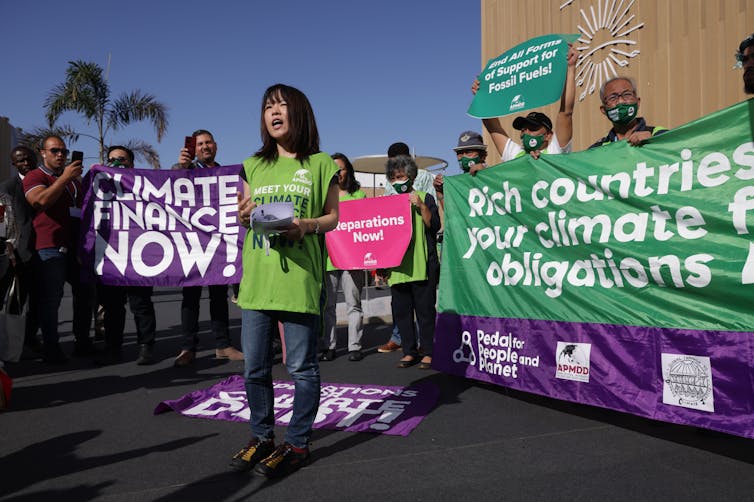
Something significant is happening in the desert in Egypt as countries meet at COP27, the United Nations summit on climate change.
Despite frustrating sclerosis in the negotiating halls, the pathway forward for ramping up climate finance to help low-income countries adapt to climate change and transition to clean energy is becoming clearer.
I spent a large part of my career working on international finance at the World Bank and the United Nations and now advise public development and private funds and teach climate diplomacy focusing on finance. Climate finance has been one of the thorniest issues in global climate negotiations for decades, but I’m seeing four promising signs of progress at COP27.
Getting To Net Zero – Without Greenwashing
First, the goal – getting the world to net zero greenhouse gas emissions by 2050 to stop global warming – is clearer.
The last climate conference, COP26 in Glasgow, Scotland, nearly fell apart over frustration that international finance wasn’t flowing to developing countries and that corporations and financial institutions were greenwashing – making claims they couldn’t back up. One year on, something is stirring.
In 2021, the financial sector arrived at COP26 in full force for the first time. Private banks, insurers and institutional investors representing US$130 trillion said they would align their investments with the goal of keeping global warming to 1.5 degrees Celsius – a pledge to net zero. That would increase funding for green growth and clean energy transitions, and reduce investments in fossil fuels. It was an apparent breakthrough. But many observers cried foul and accused the financial institutions of greenwashing.
In the year since then, a U.N. commission has put a red line around greenwashing, delineating what a company or institution must do to make a credible claim about its net-zero goals. Its checklist isn’t mandatory, but it sets a high bar based on science and will help hold companies and investors to account.
Reforming International Financial Institutions
Second, how international financial institutions like the International Monetary Fund and World Bank are working is getting much-needed attention.
Over the past 12 months, frustration has grown with the international financial system, especially with the World Bank Group’s leadership. Low-income countries have long complained about having to borrow to finance resilience to climate impacts they didn’t cause, and they have called for development banks to take more risk and leverage more private investment for much-needed projects, including expanding renewable energy.
That frustration has culminated in pressure for World Bank President David Malpass to step down. Malpass, nominated by the Trump administration in 2019, has clung on for now, but he is under pressure from the U.S., Europe and others to bring forward a new road map for the World Bank’s response to climate change this year.

Barbados Prime Minister Mia Mottley, a leading voice for reform, and others have called for $1 trillion already in the international financial system to be redirected to climate resilience projects to help vulnerable countries protect themselves from future climate disasters.
At COP27, French President Emmanuel Macron supported Mottley’s call for a shake-up in how international finance works, and together they have agreed to set up a group to suggest changes at the next meeting of the IMF and World Bank governors in spring 2023.
Meanwhile, regional development banks have been reinventing themselves to better address their countries’ needs. The Inter-American Development Bank, focused on Latin America and the Caribbean, is considering shifting its business model to take more risk and crowd in more private sector investment. The Asian Development Bank has launched an entirely new operating model designed to achieve greater climate results and leverage private financing more effectively.
Getting Private Finance Flowing
Third, more public-private partnerships are being developed to speed decarbonization and power the clean energy transition.
The first of these “Just Energy Transition Partnerships,” announced in 2021, was designed to support South Africa’s transition away from coal power. It relies on a mix of grants, loans and investments, as well as risk sharing to help bring in more private sector finance. Indonesia announced a similar partnership at the G-20 summit in November worth $20 billion. Vietnam is working on another, and Egypt announced a major new partnership at COP27.

However, the public funding has been hard to lock in. Developed countries’ coffers are dwindling, with governments including the U.S. unable or unwilling to maintain commitments. Now, pressure from the war in Ukraine and economic crises is adding to their problems.
The lack of public funds was the impetus behind U.S. Special Climate Envoy John Kerry’s proposal to use a new form of carbon offsets to pay for green energy investments in countries transitioning from coal. The idea, loosely sketched out, is that countries dependent on coal could sell carbon credits to companies, with the revenue going to fund clean energy projects. The country would speed its exit from coal and lower its emissions, and the private company could then claim that reduction in its own accounting toward net zero emissions.
Globally, voluntary carbon markets for these offsets have grown from $300 million to $2 billion since 2019, but they are still relatively small and fragile and need more robust rules.
Kerry’s proposal drew criticism, pending the fine print, for fear of swamping the market with industrial credits, collapsing prices and potentially allowing companies in the developed world to greenwash their own claims by retiring coal in the developing world.
New Rules To Strengthen Carbon Markets
Fourth, new rules are emerging to strengthen those voluntary carbon markets.
A new set of “high-integrity carbon credit principles” is expected in 2023. A code of conduct for how corporations can use voluntary carbon markets to meet their net zero claims has already been issued, and standards for ensuring that a company’s plans meet the Paris Agreement’s goals are evolving.
Incredibly, all this progress is outside the Paris Agreement, which simply calls for governments to make “finance flows consistent with a pathway towards low greenhouse gas emissions and climate-resilient development.”
Negotiators seem reluctant to mention this widespread reform movement in the formal text being negotiated at COP27, but walking through the halls here, they cannot ignore it. It’s been too slow in coming, but change in the financial system is on the way.
This article was updated Nov. 15, 2022, with Indonesia’s climate finance deal announced.![]()
Rachel Kyte, Dean of the Fletcher School, Tufts University
This article is republished from The Conversation under a Creative Commons license. Read the original article.
At least 700,000 years ago, the world’s largest sand island emerged as the barrier that helped the Great Barrier Reef form
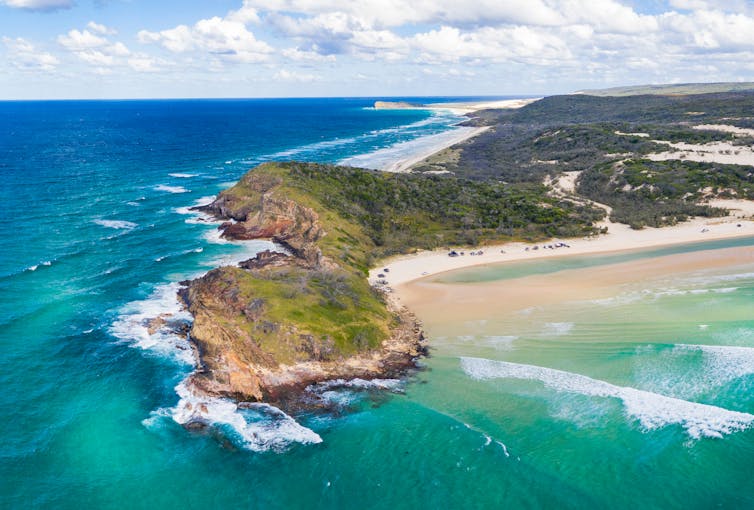
Scientists had always been puzzled why the Great Barrier Reef formed long after Australia had conditions suitable for reef growth. It turns out the answer might be K'gari (Fraser Island).
K’gari, the world’s largest sand island and a UNESCO World Heritage Area, juts out from the Australian coastline where the continent extends furthest east. It lies at the northern end of one of the world’s largest and longest longshore drift systems. If not for the presence of K’gari, the sand carried by this system would continue to migrate northward directly into the area of the Great Barrier Reef, which starts a little north of the island.
The volumes of sand carried along the coast are immense. It is estimated 500,000 cubic metres of sand moves north past each metre of shoreline every year.
K’gari plays a key role in delivering this sand to the deep ocean. Sand moving along its eastern beaches is directed across the continental shelf and into the deep immediately north of the island. The dominant south-easterly trades would drive sand all the way into the full tropics if K’gari did not direct it off the shelf.
Our research, published today, has established the age of K'gari as being older than the Greater Barrier Reef. This suggests the reef became established only after the island protected it from the northward drift of sand.

Why Does The Reef Depend On The Island?
The southern limit of the Great Barrier Reef is not a result of the climate being too cool further south. Corals can and do grow many hundreds of kilometres further south in places like Moreton Bay (Brisbane) and Lord Howe Island.
The main limiting factor for the southern extent of the reef is the drowning of corals by the rivers of sand going north. The corals in places like Moreton Bay occur where they have a hard substrate to grow on and are sheltered from sediment inundation.
The sand comes from sediment delivered to the Tasman Sea via the Hawkesbury and Hunter rivers in mid-New South Wales. Prevailing south-easterly breezes and their associated coastal wave systems sweep these sediments north for more than 1,000 kilometres.
The geological setting of eastern Australia is rather stable, so this longshore drift system should have been in operation for many millions of years. The Great Barrier Reef corals could not have survived without some protection from this northward flow of sand.
The techniques we used to establish the age of the coastal dune fields of K’gari and the adjacent Cooloola Sand Mass on the mainland south of K’gari show the first coastal dunes date to about 1 million years ago. The modern dune fields were established by 700,000-800,000 years ago. Prior to 1 million years and definitely prior to 700,000-800,000 years ago, sand would have drifted north into the region of the modern barrier reef.
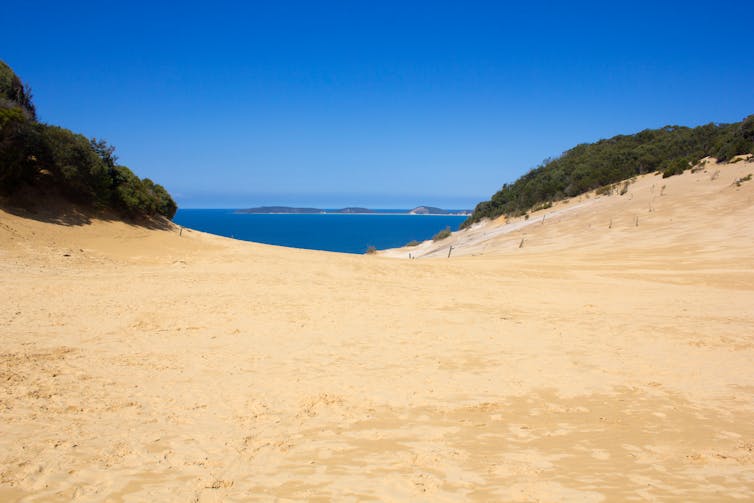
Why Did K'gari Form At That Time?
This timing coincides with a major geo-astronomical event, the Mid-Pleistocene Transition. At this time Earth’s glacial cycles changed from a period of about 40,000 years to about 100,000 years. This change had a major impact on global sea levels because the longer cycles supported the growth of larger ice caps during cold periods.
Prior to this transition, global sea levels went up and down about 70 metres between warm (interglacial) and cold (glacial) periods. Afterwards, the range increased to 120-130m.
Under a longshore drift system some sediment “leaks” out into deeper water where currents and waves are not strong enough to move it. A drop of 70m would still leave the South-East Queensland coastline on the continental shelf. So, before the Mid-Pleistocene Transition, sand moving north would be gradually stored on the outer parts of the continental shelf, potentially accumulating over millions of years.
Once the first 100,000-year cycle occurred, sea levels would have dropped to the outer edge of the continental shelf. During the start of the next warm period, rising sea levels would erode the accumulated sands and transport it shoreward. This would drive a major period of dune building along the coast.
This was a major event because sediment accumulated over millions of years was added back into the sedimentary system. The very different dune types associated with plentiful sand are recorded in the oldest parts of the cliff sections at Cooloola and K’gari.
Again, remnants of dunes formed when sea levels were low are preserved directly off this coastline. We have shown a major pulse of sand was released into the dune systems formed during the earliest high sea-level periods of the 100,000-year climate cycles.
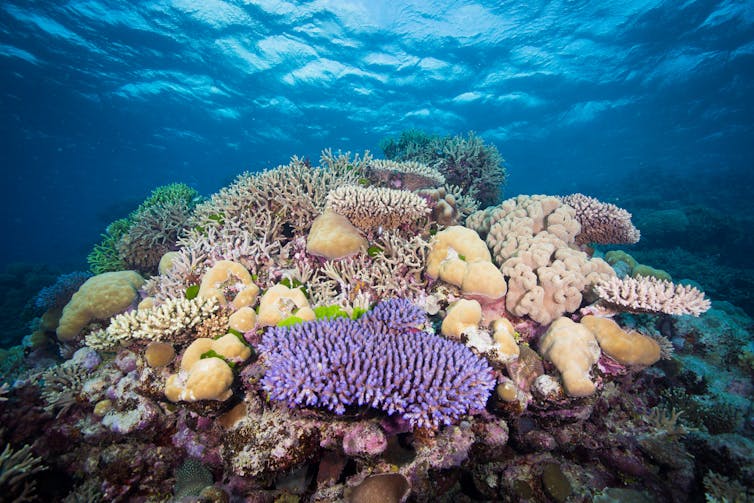
How Does That Line Up With The Age Of The Reef?
K’gari was constructed in its “modern” form between about 1 million and 700,000 years ago. Once it was in place, any further sand driven up the coast during interglacial high sea levels was lost to deep water off the north of K’gari.
The last piece of the puzzle is the age of the Great Barrier Reef. For a heavily investigated natural wonder, this is remarkably poorly defined, but the oldest evidence dates the reef to about 650,000 years ago.
In short, coral reef development appears to not have started until sediment drift from the south was blocked off. In this way the whole of the east coast of Australia is linked together as a single story and K’gari has played a key role in the formation and protection of the Great Barrier Reef.![]()
James Shulmeister, Adjunct Professor, University of Queensland, and Professor and Head of School of Earth and Environment, University of Canterbury and Daniel Ellerton, Postdoctoral Researcher, Department of Geological Sciences, Stockholm University
This article is republished from The Conversation under a Creative Commons license. Read the original article.
If you care about nature in Victoria, this is your essential state election guide
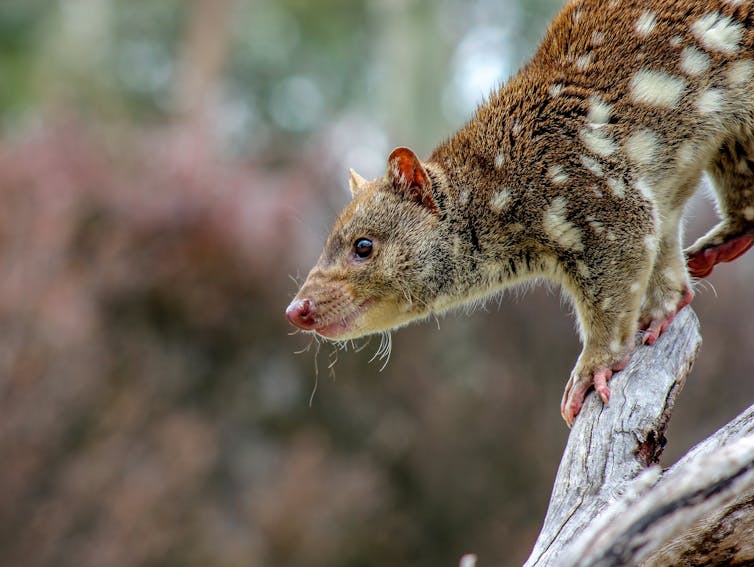
If we learnt anything from the past federal election, it’s that Australians care about climate change and nature. A survey released this week suggests the same dynamic is at play as we head into the Victorian state election.
The poll, prepared for the Victorian National Parks Association, found 36% of Victorians say their vote would be influenced by policy announcements regarding saving threatened species and stopping extinction.
The Victorian government’s own surveys have highlighted the enormous number of people who value nature. And research this year for the Australian Conservation Foundation found 95% of Australians agree it’s important to protect nature for future generations.
Despite the weight of public concern, Victoria is failing its wildlife. Last year the Victorian Auditor General’s Office handed down a damning report on biodiversity protection. It concluded that about a third of Victoria’s land-based plants, animals and ecological communities face extinction, their continued decline will likely have dire consequences for the state, and funding to protect them is grossly inadequate.
We know what’s primarily behind Australia’s extinction crisis: land clearing, invasive species and climate change-induced impacts such as extreme bushfires.
So, what have the different political parties promised in the lead up to the Victorian election, and how do they stack up? Here’s a brief guide to what’s on offer.
Funding And Policy Commitments
Let’s start with one of the key shortfalls discussed by the Auditor General – funding for biodiversity conservation. Labor has announced:
a $10 million nature fund to match biodiversity projects proposed by private or philanthropic groups
$2.8 million for Trust for Nature
$7.35 million for six large-scale conservation projects to reduce the impact of pests, predators and invasive weeds
$773,000 to extend Victoria’s Icon Species Program for another year
$160,000 for platypus conservation.
These funds don’t come close to the estimated annual shortfall of $38 million in ongoing funding needed for the government to deliver its biodiversity strategy, as identified by the Auditor General.
The Victorian Liberals have denounced Labor’s relatively dismal promises and their record of under-funding biodiversity. But, so far, new Liberal-National Coalition announcements have been limited. They include:
$20 million to increase canopy cover in metropolitan Melbourne from 15% to 35% by 2050 (it’s unclear whether this will benefit biodiversity)
$200,000 in environmental grants for Dandenong Creek, its catchments and wetlands
$1 million to rehabilitate and protect wetlands in Mount Eliza.
But the Coalition has also announced anti-environmental commitments, such as ending feral horse culling and $10 million to dredge Mordialloc Creek.
The Greens plan is to create an ongoing, $1 billion per year “zero extinction” fund to support a Save our Species program.
This would double the funding for national parks and create a program to restore land, including through a First Nations Caring for Country investment. It would also fund Trust for Natures’s work to protect and restore private land and urban biodiversity.
The Greens also commit to reforming nature laws and to offer First Nations people greater rights and control over land, water and oceans.
Teal candidate Melissa Lowe supports significant investment towards reforestation and the rehabilitation of native habitats.
Response To Native Forest Harvesting
Native forest timber harvesting continues to be a prickly issue in Victoria. This month the Supreme Court ruled state-owned logging company VicForests broke the law by failing to protect threatened species. Despite this, an ABC investigation this week found old growth forests continue to be cleared.
Greater gliders, Leadbeater’s possums and other forest-dwelling animals are facing a greater risk of extinction, and logging is one of the key threats. Without a significant change in protection, their numbers will continue to decline.
Labor’s policy is to phase out native forest logging by 2030 – but this leaves plenty of time for a lot of damage to be done. Labor also hasn’t legislated this phase-out, nor has it responded to VicForests’ failure to protect biodiversity.
Other election commitments relating to forestry include increasing fines to protesters who disrupt native forest logging.
The Liberal-Nationals have pledged to immediately reverse both of the Andrews government’s 2019 decisions to end old-growth forest logging and to phase-out native forest logging by 2030. This would take us backwards in terms of biodiversity protection.
The Greens have committed to legislating an end to native forest logging in 2023. This includes a transition plan to move workers into new jobs and a shift towards greater use of plantations.
The Reason Party and two Teal candidates have also articulated commitments for an immediate end to native forest logging.
How About Land Clearing From Other Causes?
Proportional to its size, Victoria has the highest amount of cleared land than all other states and territories. According to the Victorian Auditor General, about 10,380 habitat hectares of native vegetation is removed from Victorian private properties each year.
The state government is a significant land clearer. This includes clearing for infrastructure projects, such as new highways (including 26,000 trees cleared for the Northeast Link, though this may be a gross underestimate), and, of course, enabling native timber harvesting via VicForests, a state-owned business.
Substantial clearing also takes place under the state planning system, which the Auditor General said fundamentally fails to protect biodiversity on private land. In particular, critically endangered grasslands on Melbourne’s fringe continue to be lost at an alarming rate.
Further, the state’s planned 1,447 kilometres of strategic fuel breaks will occupy an area of around 5,790 hectares (equivalent to approximately 2,894 MCGs) of bushland that will be either cleared or altered.
Labor and the Coalition have both been silent on reforms to land clearing in the lead up to this election.
The Greens have committed to strengthening Victoria’s environmental assessment process so it can better protect the environment. Teal candidate Sophie Torney has committed to stopping the destruction of tree canopy in Kew by amending planning laws.
Links To Climate Change
Climate change is a key driver of extinction, so it’s also important to analyse political commitments on emissions reduction.
Labor has announced new targets for renewable energy in Victoria’s electricity supply of 65% by 2030, and 95% by 2035. It has also set an emissions reduction target of 75-80% by 2035, and brought forward its net-zero emissions target by five years to 2045.
The Liberal opposition has promised to legislate an emission reduction target of 50% by 2030 and is committing to a $1 billion hydrogen strategy. It also endorsed net-zero emissions by 2050.
The Greens have stepped up further, committing to replacing coal and gas with 100% renewable energy powering the state by 2030, committing to 75% carbon emissions reduction target by 2030, and net zero by 2035.
A net-zero by 2035 target is matched by all Teal candidates.
So, What Would Zero Extinction Commitments Look Like?
We know it would cost approximately $2 billion per year nationally to prevent future extinctions of Australia’s threatened plants and animals.
At least 270 (15%) of Australia’s threatened species live in Victoria. So it’s reasonable to assume around $300 million per year of focused threatened species recovery funding is required to prevent their extinction. This is likely a conservative estimate.
Regulatory reform to prevent further habitat loss, and a significant increase in spending on threatened species recovery are the two key actions to prevent further extinctions.
Preventing extinctions will also require a shift in thinking. While the major parties seem stuck in the biodiversity-versus-development mindset, others recognise development can occur in ways that enhance ecosystems.
The natural world underpins our own health and prosperity via productive agriculture and liveable cities. Keeping it healthy is an enlightened act of self-interest.
Without adequate investment, regulatory reform and reframing nature as an asset rather than a problem, we’re likely to see more plants and animals on the threatened species list. Indeed, whole ecosystems may be lost.![]()
Sarah Bekessy, Professor in Sustainability and Urban Planning, Leader, Interdisciplinary Conservation Science Research Group (ICON Science), RMIT University and Brendan Wintle, Professor in Conservation Science, School of Ecosystem and Forest Science, The University of Melbourne
This article is republished from The Conversation under a Creative Commons license. Read the original article.
Pittwater Reserves: Histories + Notes + Pictorial Walks
A History Of The Campaign For Preservation Of The Warriewood Escarpment by David Palmer OAM and Angus Gordon OAM
America Bay Track Walk - photos by Joe Mills
An Aquatic June: North Narrabeen - Turimetta - Collaroy photos by Joe Mills
Angophora Reserve Angophora Reserve Flowers Grand Old Tree Of Angophora Reserve Falls Back To The Earth - History page
Annie Wyatt Reserve - A Pictorial
Avalon's Village Green: Avalon Park Becomes Dunbar Park - Some History + Toongari Reserve and Catalpa Reserve
Bairne Walking Track Ku-Ring-Gai Chase NP by Kevin Murray
Bangalley Headland Bangalley Mid Winter
Banksias of Pittwater
Barrenjoey Boathouse In Governor Phillip Park Part Of Our Community For 75 Years: Photos From The Collection Of Russell Walton, Son Of Victor Walton
Barrenjoey Headland: Spring flowers
Barrenjoey Headland after fire
Bayview Baths
Bayview Wetlands
Beeby Park
Bilgola Beach
Botham Beach by Barbara Davies
Bungan Beach Bush Care
Careel Bay Saltmarsh plants
Careel Bay Birds
Careel Bay Clean Up day
Careel Bay Playing Fields History and Current
Careel Creek
Careel Creek - If you rebuild it they will come
Centre trail in Ku-ring-gai Chase National Park
Chiltern Track- Ingleside by Marita Macrae
Clareville Beach
Clareville/Long Beach Reserve + some History
Coastal Stability Series: Cabbage Tree Bay To Barrenjoey To Observation Point by John Illingsworth, Pittwater Pathways, and Dr. Peter Mitchell OAM
Cowan Track by Kevin Murray
Curl Curl To Freshwater Walk: October 2021 by Kevin Murray and Joe Mills
Currawong and Palm Beach Views - Winter 2018
Currawong-Mackerel-The Basin A Stroll In Early November 2021 - photos by Selena Griffith
Currawong State Park Currawong Beach + Currawong Creek
Deep Creek To Warriewood Walk photos by Joe Mills
Drone Gives A New View On Coastal Stability; Bungan: Bungan Headland To Newport Beach + Bilgola: North Newport Beach To Avalon + Bangalley: Avalon Headland To Palm Beach
Duck Holes: McCarrs Creek by Joe Mills
Dunbar Park - Some History + Toongari Reserve and Catalpa Reserve
Dundundra Falls Reserve: August 2020 photos by Selena Griffith - Listed in 1935
Elsie Track, Scotland Island
Elvina Track in Late Winter 2019 by Penny Gleen
Elvina Bay Walking Track: Spring 2020 photos by Joe Mills
Elvina Bay-Lovett Bay Loop Spring 2020 by Kevin Murray and Joe Mills
Fern Creek - Ingleside Escarpment To Warriewood Walk + Some History photos by Joe Mills
Iluka Park, Woorak Park, Pittwater Park, Sand Point Reserve, Snapperman Beach Reserve - Palm Beach: Some History
Ingleside
Ingleside Wildflowers August 2013
Irrawong - Ingleside Escarpment Trail Walk Spring 2020 photos by Joe Mills
Irrawong - Mullet Creek Restoration
Katandra Bushland Sanctuary - Ingleside
Lucinda Park, Palm Beach: Some History + 2022 Pictures
McCarrs Creek
McCarr's Creek to Church Point to Bayview Waterfront Path
McKay Reserve
Mona Vale Beach - A Stroll Along, Spring 2021 by Kevin Murray
Mona Vale Headland, Basin and Beach Restoration
Mount Murray Anderson Walking Track by Kevin Murray and Joe Mills
Mullet Creek
Narrabeen Creek
Narrabeen Lagoon Catchment: Past Notes Present Photos by Margaret Woods
Narrabeen Lagoon State Park
Narrabeen Lagoon State Park Expansion
Narrabeen Rockshelf Aquatic Reserve
Nerang Track, Terrey Hills by Bea Pierce
Newport Bushlink - the Crown of the Hill Linked Reserves
Newport Community Garden - Woolcott Reserve
Newport to Bilgola Bushlink 'From The Crown To The Sea' Paths: Founded In 1956 - A Tip and Quarry Becomes Green Space For People and Wildlife
Pittwater spring: waterbirds return to Wetlands
Pittwater's Lone Rangers - 120 Years of Ku-Ring-Gai Chase and the Men of Flowers Inspired by Eccleston Du Faur
Pittwater's Parallel Estuary - The Cowan 'Creek
Resolute Track at West Head by Kevin Murray
Resolute Track Stroll by Joe Mills
Riddle Reserve, Bayview
Salvation Loop Trail, Ku-Ring-Gai Chase National Park- Spring 2020 - by Selena Griffith
Seagull Pair At Turimetta Beach: Spring Is In The Air!
Stapleton Reserve
Stapleton Park Reserve In Spring 2020: An Urban Ark Of Plants Found Nowhere Else
Stony Range Regional Botanical Garden: Some History On How A Reserve Became An Australian Plant Park
The Chiltern Track
The Resolute Beach Loop Track At West Head In Ku-Ring-Gai Chase National Park by Kevin Murray
Topham Track Ku-Ring-Gai Chase NP, August 2022 by Joe Mills and Kevin Murray
Towlers Bay Walking Track by Joe Mills
Trafalgar Square, Newport: A 'Commons' Park Dedicated By Private Landholders - The Green Heart Of This Community
Tranquil Turimetta Beach, April 2022 by Joe Mills
Turimetta Beach Reserve by Joe Mills, Bea Pierce and Lesley
Turimetta Beach Reserve: Old & New Images (by Kevin Murray) + Some History
Turimetta Headland
Warriewood Wetlands and Irrawong Reserve
Whale Beach Ocean Reserve: 'The Strand' - Some History On Another Great Protected Pittwater Reserve
Wilshire Park Palm Beach: Some History + Photos From May 2022
Winji Jimmi - Water Maze

New Shorebirds WingThing For Youngsters Available To Download
A Shorebirds WingThing educational brochure for kids (A5) helps children learn about shorebirds, their life and journey. The 2021 revised brochure version was published in February 2021 and is available now. You can download a file copy here.
If you would like a free print copy of this brochure, please send a self-addressed envelope with A$1.10 postage (or larger if you would like it unfolded) affixed to: BirdLife Australia, Shorebird WingThing Request, 2-05Shorebird WingThing/60 Leicester St, Carlton VIC 3053.

 Shorebird Identification Booklet
Shorebird Identification Booklet
The Migratory Shorebird Program has just released the third edition of its hugely popular Shorebird Identification Booklet. The team has thoroughly revised and updated this pocket-sized companion for all shorebird counters and interested birders, with lots of useful information on our most common shorebirds, key identification features, sighting distribution maps and short articles on some of BirdLife’s shorebird activities.
The booklet can be downloaded here in PDF file format: http://www.birdlife.org.au/documents/Shorebird_ID_Booklet_V3.pdf
Paper copies can be ordered as well, see http://www.birdlife.org.au/projects/shorebirds-2020/counter-resources for details.
Download BirdLife Australia's children’s education kit to help them learn more about our wading birdlife
Shorebirds are a group of wading birds that can be found feeding on swamps, tidal mudflats, estuaries, beaches and open country. For many people, shorebirds are just those brown birds feeding a long way out on the mud but they are actually a remarkably diverse collection of birds including stilts, sandpipers, snipe, curlews, godwits, plovers and oystercatchers. Each species is superbly adapted to suit its preferred habitat. The Red-necked Stint is as small as a sparrow, with relatively short legs and bill that it pecks food from the surface of the mud with, whereas the Eastern Curlew is over two feet long with a exceptionally long legs and a massively curved beak that it thrusts deep down into the mud to pull out crabs, worms and other creatures hidden below the surface.
Some shorebirds are fairly drab in plumage, especially when they are visiting Australia in their non-breeding season, but when they migrate to their Arctic nesting grounds, they develop a vibrant flush of bright colours to attract a mate. We have 37 types of shorebirds that annually migrate to Australia on some of the most lengthy and arduous journeys in the animal kingdom, but there are also 18 shorebirds that call Australia home all year round.
What all our shorebirds have in common—be they large or small, seasoned traveller or homebody, brightly coloured or in muted tones—is that each species needs adequate safe areas where they can successfully feed and breed.
The National Shorebird Monitoring Program is managed and supported by BirdLife Australia.
This project is supported by Glenelg Hopkins Catchment Management Authority and Hunter Local Land Services through funding from the Australian Government’s National Landcare Program. Funding from Helen Macpherson Smith Trust and Port Phillip Bay Fund is acknowledged.
The National Shorebird Monitoring Program is made possible with the help of over 1,600 volunteers working in coastal and inland habitats all over Australia.
The National Shorebird Monitoring program (started as the Shorebirds 2020 project initiated to re-invigorate monitoring around Australia) is raising awareness of how incredible shorebirds are, and actively engaging the community to participate in gathering information needed to conserve shorebirds.
In the short term, the destruction of tidal ecosystems will need to be stopped, and our program is designed to strengthen the case for protecting these important habitats.
In the long term, there will be a need to mitigate against the likely effects of climate change on a species that travels across the entire range of latitudes where impacts are likely.
The identification and protection of critical areas for shorebirds will need to continue in order to guard against the potential threats associated with habitats in close proximity to nearly half the human population.
Here in Australia, the place where these birds grow up and spend most of their lives, continued monitoring is necessary to inform the best management practice to maintain shorebird populations.
BirdLife Australia believe that we can help secure a brighter future for these remarkable birds by educating stakeholders, gathering information on how and why shorebird populations are changing, and working to grow the community of people who care about shorebirds.
To find out more visit: http://www.birdlife.org.au/projects/shorebirds-2020/shorebirds-2020-program
Aussie Bread Tags Collection Points

Staying Safe At Schoolies
- Leave a copy of your bank card details at home in case you lose it and have to cancel it, take your bank contact details with you so that you can report lost or stolen cards
- Make sure you’ll have enough money to cover all the essentials while you’re away, including an emergency stash
- Know where you’re staying and how you will be getting there and home again
- Have a safe place you can store any important documents or valuables while you’re away - a lockable side pocket within a bag works best
- Remember your phone charger and make sure you have plenty of credit/data, so that you can stay in touch with home or call for help if you need to - also remember to stop when packing to come home, look around you and make sure you pack that charger
- When you’ve booked your accommodation make sure your parents or carers have a copy of the details – they will want to know where you are and that you are safe
- Your ID and Drivers Licence
- Your phone charger
- A decent hat, sunscreen and mozzie repellent
- Some comfy shoes - closed in, as well as sandals/thongs - there be ants and spiders out there!
- Basic First Aid kit – band aids, safety pins and paracetamol
- Any medications you might need - leave the scripts at home so you don't lose them
- Transportable food; muesli bars, instant noodles, cup-a-soups, a mix of dried fruits and nuts
- Soap bag - deodorant, a cake of soap, shampoo, toothpaste and toothbrush, a comb, a shaver
- Reusable water bottle - carrying around the non-reusable plastic pose version is NOT fashionable any longer
- PLEASE make sure someone always knows where you are going and when to expect you back – ideally go out with a minimum of one other person or stick together as a group
- Have a way of staying in touch with your parents and contacting them in an emergency - maybe decide before heading off that you will send them a text in the morning and check in via phone call at a certain time each afternoon/evening. Remember it’s FREE to use public pay phones across Australia now. You could also give your parents contact details to a couple of your friends going away with you (and their parents too if you know them).
- When you’re out and about, stay with your friends and have a plan to meet up at a certain time and place if you lose each other in the crowd
- Be careful about who you tell where you are staying – arrange to meet new friends in a public place rather than at your accommodation
- Plan how you will get back to your accommodation and make sure you have enough money left at the end of the night to follow your plan
- If you’re walking around late at night please stick to well-lit areas
- Don’t leave your drinks unattended or accept drinks from strangers
- Don't take drugs - the only way to stay safe around drugs at Schoolies is to not take them. There is no safe level of illicit drug use – taking drugs is always risky as no one can ever be sure of what they are really taking, but more importantly, you can never know how your body will react - effects can vary between people or can give different results for the same person on different occasions
- Don't post 'stuff' to social media that you may regret having put out there the following day; keep some 'this is mine' stuff just for yourself; set profiles to ‘private’ or ‘friends only’ and only accept friend requests from people you know and trust or/and set an agreement with friends that consent must be given by all parties before uploading and/or tagging a photo and videos
- it is illegal to drink alcohol at Schoolies under the age of 18
- it’s an offence to supply alcohol to someone under the age of 18 – you could face fines of up to $10,444
- it is illegal to drink in public and to be drunk in a public place – no matter what their age - these are the laws for all of Queensland - not just during Schoolies
- under 18’s can’t carry alcohol in public (even if you’re holding it for a mate whilst he does up his shoe lace)
- it’s okay to say no – if you think you have had too much or don’t want to drink at all, just say no
- avoid mixing alcohol and medication (or any type of drug) - the side effects could be very serious
- take it in turns to have one sober friend every night
- give your body a break - just because it’s Schoolies doesn’t mean you have to drink every night (the human body is not designed to party for seven straight nights)
- when out and about, if you (or a friend) have had too much to drink, they can always ask a Safer Schoolies volunteer for assistance
- balconies can become very dangerous after drinking alcohol – stay well away from them if under the influence.
Byron Bay Schoolies 2022
 More than 6,000 school leavers are expected to celebrate the end of their formal education in Byron Bay over the Schoolies Week period which starts on 26 November 2022.
More than 6,000 school leavers are expected to celebrate the end of their formal education in Byron Bay over the Schoolies Week period which starts on 26 November 2022.Schoolies Road Safety Tips
Wings Over Illawarra 2022
Joe Mills, who usually does a lot of the walks through our local reserves and bush areas with his mate Kevin Murray, went further afield over the weekend of November 12-13th 2022 - to the Wings over Illawarra airshow that happens at Shellharbour Airport, which is also home to the Historical Aircraft Restoration Society (HARS) Aviation Museum. The great people there are 'Dedicated to keeping Australian Aviation History "in the air" '.
Wings Over Illawarra is Australia’s largest annual airshow and is held in the Illawarra on the NSW south coast just over an hour south of Sydney. Situated in a picturesque location with an amazing backdrop of the Illawarra escarpment, it is the only major airshow experience within easy reach of metropolitan Sydney and Canberra.
Its’ diverse program includes ground displays and flying demonstrations of historic, military, modern and aerobatic aircraft as well as children’s rides, students information sessions and other aviation and technology related exhibitions.
This year they had a great range of historical aircraft on display - a Kitty Hawke, a replica of the Southern Cross, possibly Australia’s most famous aircraft, as it was used by aviation pioneer Sir Charles Kingsford Smith to fly from the United States to Australia in 1928. This replica of the old Fokker aircraft was built in the 1980s. There were also aircraft from all three arms of the Australian Defence Force, with air displays and static exhibits from the Royal Australian Air Force, Royal Australian Navy and Australian Army. There were Hornets, a Hercules and some great more 'modern' aircraft. What's more, you could get inside some of these and have a good look around.
We've put LOTS of Joe's photos in the Park Bench Philosopher's Page this Issue, along with some taken by LAC Chris Tsakisiris (LAC - means Leading Aircraftman) and some insights by Flight Lieutenant Nicholas O’Connor. Here are a few - including the flying display put on by the RAAF Roulettes to open the show on the Saturday.
Next Issue the Profile of the Week features an insight into the Australian Air Force Cadets - No 305 Squadron that meets at Dee Why each week - more 'up, up and away' information for those of us who love feathery birds and those built by hand!

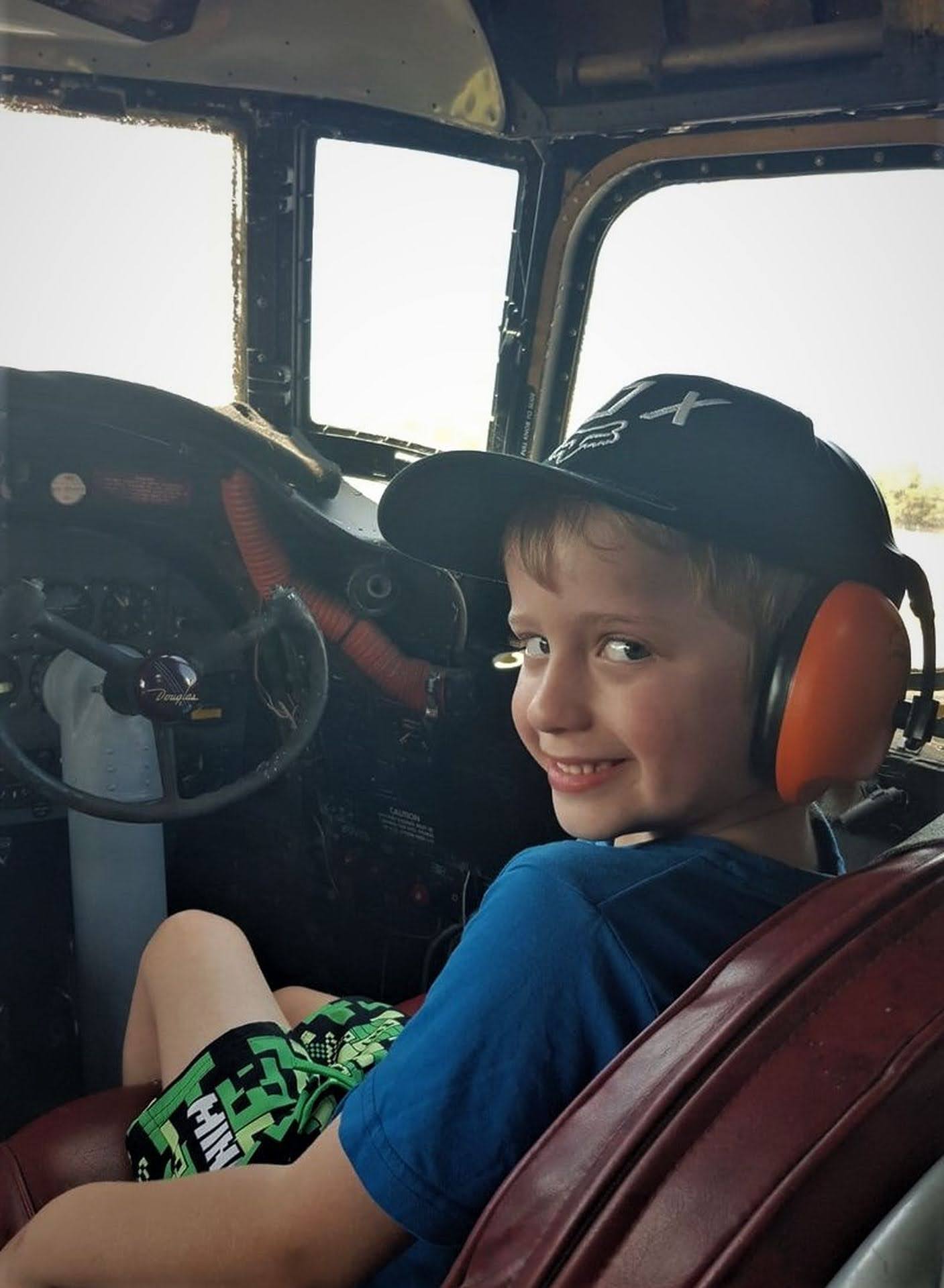


NASA’s Webb Catches Fiery Hourglass As New Star Forms



School Leavers Support
- Download or explore the SLIK here to help guide Your Career.
- School Leavers Information Kit (PDF 5.2MB).
- School Leavers Information Kit (DOCX 0.9MB).
- The SLIK has also been translated into additional languages.
- Download our information booklets if you are rural, regional and remote, Aboriginal or Torres Strait Islander, or living with disability.
- Support for Regional, Rural and Remote School Leavers (PDF 2MB).
- Support for Regional, Rural and Remote School Leavers (DOCX 0.9MB).
- Support for Aboriginal and/or Torres Strait Islander School Leavers (PDF 2MB).
- Support for Aboriginal and/or Torres Strait Islander School Leavers (DOCX 1.1MB).
- Support for School Leavers with Disability (PDF 2MB).
- Support for School Leavers with Disability (DOCX 0.9MB).
- Download the Parents and Guardian’s Guide for School Leavers, which summarises the resources and information available to help you explore all the education, training, and work options available to your young person.
School Leavers Information Service
- navigate the School Leavers Information Kit (SLIK),
- access and use the Your Career website and tools; and
- find relevant support services if needed.
An Epic Set Of Performers Announced For The 2022 ARIA Awards
Be The Boss: I Want To Be A Video Game Designer
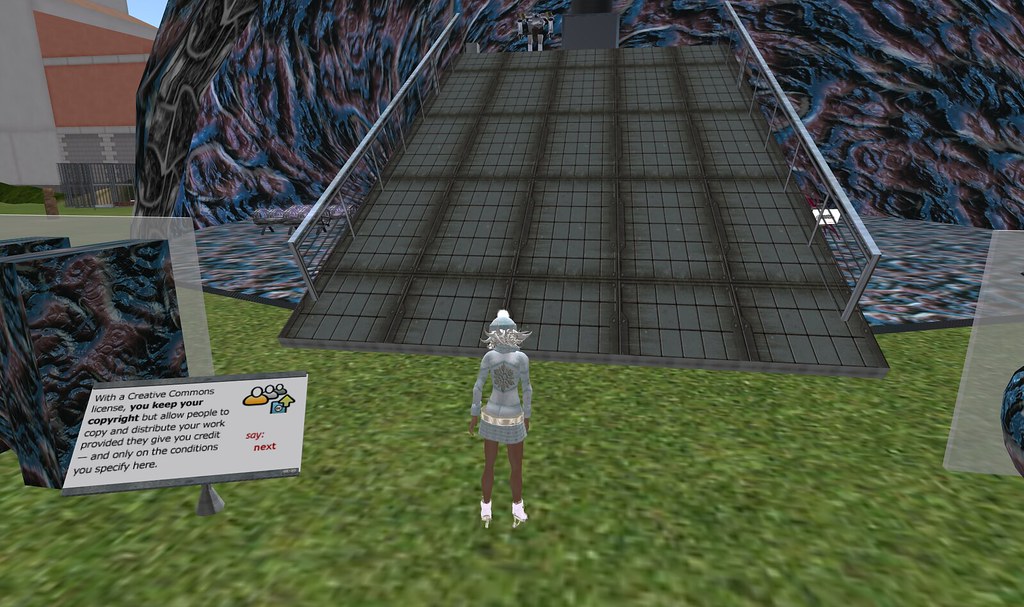
Summer Skills Fee Free Courses
Summer Skills is a fee-free* short course program to support school leavers, aged between 15 – 24 years, obtain job-ready skills over the summer months.
Whether you plan to attend TAFE NSW, university, have a gap year or are still undecided, we have a course that can give you the skills for a brighter future.
Priority industry areas have been identified under Skilling for Recovery and include short courses in Early Childhood Care, Aged Care, Disability, Hospitality, Construction, Agriculture, Business and Administration, IT and Digital, Retail, Transport and Logistics, Manufacturing/Engineering and Sport and Recreation.
For example - starting November 23, 2022 at Ryde: STATEMENT OF ATTAINMENT IN COMMERCIAL COOKERY BASICS
Or starting November 24th at Ryde: STATEMENT OF ATTAINMENT IN ESPRESSO COFFEE
Find out more at: https://www.tafensw.edu.au/summer-skills
Also Available:
- Be the Boss: I Want To Be A Baker
- Be The Boss: I Want To Be An Information Technology Administrator
- Be The Boss: I Want To Be An Architect
- Be The Boss: I Want to Be a Marine Electrician
- Be The Boss: I want To Be A Cabinet Maker
- Be The Boss: I Want To Be An Automotive Mechanic
- Be The Boss: I Want To Be A Biotechnologist
- Be The Boss: I Want To Be A Pilot
- Be The Boss: I Want To Be A Music Producer
- Be The Boss: I Want To Be A Gardener
- Be The Boss: I Want To Be A Builder
- Be The Boss: I Want To Be A Confectioner
- Be The Boss: I Want To Be A Ship's Captain
Word Of The Week: School
Noun
1. an organisation that provides instruction: such as a college or university. 2. the process of teaching or learning especially at a school. 3. a source of knowledge. 4. a group of persons who hold a common doctrine or follow the same teacher (as in philosophy, theology, or medicine). 5. the regulations governing military drill of individuals or units.
Verb
1. to swim or feed in a school (of fish). 2. to teach or drill in a specific knowledge or skill. 3. to educate in an institution of learning.
From at least 12th century; Middle English scole, from Old English scōl, from Latin schola, from Greek scholē leisure, discussion, lecture, school.
The word school derives from Greek scholē, originally meaning "leisure" and also "that in which leisure is employed", but later "a group to whom lectures were given, school".

Plato's academy, mosaic from Pompeii
Som Sabadell Flashmob - BANCO SABADELL
Grease - Central Station Antwerp
Uptown Funk Flashmob In Sydney
Columbia, Bogota - AAINJALA 150 TAMBORES
In the indigenous Wuayuunaiki language of the region, AAINJAA means “to do, to elaborate, to manufacture, and to build.”
Pierce County Sheriff's Department Dance Off!
Schoolies Flash Mob - Surfers Paradise, 2011
THE LION KING Australia: Cast Sings Circle Of Life On Flight Home From Brisbane
"Lean On Me" By The Purple Tunnel People
Love Has No Labels
Pumping loud music is putting more than 1 billion young people at risk of hearing loss

Music is an integral part of human life. It’s all around us, just like sunshine, lifting our mood. We enjoy it so much that many of us take it with us everywhere on our phones or we spend weekends hitting the club scene, live-music venues or concerts.
Meanwhile, many of us may have felt annoyed by loud sound from music venues or remarked on sound emanating from someone else’s headphones. We’re probably aware we should prevent hearing loss from loud industrial noise at work or from using power tools at home.
A systematic review released today in BMJ Global Health reports unsafe listening practices in adolescents and young adults from using personal listening devices (such as phones or digital music players) and going to loud clubs and gigs are common, and could be a major factor contributing to hearing loss.
In fact, the authors estimate the pumping tunes could be placing up to 1.35 billion young people at risk of hearing loss worldwide.
What The Study Looked At
Systematic analysis involves looking across multiple studies to identify consistent findings. In this study, the authors included 33 peer-reviewed studies published between 2000 and 2021, involving over 19,000 people, aged 12–34.
In the study, unsafe listening was identified as listening at levels above 80 decibels for over 40 hours per week. For context, this is the level above which most Australian states require industry to implement noise protection processes such as use of hearing protectors.
The study confirms the rate of unsafe listening practices is high in adolescents and young adults: 23.81% of them were listening to music on personal devices at unsafe levels and 48.2% at loud entertainment venues (though this rate is less certain). Based on global estimates of population, this translates to up to 1.35 billion young people at risk of hearing loss globally. The World Health Organization estimates over 430 million people worldwide already have a disabling hearing loss and prevalence could double if hearing loss prevention is not prioritised.
The results tally with our previous studies conducted by Australia’s National Acoustic Laboratories and HEARing Cooperative Research Centre.
More than a decade ago we reported a high potential for hearing loss from attendance at nightclubs, pubs and live concerts in young Australians aged between 18–35 years.
Back then, we found 13% of young Australians (aged 18–35) were getting a yearly noise dose from nightclubs, concerts and sporting activities that exceeded the maximum acceptable dose in industry. In 2015, the WHO launched the Make listening Safe initiative to encourage young people to protect their hearing.

Why It’s Bad For Your Hearing
So what’s the problem with loud music? Like sunshine, overexposure can lead to harm.
Loud noise, including music, can kill off hair cells and membranes in the inner ear (the cochlea). Once hearing is lost, a person mightn’t be able to hear or understand speech or sounds around them.
Research shows hearing loss results from a combination of sound being too loud (and it doesn’t need to be painful to cause hearing damage), listening to loud sound too long (and the louder the sound, the less time you can listen before your hearing is at risk) and how often you are exposed (and hearing damage is cumulative over time).
A good “rule of ear” is that if you hear ringing in your ears at or after listening, you are at risk of damaging your hearing. This type of hearing loss is permanent and may require use of hearing aids or cochlear implants.
Wait, So No Loud Music At All?
So what can we do, short of throwing away our headphones and avoiding clubbing and live music?
First, just like with the sun and skin, we need to be aware of the risks to our hearing and take the necessary steps to protect ourselves. We need to be aware of how loud sound is around us and how to keep our exposure within safe levels. We can do this by using personal hearing protection in clubs (such as ear muffs or ear plugs that are fit for purpose), or limiting how often we visit noisy music venues or how long we stay at really loud ones.
In Australia, people can access a free noise risk calculator to calculate their personal risk using an online sound level meter, and to explore how changes in lifestyle could protect their hearing while still allowing them to enjoy music.
Most phones now come with software that can monitor safe listening levels and limit exposure.

Hearing protection at the venue level is more challenging and may require regulatory and industry-based approaches. Our 2020 research identified hazard controls for entertainment venues, such alternating volume between louder and softer levels, rotating staff, providing quiet rooms, and raising speaker locations above head height. We also showed DJs and venues were open to initiatives aimed at reducing the risk of hearing loss for their patrons and staff.
Compromises are possible and they could enable enjoyment of music at live-music venues, while still protecting hearing. That way everyone will be able keep enjoying music for longer.![]()
Robert Cowan, Professorial Research Fellow, Audiology and Speech Pathology, The University of Melbourne
This article is republished from The Conversation under a Creative Commons license. Read the original article.
Chokepoint Capitalism: why we’ll all lose unless we stop Amazon, Spotify and other platforms squeezing cash from creators

In 2020, the independent authors and small publishers whose audiobooks reach their readers via Audible’s ACX platform smelled a rat.
Audiobooks were booming, but sales of their own books – produced at great expense and well-reviewed – were plummeting.
Some of their royalty statements reported negative sales, as readers returned more books than they bought. This was hard to make sense of, because Audible only reported net sales, refusing to reveal the sales and refunds that made them up.
Perth-based writer Susan May wondered whether those returns might be the reason for her dwindling net sales. She pressed Audible to tell her how many of her sales were being negated by returns, but the company stonewalled.
Then, in October 2020, a glitch caused three weeks of returns data to be reported in a single day, and authors discovered that hundreds (and even thousands) of their sales had been wiped out by returns.
Suddenly, the scam came into focus: the Amazon-owned Audible had been offering an extraordinarily generous returns policy, encouraging subscribers to return books they’d had on their devices for months, even if they had listened to them the whole way through, even if they had loved them – no questions asked.
Encouraged by the policy, some subscribers had been treating the service like a library – returning books for fresh credits they could swap for new ones. Few would have realised that Audible clawed back the royalties from the book’s authors every time a book was returned.
Good For Amazon, Bad For Authors
It was good for Amazon – it helped Audible gain and hold onto subscribers – but bad for the authors and the performers who created the audiobooks, who barely got paid.
Understanding Amazon’s motivation helps us understand a phenomenon we call chokepoint capitalism, a modern plague on creative industries and many other industries too.
Orthodox economics tells us not to worry about corporations dominating markets because that will attract competitors, who will put things back in balance.
But many of today’s big corporations and billionaire investors have perfected ways to make those supposedly-temporary advantages permanent.
Warren Buffett salivates over businesses with “wide, sustainable moats”. Peter Thiel scoffs that “competition is for losers”. Business schools teach students ways to lock in customers and suppliers and eliminate competition, so they can shake down the people who make what they supply and buy what they sell.
Locking In Customers And Creators
Amazon is the poster child for chokepoint capitalism. It boasts of its “flywheel” – a self-described “virtuous cycle” where its lower cost leads to lower prices and a better customer experience, which leads to more traffic, which leads to more sellers, and a better selection – which further propels the flywheel.

But the way the cycle works isn’t virtuous – it’s vicious and anti-competitive.
Amazon openly admits to doing everything it can to lock in its customers. That’s why Audible encourages book returns: its generous offer only applies to ongoing subscribers. Audible wants the money from monthly subscribers and wants the fact that they are subscribed to prevent them from shopping elsewhere.
Paying the people who actually made the product it sells a fair share of earnings isn’t Amazon’s priority. Because Amazon founder Jeff Bezos’ famous maxim is “your margin is my opportunity”, the executive who figured out how to make authors foot the bill for retaining subscribers probably got a bonus.
Another way Audible locks customers in is by ensuring the books it sells are protected by digital rights management (DRM) which means they are encrypted, and can only be read by software with the decryption key.
Amazon claims DRM stops listeners from stealing from creators by pirating their books. But tools to strip away those locks are freely available online, and it’s easy for readers who can’t or won’t pay for books to find illegal versions.
While DRM doesn’t prevent infringement, it does prevent competition.
Startups that want to challenge Audible’s dominance – including those that would pay fairly – have to persuade potential customers to give up their Audible titles or to inconveniently maintain separate libraries.
In this way, laws that were intended to protect against infringement of copyright have become tools to protect against infringement of corporate dominance.
Once customers are locked in, suppliers (authors and publishers) are locked in too. It’s incredibly difficult to reach audiobook buyers unless you’re on Audible. When the suppliers are locked in, they can be shaken down for an ever-greater share of what the buyers hand over.

How A Few Big Buyers Can Control Whole Markets
The problem isn’t with middlemen as such: book shops, record labels, book and music publishers, agents and myriad others provide valuable services that help keep creative wheels turning.
The problem arises when these middlemen grow powerful enough to bend markets into hourglass shapes, with audiences at one end, masses of creators at the other, and themselves operating as a chokepoint in the middle.
Since everyone has to go through them, they’re able to control the terms on which creative goods and services are exchanged - and extract more than their fair share of value.
The corporations who create these chokepoints are trying to “monopsonise” their markets. “Monopsony” isn’t a pretty word, but it’s one we are going to have to get familiar with to understand why so many of us are feeling squeezed.
Monopoly (or near-monopoly) is where there is only one big seller, leaving buyers with few other places to turn. Monopsony is where there is only one big buyer, leaving sellers with few other places to turn.
In our book, we quote William Deresiewicz, a former professor of English at Yale University, who points out in his book The Death of the Artist that “if you can only sell your product to a single entity, it’s not your customer; it’s your boss”.
Increasingly, it is how the creative industries are structured. There’s Audible for audiobooks, Amazon for physical and digital versions, YouTube for video, Google and Facebook for online news advertising, the Big Three record labels (who own the big three music publishers) for recorded music, Spotify for streaming, Live Nation for live music and ticketing – and that’s just the start.
But as corporate concentration increases across the board, monopsony is becoming a problem for the rest of us. For a glimpse into what happens to labour markets when buyers become too powerful, just think about how monopsonistic supermarkets bully food manufacturers and farmers.
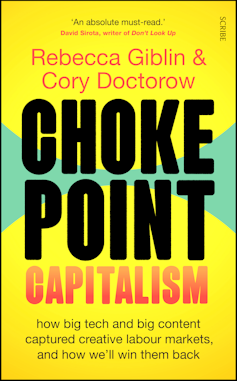
A Fairer Deal For Consumers And Creators
The good news is that we don’t have to put up with it.
Chokepoint Capitalism isn’t one of those “Chapter 11 books” – ten chapters about how terrible everything is, plus a conclusion with some vague suggestions about what can be done.
The whole second half is devoted to detailed proposals for widening these chokepoints out – such as transparency rights, among others.
Audible’s sly trick only finally came to light because of the glitch that let authors see the scope of returns.
That glitch enabled writers, led by Susan May, to organise a campaign that eventually forced Audible to reform some of its more egregious practices. But we need more light in dark corners.
And we need reforms to contract law to level the playing field in negotiations, interoperability rights to prevent lock-in to platforms, copyrights being better secured to creators rather than publishers, and minimum wages for creative work.
These and the other things we suggest would do much to empower artists and get them paid. And they would provide inspiration for the increasing rest of us who are supplying our goods or our labour to increasingly powerful corporations that can’t seem to keep their hands out of our pockets.
Chokepoint Capitalism: how big tech and big content captured creative labour markets, and how we’ll win them back is published on Tuesday November 15 by Scribe.![]()
Rebecca Giblin, ARC Future Fellow; Associate Professor; Director, Intellectual Property Research Institute of Australia, The University of Melbourne and Cory Doctorow, Visiting professor of computer science, The Open University
This article is republished from The Conversation under a Creative Commons license. Read the original article.
‘What am I supposed to do about all this really bad stuff?’ Young people identify 7 ‘superpowers’ to fight climate change
Phoebe Quinn, The University of Melbourne and Katitza Marinkovic Chavez, The University of MelbourneMany young people feel anxious, powerless, sad and angry about climate change.
Although there are some great resources on children’s eco-anxiety and climate distress, the vast majority are designed for and by adults.
So, what resources do children and young people themselves want, to support them in facing climate change? And what strengths do they have when it comes to learning about, coping with and acting on this vast and complex problem?
Our Study Involved Young People
To find out, we ran a series of workshops with 31 young people aged 12 to 25 in Victoria. The aim was to design a website for other children and young people who are concerned about climate change.
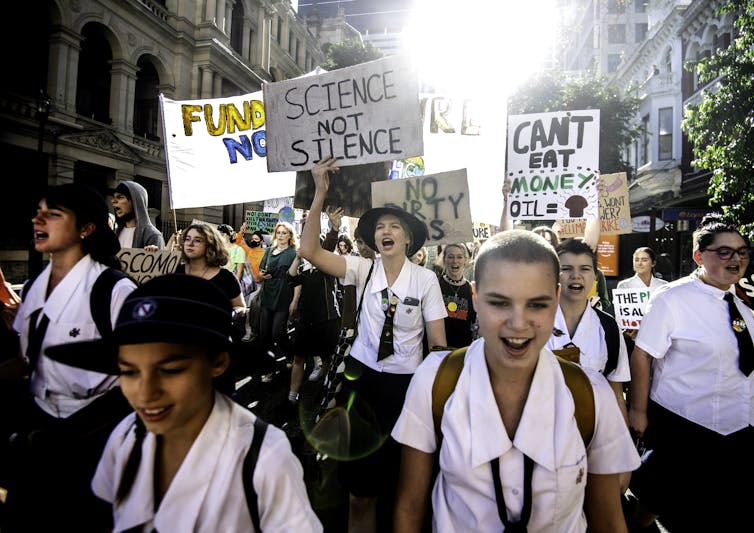
The young co-designers told us about the unique strengths or “superpowers” children and young people have, and how they can draw on these in the face of climate change.
They shared stories and tips from their own experiences, as well as from the experiences of their friends, siblings, or young people they had read or heard about.
What Do You Young People Want?
The co-designers said young people want opportunities to share these experiences and learn from each other, and for adults to genuinely engage with them. As one participant told us:
Make it in a way that’s not tokenistic.
They also said website needed to focus on “something I can do”. As another participant said:
I found initially when learning about climate change, and everything was very overwhelming, because it was all very big scale global issues. And then I got stuck on what am I supposed to do about all this really bad stuff happening?
The young co-designers recognise young people have diverse circumstances, skills, interests and experiences of climate change. They wanted to create a website that was inclusive and flexible, so each young person could choose what they wanted to focus on.
For example, one young person described the different ways young people can contribute to climate justice:
Some people interpret [climate justice] as like, literally striking every day, or like talking to their politicians […] And then there’s also [those who] stop eating meat. I think thinking about how everyone interprets it differently, it’s also really important.
The young co-designers also said young people wanted resources that are visually engaging and interactive:
We want to make it interesting and exciting for everybody.
Finally, young people said the website itself shouldn’t harm the environment – it should be powered by renewable energy, with no hard copies of the information.
The 7 Climate Superpowers
Based on these principles and stories, we created a draft website and then adapted it in response to their feedback. We also worked with artist Thu Huong Nguyen to create visual interpretations of the ideas from the workshops.
The result is the Your Climate Superpowers website, which is aimed at children, young people, and the adults in their lives looking for ways to deal with climate distress.
It features seven types of “climate superpower”:
1. Social: this is about building connections or trust with other people - it could be as simple as talking with family and friends when you feel worried about climate change.
2. Human: these are your own skills, knowledge, experiences and talents and can include creative and technological skills and volunteering.
3. Cultural: this is about understanding and knowing the world, and how you act within it. This could involve cultural practices and values that help take care of the environment.
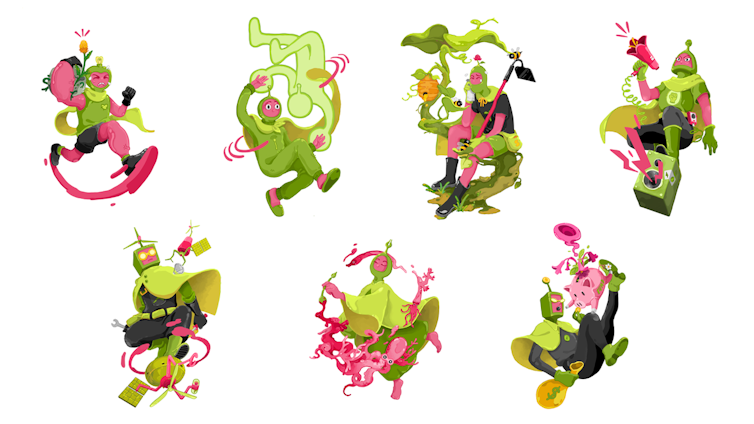
4. Political: this is about influencing governments but also people and communities. It could involve going to rallies, signing petitions or voting a certain way.
5. Financial: this doesn’t necessarily mean you have a lot of money – it could be shopping sustainably, volunteering, or influencing how others spend their money.
6. Built: this involves transforming the built environment and things we use so they are more sustainable – it could involve things like riding a bike, or influencing your family to buy solar panels.
7. Natural: are activities that help you connect to nature to do something about climate change. It could include gardening, going for a bushwalk, composting and caring for Country.
Secret Missions
Children and young people can take a quiz to find out what their strongest climate superpowers are. Then they can explore “secret missions” they can take on using these superpowers.
There are 120 missions, all based on the stories and ideas shared by the young co-designers. There are missions for learning about climate change, taking everyday action, transforming society and self-care.
These range from documentaries to watch, to tips on dealing with eco-anxiety, sustainable shopping guides, how to make sure recycled toilet paper is used at school, and tips for engaging with your local council or local MP.
Climate change is a complicated problem. To tackle it, we need all sorts of people working on all sorts of missions, big and small.
That includes young people, who have superpowers they want to use to take care of themselves, each other and the planet.
This project was funded by a Climate Research Accelerator Grant from Melbourne Climate Futures at the University of Melbourne.![]()
Phoebe Quinn, Research Fellow, The University of Melbourne and Katitza Marinkovic Chavez, Research fellow, The University of Melbourne
This article is republished from The Conversation under a Creative Commons license. Read the original article.
We created the world’s first donkey embryo using IVF in a bid to save species from extinction
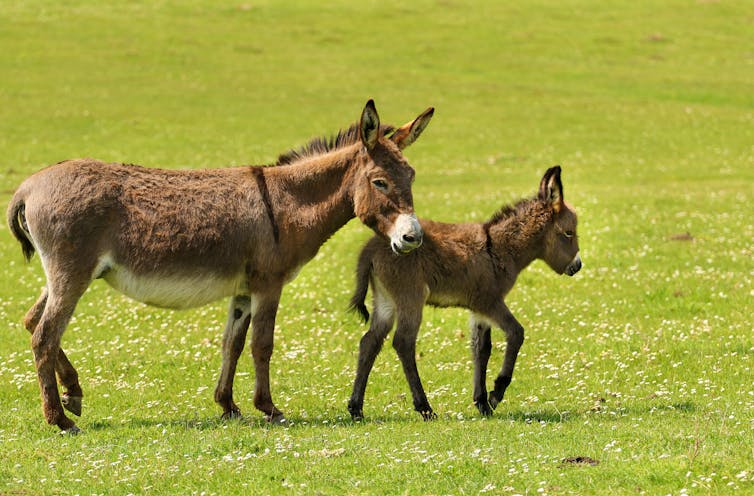
You may not realise it, but the world’s donkeys are in trouble: many domestic breeds and wild species are headed for extinction. But my colleagues and I have developed a scientific breakthrough that may contribute to saving them.
We created the world’s first successful donkey embryo using in-vitro fertilisation (IVF). The embryo, from an endangered European breed, is frozen in liquid nitrogen. We’re now searching for a suitable female donkey to grow the embryo into a baby.
We hope to apply our findings to help conserve other endangered animals. Hopefully one day, we’ll have a genetic bank of embryos that form a “frozen zoo” – creating another weapon in our conservation ass-enal, so to speak.

Donkeys In Decline
Donkeys share the same genus with horses and zebras. They’re thought to have been domesticated about 6,000 years ago and used for transport and food redistribution. They were particularly essential in the overland trade in Africa and western Asia.
Domestic donkeys are still used for transport in parts of Asia, South America and Africa. They are also kept for meat and milk production and as companion animals.
Seven of the 28 European domestic breeds are critically endangered and 20 are endangered. Populations of wild donkey species are also dwindling.
There are several reasons for this. People are using and breeding them less, and their grazing land has declined. Donkeys are also slaughtered for “ejiao”, a key ingredient in traditional Chinese food and remedies produced from collagen in donkey skin.
There’s an urgent need to improve donkey conservation programs to increase the animal’s numbers and distribution, and to broaden the genetic pool.
My research team set out to produce donkey embryos in the laboratory, in the hope of helping to repopulate species. I worked with colleagues from Argentina’s National University of Río Cuarto, and Spain’s University of Córdoba and Autonomous University of Barcelona.

What We Did
An embryo is the group of cells that form when a female egg is fertilised by male sperm.
Creating a viable donkey embryo is not easy. Once an egg is fertilised in the lab, it has only a 5% to 10% chance of growing into a good embryo that can be implanted into a female. By comparison, for horses the success rate is up to 30%.
We used an IVF process known as intracytoplasmic sperm injection (ICSI). It involves injecting a single sperm into the centre of an egg using very fine, specialist equipment.
Importantly, we added a step to the process. Before fertilising the egg, we immersed it for two days in fluids from the female donkey’s ovary. This simulates ovary conditions and gives the egg the molecules and hormones it needs to grow.
After three years of work, we produced the world’s first viable donkey embryo. It is currently frozen in a lab at the University of Cordoba in Spain.
Our research suggests that using ovary fluids as an egg matures in the lab supports the IVF process and could be more likely to lead to a viable embryo. These findings are a step forward in donkey conservation.
We produced the embryo by combining donkey semen with an egg from a different part of Spain. This aimed to avoid inbreeding problems that can occur when trying to reproduce an endangered species.
We hope to create more viable embryos and find suitable female donkeys to implant before the breeding season ends next year.
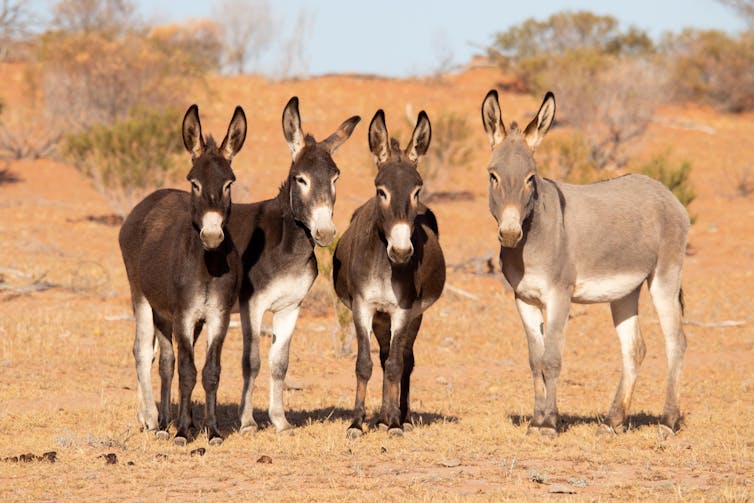
So What Next?
Throughout my research career, I’ve used assisted reproductive technologies to improve the genetic progress in a range of domestic animals. In 2020, for example, I and my colleagues reported the first in vitro zebra embryos. We now have ten frozen zebra embryos in storage, including clones.
We hope to build on our donkey embryo development, using IVF to improve the prospects of other endangered species. ![]()
Andres Gambini, Senior Lecturer, School of Agriculture and Food Science, The University of Queensland
This article is republished from The Conversation under a Creative Commons license. Read the original article.
Raves, repairs, and renewal: how young Ukrainians are bringing joy to the rebuilding effort
Clare M. Cooper, University of SydneyAfter more than 250 days of assaults from Russian forces, Ukrainian resistance is taking more surprising forms. In an attempt to reconnect to their pre-invasion cutting-edge techno scene a group of young activists have been organising “repair raves” to attract people to help with the massive clean-up effort, dancing together while they do it.
Back in August, it was estimated that over 100,000 Ukrainian houses have been destroyed, but also over 700 key cultural facilities and 20 youth centres are now in ruins. The teens and 20-somethings who would be clubbing in these spaces, are now flocking to volunteer to clear rubble, and repair infrastructure at strategically targeted raves, all while dancing to their favourite DJs.
The group of young activists and music-lovers behind Repair Together are joining a long line of grassroots design activists drawing on joy, humour and friendship – what we refer to as pleasure tactics – to attract and sustain a people-powered movement that is helping to repair a war-torn country.
What Is The ‘Repair Rave’ Movement In Ukraine?
For those new to this term – a rave is a dance party (often free, sometimes not entirely legal) where DJs play electronic music (mostly techno) to people who are committed to dancing together – and dancing hard.
After the recovery began in many of the war-ravaged towns, a group of young passionate ravers started hosting targeted repair raves to meet the need for community labour. As winter approaches, the need for clearing rubble and building housing is becoming increasingly urgent. The most recent Instagram post from Repair Together invites followers to join the raves now focused on Kyiv.
In an recent interview with Dazed one of the organisers, Marina Grebinna, shared that the raves grew from 50 volunteers at their first event in Yahidne in July 2022, to hundreds travelling from as far afield as the USA more recently.
Grebinna explains they were cautious about planning parties in places where people had died:
But it was a good way to involve a lot of people, and we really wanted to make volunteering seem like a lifestyle choice… Now, after three months of work on this project, we see a lot of familiar faces. A lot of people do it on a regular basis now.
Responsive, creative, community-driven events like these have two powerful effects. The first is for those directly affected by the violence of war – reconnecting to one another and to a culture and music that they love, resisting the physical and spiritual oppression of war.
The second is for those who have become desensitised to the tragic news of the ongoing conflict, who are drawn in once again due to the seeming incongruity of the pleasure alongside the violence and loss. The idea that people could be enjoying themselves – even raving – during wartime efforts to restore some sense of “home” doesn’t fit with what we consider a picture of conflict, grief, and suffering.
Dancing The Talk
The Repair Together events are a perfect example of the kind of grassroots design activism that is not instantly recognised as activism.
Volunteers connect to one another through music, but also spend time listening to stories of the survivors in these towns as they work, bolstering their resolve to create their “new Ukraine”. The visual communication (collages on social media, videos of events) are all invitations to combat the paralysis of oppressive violence and be a proactive part of this future.
It is a beautiful example of the design futuring I research and teach - where people share detailed parts of the futures or society they desire, and then get their hands dirty building it together - not waiting around for it to be done for them/us.
These repair raves sit within a rich history of activism that takes on surprising forms, intersecting with cultural events in new ways, and involving people beyond fundraising, rallies, or petitions by focusing on what design researcher Lenskjold refer to as denoting “collaboration rather than persuasion” in this 2015 journal article.
Parties With Purpose, And Transitional Neighbourhoods
Here in Australia we’re familiar with parties with purpose. Queer and First Nations communities have led the way with Sydney Mardi Gras, and free party crews like Ohms Not Bombs (“dig the sounds not uranium”) have been attracting people to party while protesting for over 30 years.
The direct community clean-up, design, and rebuilding of the Repair Together movement mirrors the creative collaboration of post-quake Christchurch residents. After 80% of the central city was destroyed, and over 10,000 houses demolished, the “urban recovery and transformation” took surprising forms such as washing-machine powered dance-o-mats, and port-a-loo beautification.
Several years after the quake, chair of the Christchurch Transitional Architecture Trust Dr Barnaby Bennet said,
Hundreds of temporary and transitional projects continue to pop up in the city. International interest in forms of adaptive urbanism and temporary architecture have led to media outlets such as The New York Times and Lonely Planet hailing the vibrant and innovative nature of this projects as a symbol of recovery.
Earnest Activism Is Over, Bring On The Pleasure
Fatigue and paralysis are common responses to overlapping crises and horrific information.
This is especially true for long-term and overlapping struggles. If your actions and activism don’t bear fruit then it is hard to keep it up. A common approach is to burn hard, and burn out, with the next batch of volunteers following suit. This has been endemic in environmentalist fights, and certainly exists in all battles against systemic problems like racism and sexism, which at times – even with small wins – seem insurmountable.
But activism can take surprising and joyful forms, intersecting with cultural events and ways of being together that actually energise, connect and inform people.
We need to learn from these creative approaches – especially as anti-protest laws (particularly relating to climate activism) continue to escalate.![]()
Clare M. Cooper, Design Lecturer, University of Sydney
This article is republished from The Conversation under a Creative Commons license. Read the original article.
Star Wars Andor captures the essence of resistance that is happening in the real world

Andor is the newest Star Wars series on Disney+. It tells the backstory of Cassian Andor, one of the heroes who helped steal the Death Star plans in the 2016 film Rogue One (itself a prequel to the original Star Wars movie from 1977).
\As the series draws to a close, Andor has become a favourite for Star Wars fans. This is despite that fact that it has yet to mention the Force or the Jedi and there hasn’t even been a lightsaber.
One of the major appeals of the show is the level of detail and “everydayness” that it depicted. The characters from the evil, imperialistic and in many cases, overtly fascist Galactic Empire are, in the grand scheme of things, relatively low-level. It optimises what cultural theorist Hannah Arendt, in describing the everyday seemingly mindless tasks undertaken by some of those in the Nazi Party, called “the banality of evil”.
Take the fast-rising military tactical supervisor Dedra Meero and the embittered civil servant-style employee Syril Karn. They are seen scouring reports, sat behind desks, performing menial tasks and in Karn’s case, living at home with his overbearing mother.
It is the intricacy of their work, the levels of bureaucracy and military hierarchy they must navigate, that characterises the massive scale and sheer terror of the Empire. In this, it also not-so-subtly critiques the military-industrial complex by exposing the intricate (and often fraught) links between private military corporations and state.
The series also takes a great deal of care to build up the rebels’ backstories, giving far more emotional weight to their reasons for rebelling. The rebel networks of deceit and subterfuge that the show painstakingly outlines adds real complexity, dynamism and a heightened sense of jeopardy that is somewhat missing from the fast-paced stories of the Star Wars cinematic films.
In essence, Andor is the “grown-up” Star Wars story that many of the fans were craving after the rather one-dimensional and insipid calamity that was Star Wars: The Rise of Skywalker.
But there is a deeper reason I think that Andor is striking a chord: it is capturing the essence of resistance that is happening in the real world around us.
There are the people in Iran protesting against the country’s strict laws. Climate activism is increasing across the world, Black Lives Matter movements continue to fight against institutional racism, reproductive rights groups are campaigning again in the US and resistance is increasing against rampant transphobia. There are very real, and widespread networks of activism across the world.
As Star Wars creator Geroge Lucas has stated, the saga has always been about rebellion against colonialism and fascism. That’s why Andor really is a true Star Wars story and why it speaks very intimately to the troubles, but also the exhilaration and specific triumphs, of effective resistance campaigns and debates around how action should be “done”.
Life-Long Resistance
The series introduces us to one of the “lead” organisers of the rebellion, Luthen. Luthen is “hiding in plain site” in the Empire, where he poses as a wealthy antiques shop owner while secretly coordinating rebel activities.
In his utterly captivating and brilliantly written monologue at the end of Episode ten “One Way Out”, he encapsulates the deep sacrifices he had made for life-long resistance. This is brilliantly summed up with the quite haunting line: “I burn my life to make a sunrise I know I’ll never see.”
This again echoes the many times we have heard climate activists claim that they risk jail time, ridicule and everything else that comes with activism because they want a better future for the children – a future they might never see.
For scholars of activism like myself, one of the more intriguing lines from the speech is: “I’m condemned to use the tools of my enemy to defeat them.” Here, he is talking about having to live a lie in order to infiltrate the Empire. But these lines also importantly echo a very live debate in activist and academic circles about how resistance should be “done”.
Whose Tools Should Be Used?
To summarise the argument, a more traditional Marxist approach will agree with Luthen, that to defeat the enemy, you must use their tools in a moment of insurrection. This is essentially a political argument that says to change the world, you have to achieve power first. Through political pressure or, if needed, full-scale revolution (such as in Russia in 1917), the aim is to seize power first before using that power to affect change.
More feminist and anarchist approaches will argue that resistance means building your own house with tools you create yourself. This is perhaps most famously captured by the words of the American civil rights activist and poet Audre Lorde who wrote the now famous words: “The master’s tools will never dismantle the master’s house.”
She is arguing here that we cannot solve problems of oppression working with the tools of a system of oppression. This thinking sees activism as less about changing the system so that it supports us better, but building entirely new systems.
The show teases this form of activism with Vel and Cinta, two rebels who are in a relationship. After a major successful heist against the Empire, Vel seems to want to run away with Cinta, to stop fighting and leave the system of oppression that they currently operate in and instead forge new lives under new systems of their own making. And in a more subtle, “soft” form of activism, the indigenous people of the occupied planet of Aldhani are seen maintaining their “folk” traditions in spite of clear disdain from the colonial imperial occupiers.
But whichever side of this activist positioning people are on, Andor shows the struggles of attempting each. The time spent detailing the nuances of the Empire’s fascism as well as the various practices of resistance that grow to meet it are why I think Andor is as popular as it is.
In a world where all sorts of groups are fighting for different causes, there are debates about the right and wrong way to go about enacting change. Art and cultures thrives when it speaks to the real world.![]()
Oli Mould, Reader in Human Geography, Royal Holloway University of London
This article is republished from The Conversation under a Creative Commons license. Read the original article.
Synchrony with chaos – blinking lights of a firefly swarm embody in nature what mathematics predicted
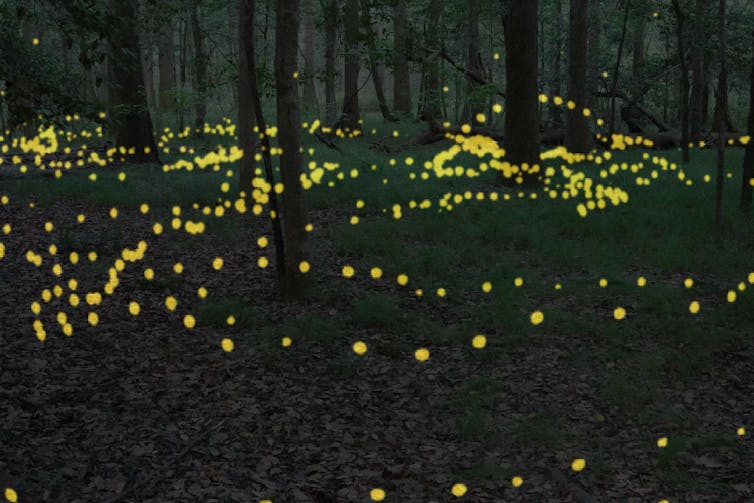
Imagine an old-growth forest in the fading light of a summer evening. As the last of the sun’s rays disappear beneath the horizon, a tiny flash catches your eye.
You turn around, hold your breath; it blinks again, hovering 2 feet above the leaf litter. Across the dusky glade, a fleeting response. Then another one, and another, and within minutes flickering fireflies spread all over the quiet woods.
At first they seem disorganized. But soon a few coordinated pairs appear, little tandems flashing on the same tempo twice a second. Pairs coalesce into triads, quintuplets, and suddenly the entire forest is pulsating with a common, glittering beat. The swarm has reached synchrony.
Firefly congregations are sprawling speed-dating events. Flashes convey a courtship dialogue between advertising males and selective females. Shaped by the interplay of competition and cooperation among thousands of fireflies in interaction, collective light patterns emerge, twinkling analogs to the murmurations of bird flocks swooping together. The mystifying phenomenon of some fireflies’ flash synchronization has puzzled scientists for over a century.
Synchrony is ubiquitous throughout the universe, from electron clouds to biological cycles and planetary orbits. But synchrony is a complex concept with many ramifications. It encompasses various shapes and forms, usually revealed by mathematics and later explored in nature.
Take the firefly swarm. Wait a little longer and among the illuminated chorus, something else appears: Some discordant flashers secede and continue off-beat. They blink at the same pace but keep a resolute delay with their conformist peers. Could this be evidence of a phenomenon predicted by mathematical equations but never seen in nature before?
Synchrony, With A Twist
Twenty years ago, while digging deeper into the equations that form the framework of synchrony, physicists Dorjsuren Battogtokh and Yoshiki Kuramoto noticed something peculiar. Under specific circumstances, their mathematical solutions would describe an ambivalent ensemble, showing widespread synchrony interspersed with some erratic, free-floating constituents.
Their model relied on a collection of abstract clocks, called oscillators, that have a tendency to align with their neighbors. The nonuniform state was surprising, because the equations assumed all oscillators were perfectly identical and similarly connected to others.
Spontaneous breaking of underlying symmetry is something that typically bothers physicists. We cherish the idea that some order in the fabric of a system should translate into similar order in its large-scale dynamics. If oscillators are indistinguishable, they should either all get in sync, or all remain chaotic – not show differentiated behaviors.
It piqued the curiosity of many, including mathematicians Daniel Abrams and Steven Strogatz, who named the phenomenon “chimera.” In Greek mythology, the Chimera was a hybrid monster made of parts of incongruous animals – so a fitting name for a hodgepodge of mismatched clusters of oscillators.
At first, chimeras were rare in mathematical models, requiring a very specific set of parameters to materialize. Over time, learning where to scout, theorists began to uncover them in many variations of these models, dubbing them “breathing,” “twisted,” “multiheaded” and other eerie epithets. Still, it remained mysterious whether these theoretical chimeras were also possible in the physical world – or merely a mathematical myth.
A decade later, a few ingenious experiments set up in physics laboratories yielded the elusive chimeras. They involved finely tuned networks of interactions between sophisticated oscillators. While proving that engineering the coexistence of coherence and incoherence was a delicate, but possible, venture, they left the deeper question unanswered: Could mathematical chimeras also exist within the natural world?
It turned out it would take a tiny luminescent insect to shed light on them.
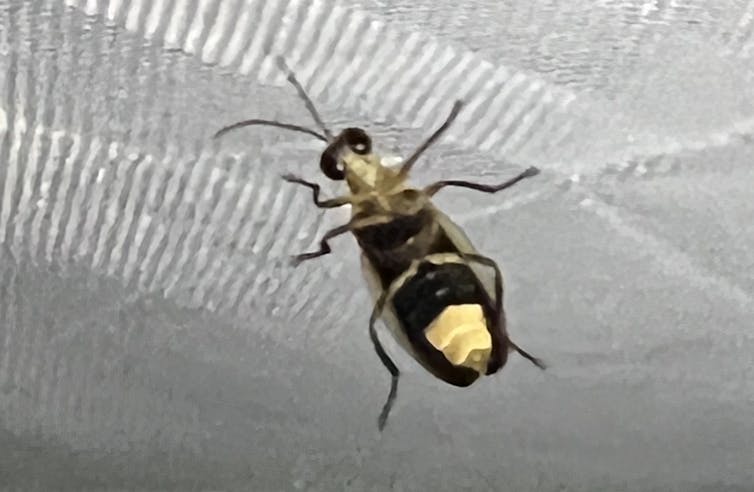
Chimera Amid The Fireflies’ Blinking Chorus
As a postdoc in the Peleg Lab at the University of Colorado, I work on deciphering the inner workings of firefly swarms. Our approach builds on the foundations of a little-known niche within modern physics: animal collective behavior. Simply put, the overarching objective is to reveal and characterize spontaneous, unsupervised large-scale patterns in the dynamics of groups of animals. We then investigate how these self-organized patterns emerge from individual interactions.
Advised by knowledgeable firefly experts, my colleagues and I drove across the country to Congaree National Park in South Carolina to chase Photuris frontalis, one of few North American species known to synchronize. We set up our cameras in a small forest clearing among the loblolly pines. Soon after the first flickers poked through the twilight, we observed a very rhythmic, precise synchrony, apparently as clean as predicted by equations.
This was an enchanting experience, yet one that left me reflective. I worried that this display was too orderly to let us infer anything from it. Physicists learn about things by looking at their natural fluctuations. Here, there seemed to be little variability to investigate.
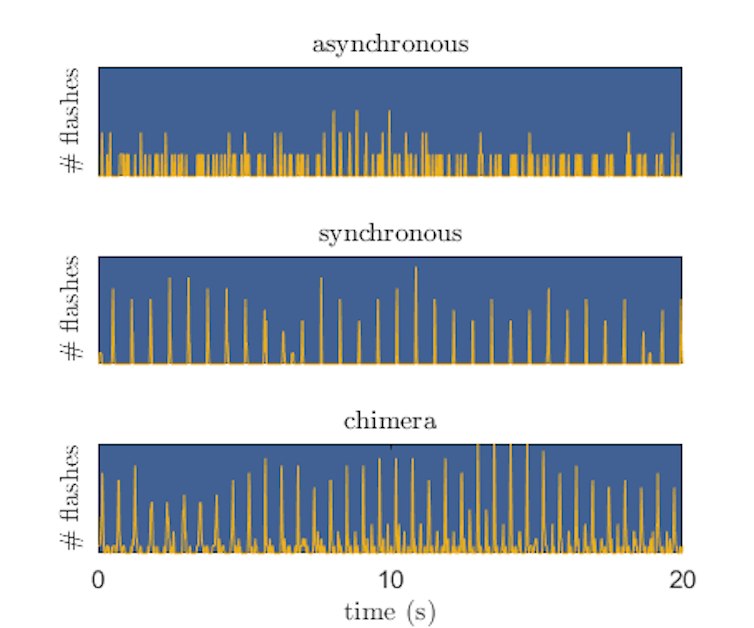
Synchrony manifests itself in the data in the form of sharp spikes in the graph of the number of flashes over time. These peaks indicate that most flashes occur at the same instant. When they don’t, the trace looks irregular, like scribbles. In our plots, I first saw nothing but the flawless comblike pattern of impeccable synchrony.
It turned out the chimera was hiding in plain sight, but I had to roam further along the data to encounter it. There, in between the spikes of the light chorus, some shorter peaks indicated smaller factions in sync among themselves but not with the main group. I called them “characters.” Together with the synchronized chorus, these incongruous characters make up the chimera.
Like in the ancient Greek theater, the chorus sets the background while characters create the action. The two groups are intertwined, roaming the same stage, as we revealed from the three-dimensional reconstruction of the swarm. Despite the split in their rhythm, their spatial dynamics appear indistinguishable. Characters don’t seem to congregate or follow one another.
This unexpectedly intermingled self-organization raises even more questions. Do characters among the swarm consciously decide to break away, maybe to signal their emancipation? Or do they spontaneously find themselves trapped off-beat? Can mathematical insights enlighten the social dynamics at play among luminous beetles?
Unlike abstract oscillators in math equations, fireflies are cognitive beings. They incorporate complex sensory information and process it through a decision-making pipeline. They are also constantly in motion, forming and breaking visual bonds with their peers. Streamlined mathematical models don’t yet capture these intricacies.
In the quiet woods, the synchronized flashes and their dissonant counterparts may have illuminated a trove of new chimeras for mathematicians and physicists to chase.![]()
Raphael Sarfati, Postdoctoral Associate, University of Colorado Boulder
This article is republished from The Conversation under a Creative Commons license. Read the original article.
Artemis 1 is off – and we’re a step closer to using Moon dirt for construction in space

NASA has just launched its first rocket in the Artemis program, which will, among other things, take scientific experiments to produce metal on the Moon.
In recent years, a number of businesses and organisations have ramped up efforts to establish technologies on the Moon. But doing work in space is expensive. Sending just one kilogram of material to the Moon can cost US$1.2 million (A$1.89 million).
What if we could save money by using the resources that are already there? This process is called in-situ resource utilisation, and it’s exactly what astrometallurgy researchers are trying to achieve.
Why The Moon?
The Moon has amazing potential for future space exploration. Its gravity is only one-sixth as strong as Earth’s, which makes it much easier to fly things from the Moon to Earth’s orbit than to fly them direct from Earth! And in an industry where every kilogram costs a fortune, the ability to save money is extremely attractive.
Although people have been looking at making oxygen and rocket fuel in space for decades, the Artemis program marks the first time we have solid plans to make and use metal in space.
A number of companies are looking at extracting metals and oxygen from Moon dirt. At first these will be demonstrations, but eventually Moon metal will be a viable option for construction in space.
As a researcher in this field, I expect that in about 10 to 20 years from now we’ll have demonstrated the ability to extract metals from the Moon, and will likely be using these to construct large structures in space. So exactly what will we be able to extract? And how would we do it?
What’s Out There?
There are two main geological regions on the Moon, both of which you can see on a clear night. The dark areas are called the maria and have a higher concentration of iron and titanium. The light areas are called the highlands (or terrae) and have more aluminium.
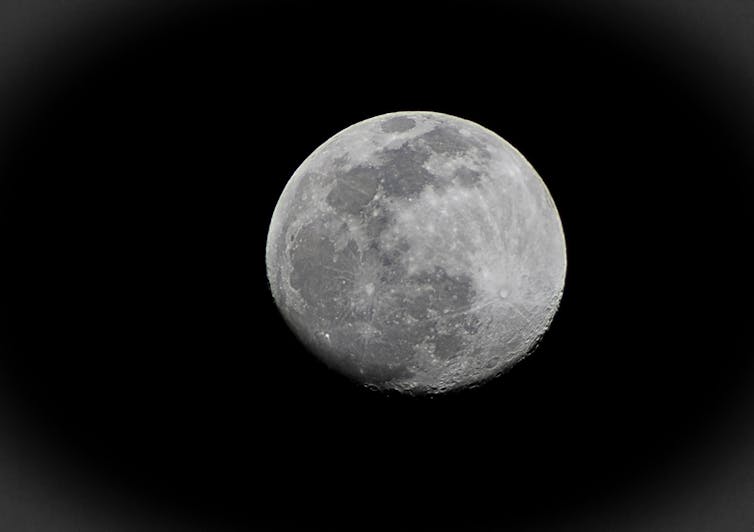
In general, the dirt and rocks on the Moon contain silicon, oxygen, aluminium, iron, calcium, magnesium, titanium, sodium, potassium and manganese. That might sound like a mouthful, but it’s not really that much to choose from. There are some other trace elements, but dealing with those is a spiel for another day.
We know metals such as iron, aluminium and titanium are useful for construction. But what about the others?
Well, it turns out when you have limited options (and the alternative is spending a small fortune), scientists can get pretty creative. We can use silicon to make solar panels, which could be a primary source of electricity on the Moon. We could use magnesium, manganese and chromium to make metal alloys with interesting properties, and sodium and potassium as coolants.
There are also studies looking at using the reactive metals (aluminium, iron, magnesium, titanium, silicon, calcium) as a form of battery or “energy carrier”. If we really needed to, we could even use them as a form of solid rocket fuel.
So we do have options when it comes to sourcing and using metals on the Moon. But how do we get to them?
How Would Extraction Work?
While the Moon has metals in abundance, they’re bound up in the rocks as oxides – metals and oxygen stuck together. This is where astrometallurgy comes in, which is simply the study of extracting metal from space rocks.
Metallurgists use a variety of methods to separate metals and oxygen from within rocks. Some of the more common extraction methods use chemicals such as hydrogen and carbon.
Some such as “electrolytic separation” use pure electricity, while more novel solutions involve completely vaporising the rocks to make metal. If you’re interested in a full rundown of lunar astrometallurgy you can read about it in one of my research papers.
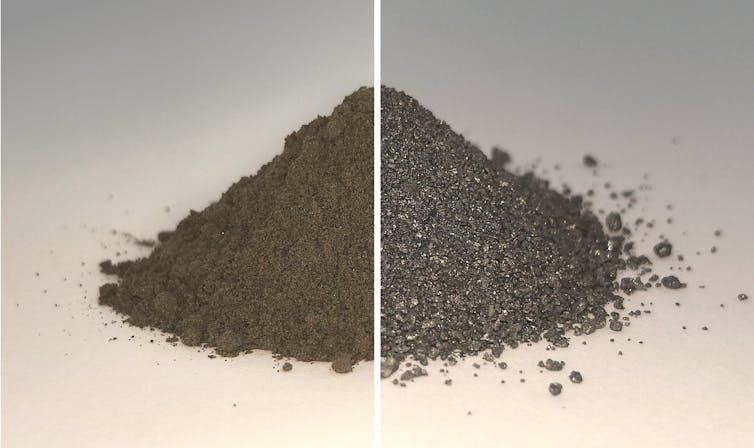
Regardless of the method used, extracting and processing metals in space presents many challenges.
Some challenges are obvious. The Moon’s relatively weak gravity means traction is basically nonexistent, and digging the ground like we do on Earth isn’t an option. Researchers are working on these problems.
There’s also a lack of important resources such as water, which is often used for metallurgy on Earth.
Other challenges are more niche. For instance, one Moon day is as long as 28 Earth days. So for two weeks you have ample access to the Sun’s power and warmth … but then you have two weeks of night.
Temperatures also fluctuate wildly, from 120℃ during the day to -180℃ at night. Some permanently shadowed areas drop below -220℃! Even if resource mining and processing were being done remotely from Earth, a lot of equipment wouldn’t withstand these conditions.
That brings us to the human factor: would people themselves be up there helping out with all of this?
Probably not. Although we’ll be sending more people to the Moon in the future, the dangers of meteorite impacts, radiation exposure from the Sun, and extreme temperatures mean this work will need to be done remotely. But controlling robots hundreds of thousands of kilometres away is also a challenge.
It’s not all bad news, though, as we can actually use some of these factors to our advantage.
The extreme vacuum of space can reduce the energy requirements of some processes, since a vacuum helps substances vaporise at lower temperatures (which you can test by trying to boil water on a tall mountain). A similar thing happens with molten rocks in space.
And while the Moon’s lack of atmosphere makes it uninhabitable for humans, it also means more access to sunlight for solar panels and direct solar heating.
While it may take a few more years to get there, we’re well on our way to making things in space from Moon metal. Astrometallurgists will be looking on with keen interest as future Artemis missions take off with the tools to make this happen.![]()
Matthew Shaw, PhD Candidate - Astrometallurgy, Swinburne University of Technology
This article is republished from The Conversation under a Creative Commons license. Read the original article.
NASA’s Artemis 1 mission to the Moon sets the stage for routine space exploration beyond Earth’s orbit – here’s what to expect and why it’s important

NASA’s Space Launch System rocket lifted off from the Kennedy Space Center in Cape Canaveral, Florida, in the early hours of Nov. 16, 2022. The rocket carried the Orion Crew Capsule as the centerpiece of the Artemis 1 mission. The journey to the Moon and back is a shakedown cruise with no people aboard – it will test how the Orion Crew Capsule holds up in space. The mission is a key step toward returning humans to the Moon after a half-century hiatus. The launch was initially scheduled for the morning of Aug. 29, 2022, but was postponed three times, twice for technical reasons and once for Hurricane Ian.
The spacecraft is scheduled to travel to the Moon, deploy some small satellites and then settle into orbit. NASA aims to practice operating the spacecraft, test the conditions crews will experience on and around the Moon, and assure everyone that the spacecraft and any occupants can safely return to Earth.
The Conversation asked Jack Burns, a professor and space scientist at the University of Colorado Boulder and former member of the Presidential Transition Team for NASA, to describe the mission, explain what the Artemis program promises to do for space exploration, and reflect on how the space program has changed in the half-century since humans last set foot on the lunar surface.
How Does Artemis 1 Differ From The Other Rockets Being Launched Routinely?
Artemis 1 is the first flight of the new Space Launch System. This is a “heavy lift” vehicle, as NASA refers to it. It is the most powerful rocket engine ever flown to space, even more powerful than Apollo’s Saturn V system that took astronauts to the Moon in the 1960s and ‘70s.
It’s a new type of rocket system, because it has both a combination of liquid oxygen and hydrogen main engines and two strap-on solid rocket boosters derived from the space shuttle. It’s really a hybrid between the space shuttle and Apollo’s Saturn V rocket.
You can listen to more articles from The Conversation, narrated by Noa, here.
Testing is very important, because the Orion Crew Capsule is going to be getting a real workout. It will be in the space environment of the Moon, a high-radiation environment, for a month. And, very importantly, it will be testing the heat shield, which protects the capsule and its occupants, when it comes back to the Earth at 25,000 miles per hour. This will be the fastest capsule reentry since Apollo, so it’s very important that the heat shield function well.
This mission is also carrying a series of small satellites that will be placed in orbit of the Moon. Those will do some useful precursor science, everything from looking further into the permanently shadowed craters where scientists think there is water to just doing more measurements of the radiation environment, seeing what the effects will be on humans for long-term exposure.
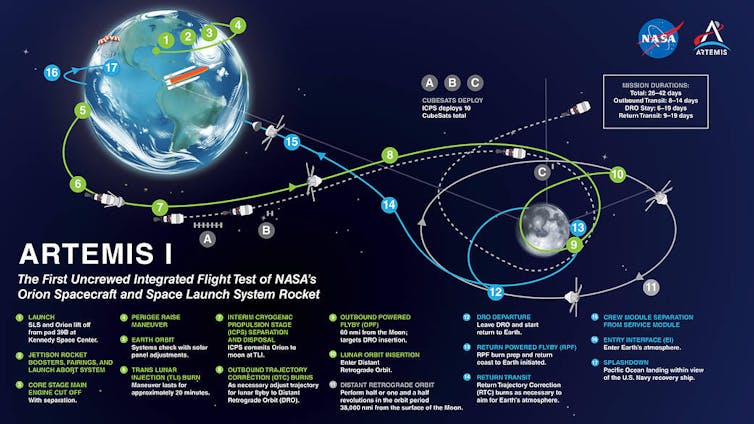
What’s The Goal Of The Artemis Project? What’s Coming Up In The Series Of Launches?
The mission is a first step toward Artemis 3, which is going to result in the first human missions to the Moon in the 21st century and the first since 1972. Artemis 1 is an uncrewed test flight.
Artemis 2, which is scheduled to launch a few years after that, will have astronauts on board. It, too, will be an orbital mission, very much like Apollo 8, which circled the Moon and came back home. The astronauts will spend a longer time orbiting the Moon and will test everything with a human crew.
And, finally, that will lead to a journey to the surface of the Moon in which Artemis 3 – sometime middecade – will rendezvous with the SpaceX Starship and transfer crew. Orion will remain in orbit, and the lunar Starship will take the astronauts to the surface. They will go to the south pole of the Moon to look at an area scientists haven’t explored before to investigate the water ice there.
Artemis Is Reminiscent Of Apollo. What Has Changed In The Past Half-Century?
The reason for Apollo that Kennedy envisioned initially was to beat the Soviet Union to the Moon. The administration didn’t particularly care about space travel, or about the Moon itself, but it represented an audacious goal that would clearly put America first in terms of space and technology.
The downside of doing that is the old saying “You live by the sword, you die by the sword.” When the U.S. got to the Moon, it was basically game over. The United States beat the Russians. So it put some flags down and did some science experiments. But pretty quickly after Apollo 11, within a few more missions, Richard Nixon canceled the program because the political objectives had been met.

So fast-forward 50 years. This is a very different environment. The U.S. is not doing this to beat the Russians or the Chinese or anybody else, but to begin a sustainable exploration beyond Earth’s orbit.
The Artemis program is driven by a number of different goals. It includes in situ resource utilization, which means using resources at hand like water ice and lunar soil to produce food, fuel and building materials.
The program is also helping to establish a lunar and space economy, starting with entrepreneurs, because SpaceX is very much part of this first mission to the surface of the Moon. NASA doesn’t own the Starship but is buying seats to allow astronauts to go to the surface. SpaceX will then use the Starship for other purposes – to transport other payloads, private astronauts and astronauts from other countries.
Fifty years of technology development means that going to the Moon now is much less expensive and more technologically feasible, and much more sophisticated experiments are possible when you just figure the computer technology. Those 50 years of technological advancement have been a complete game-changer. Almost anybody with the financial resources can send spacecraft to the Moon now, though not necessarily with humans.
NASA’s Commercial Lunar Payload Services contracts private companies to build uncrewed landers to go to the Moon. My colleagues and I have a radio telescope that’s scheduled to go to the Moon on one of the landers in March. That just wouldn’t have been possible even 10 years ago.
What Other Changes Does Artemis Have In Store?
The administration has said that in that first crewed flight, on Artemis 3, there will be at least one woman and very likely a person of color. They may be one and the same. There may be several.
I’m looking forward to seeing more of that diversity, because young kids today who are looking up at NASA can say, “Hey, there’s an astronaut who looks like me. I can do this. I can be part of the space program.”
This article was updated on Nov. 16, 2022, to indicate that NASA launched the rocket.![]()
Jack Burns, Professor of Astrophysical and Planetary Sciences, University of Colorado Boulder
This article is republished from The Conversation under a Creative Commons license. Read the original article.
U3A At Newport: Geoff Searl This Coming Tuesday 22nd
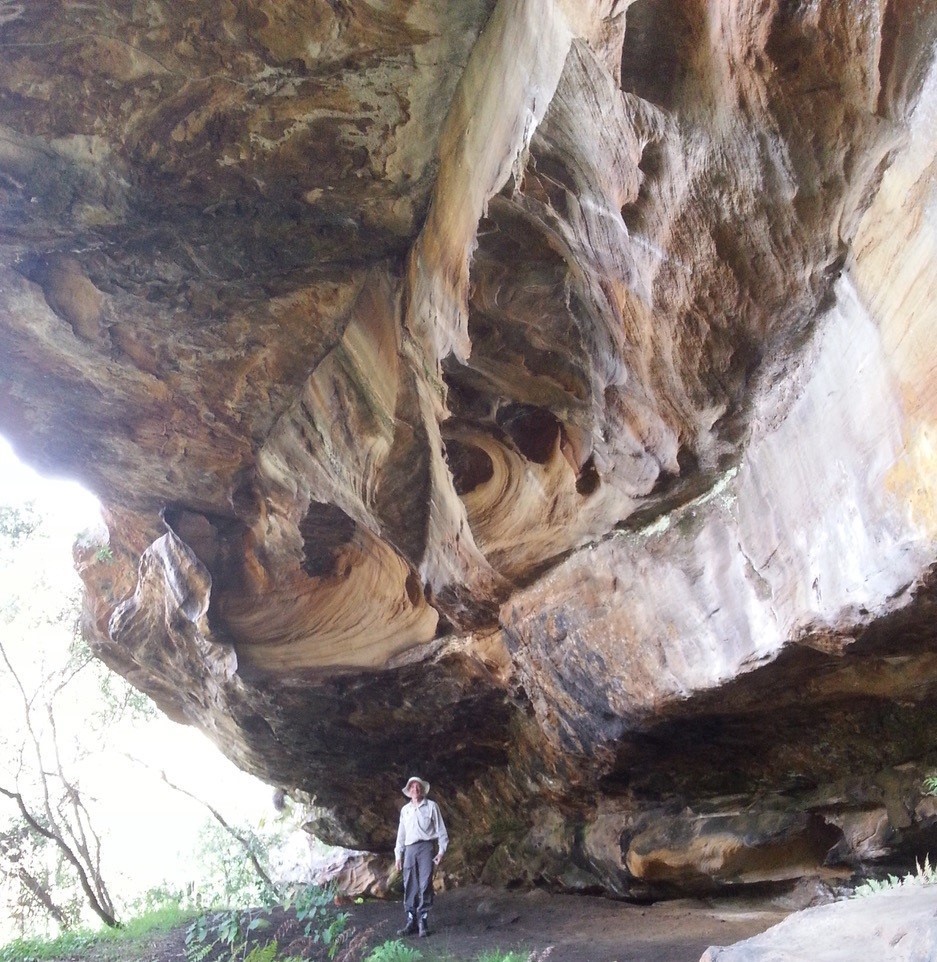
Home Care Pricing Caps A Win For Older Australians: COTA Australia
- care management prices will be capped at 20% of the package level
- package management prices will be capped at 15% of the package level
- providers cannot charge for package management in a calendar month where no services (other than care management) are delivered, except for the first month of care
- providers cannot charge separately for third party services (including brokerage, handling and subcontracting charges)
- providers cannot charge exit amounts.
Changes To Stop Home Care Overcharging
More Ways For Seniors To Get Involved In 2023 NSW Seniors Festival
- Friends of Ivanhoe Park Botanical Garden Inc., Manly - Walks and Talks in Ivanhoe Park Manly
- RSL LifeCare Ltd., Pittwater - War Vets Art Exhibition & Workshops
Premier's Gala Concerts
U3A Activities
- A day trip to Mount Wilson on 5 October (details on page 9);
- Our annual picnic on 20 October, this year at Clontarf Reserve (details on page 10); and
- Tunnels and Gunners Tour, with a guide from the Sydney Harbour Trust, on 3 November (details on page 10.
Ageism in tech: Older adults should be included in the design of new technologies
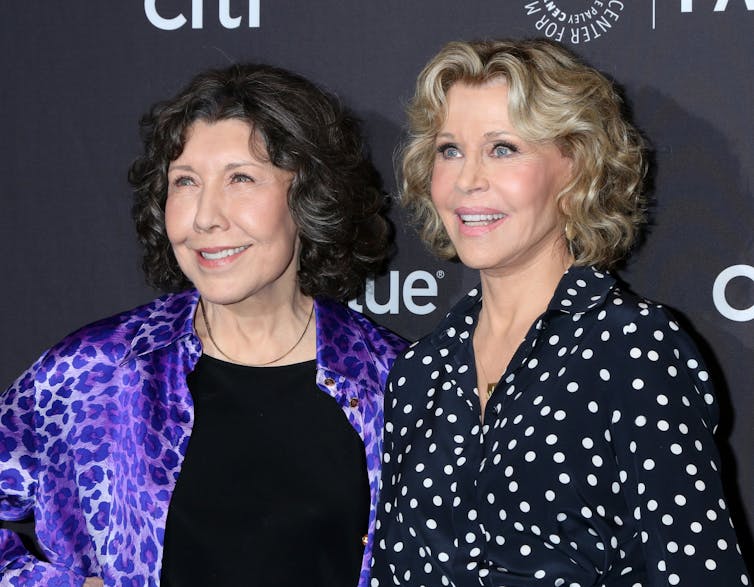
Ageism refers to the stereotypes (how we think), prejudice (how we feel) and discrimination (how we act) we might hold towards others or ourselves based on age.
Ageism is a unique form of discrimination, given that it’s universal — it’s often referred to as the last acceptable form of discrimination. Ageism often intersects with other forms of discrimination, including sexism, racism and ableism.
When it comes to the development and distribution of technology, ageism has important implications. It not only shapes whether new technologies are adopted by older adults, but it also influences how new technologies are developed and marketed.
In recent years, there has been increasing awareness of how digital technologies and platforms can discriminate on the bases of gender, race and class. However, ageism has received less attention.
Artificial intelligence, health-care technologies, and monitoring and surveillance systems, among others, are increasingly being integrated into the lives of older people.

Technologies play vital roles in everyday life, and it is important to investigate how older people’s uses of technology are influenced by ageism, self-perception and identity.
As a social gerontologist interested in ageism (Stephanie Hatzifilalithis), my questions are threefold: 1) Why don’t we do our best to create technologies that are based on principles of universal design? 2) How does ageism affect technology, and vice versa? and 3) Why aren’t we listening to older people when designing tech for their use?
People Like Us
In a 2017 episode of the Netflix show Grace and Frankie, the protagonists (played by Jane Fonda, now 84 and Lily Tomlin, 83), decide to revolutionize the vibrator market to “create products for people like us.”
After Grace suffers an arthritis flare-up caused by using a sex toy, the friends design a vibrator that conforms to principles of universal design. Grace and Frankie then try to pitch their product, with little luck.
While Grace and Frankie are forces to be reckoned with, they are fictional characters. In the real world, workers at the biggest tech companies are overwhelmingly young, white and male.
In my postdoctoral work with social and critical gerontologist Nicole Dalmer, we study how ageism is both produced and reproduced in the context of experience and design. We look at how older people think about, talk about and experience the technologies (and their related data) that play a role in their lives.
We are also interested in how those who are involved in the design and development of technologies understand the potential effects of ageism.
Involving Older People
Our work is part of a growing movement towards the importance and appreciation of person-centered, participatory and visual design and research methods. Other researchers have suggested a framework to guide co-designing technology with older people.
Co-design is a well-established design approach that isn’t widely used yet among older people. It is an important aspect of our current research to ensure that our project is informed, directed and influenced by older people, and that the project’s outcomes are meaningfully aligned with their needs, experiences and expertise.
By focusing on both designers and older-adult end-users, we hope that our research will highlight best practices in the development of technologies that support independent living and enhance social participation in later life in a meaningful way.
This will not only help to avoid costly barriers to technology adoption, but will help alleviate the increasing challenges of technologically related discrimination, exclusion, and inclusion that both explicitly and implicitly colour and shape experiences of aging.
Researchers, designers and technology developers need to take the initiative and spend time to think through personal biased related to age-based stereotypes to design tech with older people.![]()
Stephanie Hatzifilalithis, Postdoctoral Fellow, McMaster Institute for Research on Aging, McMaster University and Nicole Dalmer, Assistant Professor in the Department of Health, Aging and Society, McMaster University
This article is republished from The Conversation under a Creative Commons license. Read the original article.
AvPals Training Term 4 2022 At Newport
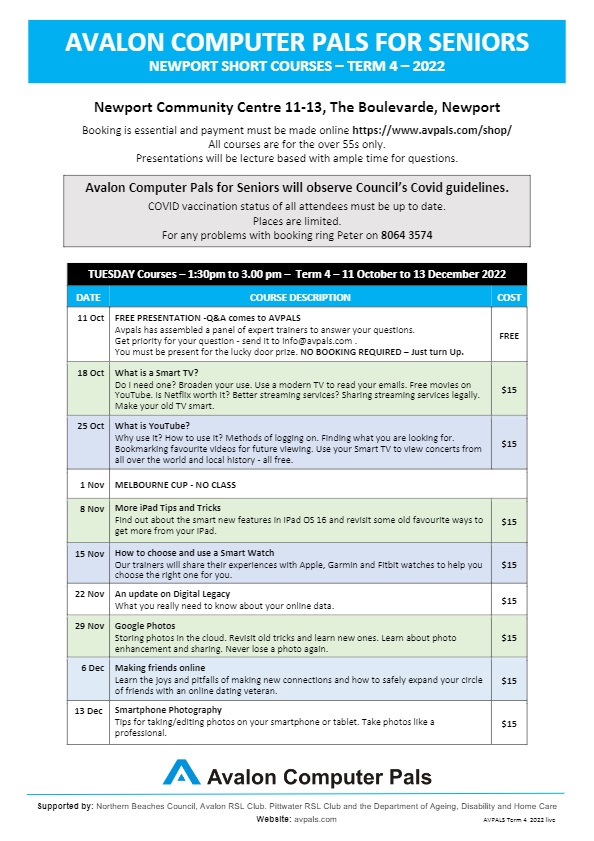
Unlocking new clues to how dementia and Alzheimer’s work in the brain – Uncharted Brain podcast series
Gemma Ware, The Conversation and Paul Keaveny, The ConversationThis week on The Conversation Weekly podcast we’re running a three-part series called Uncharted Brain: Decoding Dementia, which delves into new research searching for answers to how dementia works in the brain and the damage it leaves behind. Hosted by Paul Keaveny and Gemma Ware, it was initially published via The Anthill podcast from the team at The Conversation in the UK.
In the first episode, we explore how a study which began just after the end of the second world war is discovering clues to Alzheimer’s.
Based on a representative sample of 5,362 babies all born in the same week in the UK in 1946, the National Survey of Health and Development began as a one-off investigation of the cost of childbirth and the quality and efficiency of obstetric services. From there it became the longest continuously running study of health over the human life course in the world – also known as the British 1946 birth cohort.
Since 2016, the brains of some of its participants are revealing new insights into the risk factors for Alzheimer’s disease. We find out more from Marcus Richards and Jon Schott, two of the researchers from UCL in the UK behind the study, and David Ward, one of the study participants whose brain is being studied as part of the dementia research.
Parts two and three of the series will follow in The Conversation Weekly later this week.
Uncharted Brain: Decoding Dementia is reported by Paul Keaveny, investigations editor at The Conversation in the UK for the Insights team, which published articles linked to each of the episodes in this podcast series. The series is produced and written by Tiffany Cassidy with sound design by Eloise Stevens. The executive producer and co-host is Gemma Ware. The Conversation Weekly theme music is by Neeta Sarl.
You can find us on Twitter @TC_Audio, on Instagram at theconversationdotcom or via email.![]()
Gemma Ware, Editor and Co-Host, The Conversation Weekly Podcast, The Conversation and Paul Keaveny, Investigations Editor, Insights, The Conversation
This article is republished from The Conversation under a Creative Commons license. Read the original article.
Dover Police DashCam Confessional
From 2015 - we've run this before but it remains a favourite, so we're running it again!
The clip shows Delaware Master Cpl. Jeff Davis, a then 19-year veteran with the Dover Police Department, driving a patrol car while lip-syncing and dancing to the popular 'Shake It Off' Taylor Swift song, replete with head rolls and finger-pointing.
The video was posted to the Dover Police Department's Facebook page and quickly amassed thousands of views in Australia, England, Germany and throughout the U.S. Just one day after the video was posted, the clip had 845,000 views on YouTube. Today it's over 45 million - proving we're not the only ones who like revisiting this great clip.
Wings Over Illawarra 2022: Some Brilliant New + Old Machines + Some History Of Pittwater's 'Aces' By Joe Mills And LAC Chris Tsakisiris
ATAGI Update On Boosters Following COVID-19 Meeting
- ATAGI has made no new recommendations at this time, including no changes to the number of COVID-19 vaccine booster doses recommended.
- ATAGI emphasises the importance of remaining up to date with recommended doses of COVID- 19 vaccines, especially for people aged 65 years and older and those at higher risk of severe COVID-19:
- As of 9 November 2022, 5.5 million eligible people living in Australia (27.8% of the eligible population) had not received a first booster dose, and 3.2 million people aged 50 years and older (42.7%) had not received a second booster dose.1
- Adults aged 30 to 49 years can consider a second booster dose, and 4.4 million people aged 30-49 years (84%) have not yet received one.1
- Under-vaccinated people are at an increased risk of severe illness and death. Staying up to date with vaccine recommendations is an important way a person can protect themselves in the current context of increased COVID-19 cases.
- ATAGI continues to recommend that all people defer COVID-19 vaccination for 3 months after a confirmed SARS-CoV-2 infection. The next scheduled dose should then be given as soon as possible.
- Eligible individuals can receive either a bivalent or original COVID-19 vaccine, whichever is available to them. Both bivalent and original vaccines result in an improvement in the immune response against Omicron subvariants.
- The increase in COVID-19 cases in Australia commenced a few weeks ago. It is unclear when the wave will peak or end. Any reduction in community transmission in Australia from an additional booster dose in people who are already up to date is likely to be minimal.
- A recent wave of the XBB subvariant in Singapore was of short duration and of small size. Severe disease and death were rare in people who had received at least two doses of a COVID-19 vaccine.2
- ATAGI notes the following measures recommended by health officials during the current increase in COVID-19 cases:
- people are advised to use masks in indoor public places and crowded settings 3
- people who test positive for COVID-19 or feel unwell should stay at home until symptoms resolve 3
- People eligible for oral COVID-19 treatments, should speak with their doctor before they get sick to see if COVID-19 antivirals are right for them.4
- ATAGI continues to actively review the role of booster doses in the COVID-19 vaccination program. New booster dose recommendations are anticipated in early 2023 in preparation for winter. Future recommendations will aim to provide ongoing clear guidance across all groups including time since last dose and definitions of eligibility.
- Department of Health and Aged Care, Australian government. COVID-19 vaccine roll-out, 10 November 2022. Available from: COVID-19 vaccine rollout – 10 November 2022 (Accessed 13 November 2022)
- Ministry of Health, Singapore. Update on COVID-19 situation and measures to protect healthcare capacity. 2022. Available from: Update On Covid-19 Situation and Measures to Protect Healthcare Capacity (Accessed 13 November 2022)
- Department of Health and Aged Care, Australian government. New COVID-19 variant leads to increase in cases. 2022. Available from: New COVID-19 variant leads to increase in cases (Accessed 13 November 2022)
- Department of Health and Aged Care, Australian government. Oral treatments for COVID-19. 2022. Available from: Oral treatments for COVID-19 (Accessed 13 November 2022)
More Caution In Health Services As Covid Cases Rise
Have Your Say On The Future Of Help At Home
- ensuring flexibility to respond to changing needs
- care management and self-management
- funding to cover the cost of care and provide value for money
- increasing early support for independence at home.

Bilgola Probus Club Commences
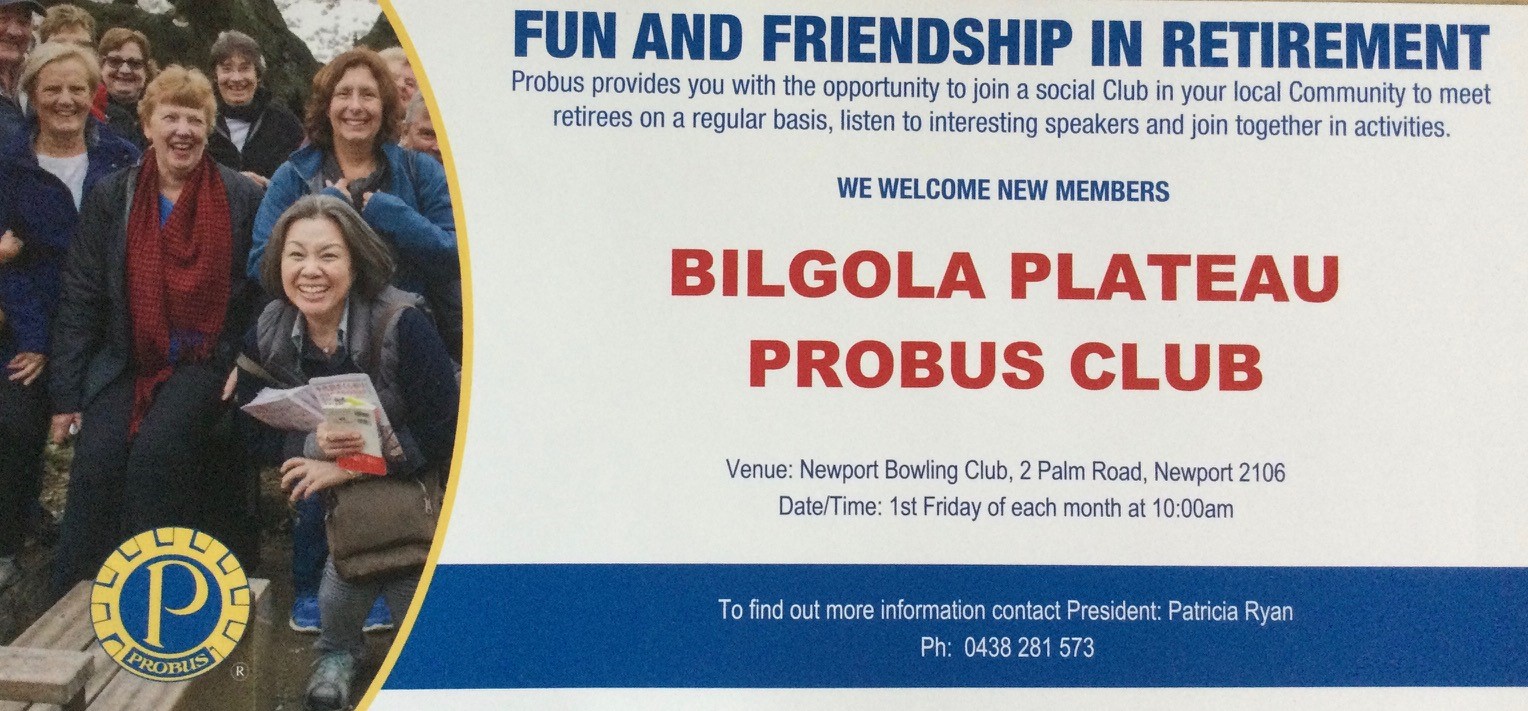

Pensioner's Concessions: Council Rates
- Half of the total of your ordinary rates and domestic waste management service charge, up to a maximum of $250.
- Half of your water rates or charges, up to a maximum of $87.50.
- Half of your sewerage rates or charges, up to a maximum of $87.50.
My work investigating the links between viruses and Alzheimer’s disease was dismissed for years – but now the evidence is building

This article is part of the Insights Uncharted Brain series. There are many competing theories about what causes Alzheimer’s disease. Here, Ruth Itzhaki reflects on a career dedicated to one of the more controversial lines of research.
Life is not easy for any of us. But what of that? We must have perseverance and above all confidence in ourselves. We must believe that we are gifted for something and that this thing must be attained. — Marie Curie
When I was about seven or eight, I asserted that I wanted to be a scientist, or so my parents told me years later, even though I would have had little idea of what that word meant. In my mind, I was perhaps associating it with making momentous discoveries that were immediately recognised and applauded by the whole world. Soon after, I avidly read Madame Curie, the book by Eve Curie about her mother Marie and how she overcame poverty and the many challenges faced by women in the late 19th and early 20th century to become a Nobel prize-winning scientist. Marie Curie became my lodestar for the future and thanks to my parents’ support and self-sacrifice, I did eventually become a scientist.

Many years later, I found myself confronting what seemed like insuperable odds just as Curie did, though in very different circumstances. I have been an independent researcher since the age of 26 when I completed my PhD. My subsequent research in a Cambridge University department on chromatin (a complex of DNA and proteins) went well. Then, after eight years, my husband and I moved to Manchester where the head of the institute where I worked for 12 years decided to end my contract, leaving me jobless and lab-less.
In the decades that followed, my research into viruses as a possible cause of Alzheimer’s disease was greeted with much hostility, and almost all my funding applications were refused: a hostility that has continued for 25 years and which has only recently abated, thanks to mounting evidence.

This story is part of Conversation Insights
The Insights team generates long-form journalism and is working with academics from different backgrounds who have been engaged in projects to tackle societal and scientific challenges.
I, along with my tiny research group, survived only through the award of a few small grants from more open-minded charities and companies interested in new approaches. Once I even managed to swap a business class ticket to the US (that was provided for me to speak at a conference) for economy class, so I could use the several thousand-dollar surplus for my lab instead.
But, after years of struggle, there is finally hope for this line of research. An anti-viral trial for Alzheimer’s – the first ever – is now taking place at Columbia University. This study is building on the years of work done by my team. Meanwhile, our latest research is looking into the way infectious illnesses increase the risk of Alzheimer’s.
You can listen to more articles from The Conversation, narrated by Noa, here.
Dementia Brought Home
Career and academic challenges can always be balanced with the help of a support network: a family. I was always lucky with mine. During many of these years, my husband, Shaul Itzhaki, a retired academic who had worked on nucleic acid biochemistry, supported my struggles and never once suggested that I change to a safer, more conventional and non-contentious topic. He was always touchingly happy with any successes I had, and I will always remember our celebratory days when I was awarded a Beit Memorial Fellowship for Medical Research, and later a Newnham College Fellowship, during our years in Cambridge.
Sadly, he died in April 2022, after suffering for about ten years from vascular dementia (a dementia distinct from Alzheimer’s disease but with many similar symptoms) and latterly, from a fractured femur that disabled him. The last four or so years were particularly hard to endure as he became increasingly aware of his failing memory. The term “brain fog” is often used in this context, but to me, it seemed more like a mist through which he could very dimly see or perceive what he was struggling to recall; the frustration – desperation, perhaps – that he felt at his inability to grasp, hold, then voice these elusive thoughts was pitiful.

I often took him to talks on topics such as the climate, migration, history and ageing, hoping to keep his mind occupied. He seemed to understand many of them, but afterwards, he was quite unable to discuss them, as his memory and ability to speak were declining inexorably. Communication of any type between us was slowly becoming impossible, although he was the person with whom I had once shared my thoughts and hopes, just as he had done with me, and it became particularly sad and unsettling, as we had had so many interests in common. Eventually came the realisation that I had “lost” him. It was a bereavement – the loss of him as a person, loss of a mind, not the death of a body; he was existing but not really living.
Another common feature of dementia – sudden changes of mood – affected him during these years. He had been a generally gentle, courteous person. But when, at times, the illness overcame his natural traits, he became violently angry, often for no obvious reason. Part of the problem was that his sense of location had faltered and often during the evenings he became convinced that we were about to leave and go “home” to Manchester, a place we had left in 2013. He would ask repeatedly and anxiously when we had to leave to catch the train to get there. Television programmes, even those on historical events, which would have been of particular interest to him, had to be vetted as he lost himself within them. So that after watching one that dealt with, say, the horrors of war, he thought that he was actually living in that frightening world.
Of course, there are so many families going through what my family went through. And there will be many more. That fact has provided one of the main motives for my pursuing my research, despite all the difficulties that have come with it.
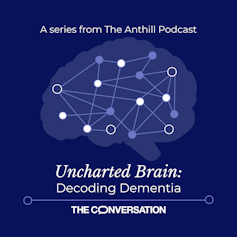
This article is accompanied by a podcast series called Uncharted Brain: Decoding Dementia which examines new research unlocking clues to the ongoing mystery of how dementia works in the brain. Listen to the full series via The Anthill podcast.
Early Challenges
During the last five years, studies supporting the idea of a viral role in Alzheimer’s disease have greatly increased. Despite this, there is still much opposition to the concept, while many in the field still ignore it.
I am often asked why there has been such hostility. A charitable explanation is that the possible role of a virus in dementia is difficult for others to assess because it straddles two very different topics: virology and Alzheimer’s disease. Also, many cannot grasp the concept that people can be infected but not affected (asymptomatic, when the virus resides in the brain without causing symptoms) so they dismiss the data. Either way, I have always stressed that many possible factors lead to Alzheimer’s disease – a viral role is just one of them.
My interest in this particular area began, rather unpromisingly, in 1978 when the aforementioned head of institute ended my work contract. The reason he cited was that my research on chromatin, and on the effects of carcinogens on chromatin, was “rather individualistic”. I thought this was an extraordinarily inept criticism, as I had generally been acknowledged as being an innovative researcher, and innovation is surely the key to good research. The funding body offered me a post in Glasgow, but that would have meant leaving my husband and children in Manchester.
Luckily, I was immediately given a home in the lab of a medical virologist friend, Richard Sutton. Sutton was an eccentric and pioneering man. He was dogged and wiley, in an endearing way. It was Sutton who first suggested to me the possibility of viral involvement in Alzheimer’s disease.
The argument for the role of the cold sore virus, herpes simplex type 1 (HSV1), in Alzheimer’s disease was first suggested by American neuropathologist Melvyn Ball in 1984. But he did not pursue the idea in any practical way. Sutton and I carried out what was probably the first convincing experiment seeking the DNA of HSV1 in the human brain. We had predicted that it might be detectable in the brain of immunosuppressed patients because in the absence of an adequate immune system to keep it under control, the virus would be able to multiply. We did indeed find it, and published our results in 1986.
The Central Concept
HSV1 is mainly transmitted by oral-to-oral contact, causing oral herpes (cold sores). Globally, an estimated 3.7 billion people under age 50 (67%) have HSV1 infection. Most infections are asymptomatic.
Over the years, the supportive data we gathered for the key role of HSV1 in Alzheimer’s led me to propose a central concept: that HSV1 is a major cause of Alzheimer’s disease; that in many people, the virus travels to the brain, probably in middle age, and remains present there in latent (dormant) form, but is frequently activated by episodes of stress, head injury, immuno- suppression and infections. These “reactivations” lead to productive HSV1 infection and inflammation (and consequent damage to the brain) over the years. The accumulated damage leads eventually to the development of the disease.
The possible role of HSV1, specifically, was proposed for three main reasons. The locations of the damage the virus causes in the brain during the rare but extremely serious acute disease herpes simplex encephalitis (HSE) – caused by HSV1 – are precisely the main sites of damage found in the brains of patients with Alzheimer’s disease.
The other reasons for implicating HSV1 were that it is very common, affecting at least 80% of the population (in earlier decades more probably 90%), and its ability to remain dormant in the body for years.
These features meet two main characteristics of Alzheimer’s disease: that it is all too common, and that it almost always waits until old age to strike its victims. Certain other infectious agents are probably involved too, perhaps individually or in combination, but so far these have been less well studied than HSV1.
The Laboratory Work
I was offered a more long-term prospect for my research in a department of the University of Manchester’s Institute of Science and Technology. The head of the department, John Cronley Dillon, was a larger-than-life character, a bon viveur and art lover, full of novel ideas and wild enthusiasm. He encouraged me to build up a research group (minuscule though it was) and eventually we started the research on HSV1 and Alzheimer’s.
It was known that when a person is infected with HSV1, the virus resides lifelong in the peripheral nervous system (PNS) – the part of the nervous system that doesn’t include the brain and the spinal cord — in a latent state. It is dormant until it is activated by events such as stress. In 1989 we decided to look for HSV1 in the brain, using the technique of polymerase chain reaction, or PCR. We used PCR to examine DNA extracted from autopsy specimens of Alzheimer’s disease patients.
This was the first time PCR, then a new technique, had been used for this purpose. The principle of PCR is to detect a specific sequence in the target DNA by chemically amplifying it, thereby making it vastly more sensitive than the methods used in the previous few studies seeking HSV1 DNA in the brain. However, this method was prone to contamination and could produce spurious data. This meant that my poor PhD student, Gordon Jamieson, spent many frustrating months trying to get it to work satisfactorily. So we were overjoyed when we detected, unambiguously, the DNA of the virus in the brain in 1991.
This was the first microbe to be detected in the human brain (in controls, in the absence of a disease). We were puzzled, though, as to why the virus was present in a high proportion of brains – both control brain specimens (people who had not been diagnosed with Alzheimer’s) as well as the brains of patients who had died with the disease. This near equality of prevalence does not undermine the role of HSV1 in Alzheimer’s, as some in the field have asserted. Many of the control brains were, in fact, infected with HSV1 but were asymptomatic.
So people can be infected but be asymptomatic, indicating that infection alone is not sufficient to cause disease. A very relevant example is that of cold sores which afflict only a proportion (ranging from 20-40%) of those infected with HSV1. The other 60-80% are asymptomatic. Clearly, another factor determines the degree of damage caused by the virus.
Other Supporting Factors
That was something we identified in 1997 when we discovered that the virus confers a high risk of Alzheimer’s disease when in the brains of people who carry a specific genetic factor. We were extremely excited by this finding, but also apprehensive about adverse reactions of some in the field, as had occurred before when we discovered HSV1 DNA in elderly brains.
So we were even more excited when, after I’d suggested examining cold sore sufferers (via a small blood sample), to find what variant of the specific genetic factor they carried, we discovered that it was the same variant as for Alzheimer’s. In other words, the same variant of the genetic factor conferred a risk of damage in the peripheral nervous system, as well as the central nervous system.
Of course, the question arose as to what it is doing, if anything, in the brain. Is it residing there merely as a passenger, doing little or nothing, or does it cause damage?
We investigated this by examining cerebrospinal fluid (the liquid that bathes the brain) looking for antibodies to the virus. We detected these antibodies in most samples of cerebrospinal fluid, again, consistently, in both Alzheimer’s patients and those in the age-matched control groups. This showed that indeed the virus was not just a passive fellow traveller.
We then decided to find if there were direct links between the effects of HSV1 infection and Alzheimer’s. Very hesitantly, like explorers in a new continent, we infected human brain cells with HSV1, then stained the cells with antibodies to the specific abnormal proteins seen in Alzheimer’s brains – amyloid and tau.
To our surprise and delight we saw accumulations of both types of protein. Also, we found amyloid deposition in the brains of infected mice. However, getting the results published was a Sisyphean task and journal reviewers’ comments were often incredulous.
We subsequently used a very complex technique (in-situ PCR) which revealed that in tissue sections of brain, most of the viral DNA was located very specifically within amyloid plaques. This suggested that amyloid might act to cage the virus, thereby inactivating it. All this work provided strong support for a major role of HSV1 in Alzheimer’s, and much has since been extended by other labs.
We also discovered that anti-herpes treatment was protective because it substantially reduced the damage level in the cell cultures we were testing. This further supported a role for the virus in the disease – and pointed to a potential treatment.
A Heretic Shunned
But a viral role in the development of Alzheimer’s was still seen as heretical by many researchers, so our papers continued to be rejected by one journal after another.
For academics, having research published in top journals is often central to keeping your job and career progression because of the perceived value to universities (related to university league table rankings, supposed research quality and performance management).
Similarly, almost all of our grant applications over that 25 years were refused, too, which was even more serious as without funding, the people in my lab couldn’t be paid nor materials bought. I was very fortunate in having three successive post-doctoral researchers, Woan-Ru Lin, Curtis Dobson, and especially Matthew Wozniak, who were so dedicated that they were willing to continue to work even when on repeated short-term contracts (sometimes for less than 12 months).
So most of my time was taken up in writing research proposals and filling in application forms, interspersed with writing and submitting articles to journals, and when rejected, trying another. I had to face derision and hostile rants unaccompanied by any meaningful, scientific criticism from reviewers. A typical example was: “This grant essentially centres on a question of belief; are viruses important in Alzheimer’s disease, in my view they are not.”
Each rejection seemed like the end of the world. It was a heart-stopping moment when opening the envelope or email from the funding body and scanning the lines in the hope of finding the words, “I’m pleased to tell you …” – though all too often, I found the words, “I regret to tell you”. I hid, weeping tears of despair, while a part of my brain questioned whether the work really was nonsensical and whether the ideas were just wild fantasies.
At conferences, I was often shunned by prominent people in the field. My poster presentations were too (posters were the poor man’s alternative to giving a talk, a privilege I was rarely given). Although, hearteningly, I found that younger people were interested and excited by the research.
Later, I benefited from the generosity of a colleague, Janusz Kulikowski. Kulikowski was another eccentric who lived an upside-down life, working at night and either sleeping during the day or else amusing himself by lobbing provocative remarks at colleagues. He was really interested in our research, despite working in the totally different field of vision research.
I do realise of course that many others have suffered refusals of grant applications, and I understand how especially heartbreaking it is for those at the start of their career, as it usually means the end of all their hopes and dreams of becoming a scientist. I realise too that I had been exceptionally lucky in being able to do such utterly engrossing work – a continuous, totally fascinating puzzle and challenge – and in having a loving family.
But after each rejection my fear that the work would end was overwhelming. When I did get a grant – any grant – I was elated: the world sparkled. I was so happy and exuberant, not just with the funding but with the fact that some people in the field were supportive of, or at least willing to consider, a possible role for HSV1. I felt so encouraged, vindicated and ready to face any challenge in my work or from fellow scientists, and brimming over with ideas for new approaches.
Quite often in the later years, some strongly supported our central concept. But there was a huge divide between them and its opponents. And the hostility continues to this day. In 2019, an application by a colleague to a US funding body for a clinical trial of an antiviral for Alzheimer’s was refused. I was involved as an adviser because it was based on my lab’s research, though I was not an applicant.
One reviewer said: “This application is peripherally related to the idea that Human Herpes Virus (HHV) infection could play a role in Alzheimer’s disease pathogenesis … the evidence is weak, the supporting data are weak.” The second reviewer proclaimed: “The novelty of this approach appears to be quite lacking. The suggestion of latent microbe-based activation by (unknown) factors coincident with a ‘deteriorating immune system’ as the cause for Alzheimer’s seems like hand waving”: poetic perhaps, but hardly a brilliant display of scientific disputation. In fact, no adverse comments had ever been supported by any scientific argument, despite a public assertion once by a senior government official that the HSV1/Alzheimer’s work had been refuted (though when challenged, he was unable to cite any such article).
Most researchers acknowledge that new, surprising and challenging ideas should be viewed with caution. But ideas should not be dismissed without any deliberation. Perhaps another major reason for the hostility is that many people in the field have been working for several decades on amyloid as a cause, and so are understandably distressed on learning that it might not be a direct cause, except in rare familial cases. This occurs despite our repeatedly stressing that numerous factors contribute to Alzheimer’s and amyloid is clearly an important feature.
Exciting Developments
But, as the Columbia University study shows, attitudes to the topic of Alzheimer’s and HSV1 are slowly, but steadily, improving. Of course, I am very happy about this, for the sake of patients and their carers. And I have to admit that recognition of the work on HSV1 is personally gratifying as, like most people, I am heartened to know that my work has achieved something.
I am pleased that the research that I and others are carrying out is now moving forwards in even more exciting directions, including the use of a 3D bioengineered human brain model which, when infected with HSV1, displays many Alzheimer’s-like characteristics.
We are now investigating the effects of infectious diseases and a possible role for vaccinations. This follows an explanation I published with my then-senior post-doctoral associate, Curtis Dobson, to account for the finding that certain vaccines decreased the risk of Alzheimer’s disease. We suggested that infections might reactivate latent HSV1 in the brain and that vaccines might decrease the consequent risk of Alzheimer’s disease by reducing the occurrence of such infectious diseases.
For example, in the case of shingles – which is caused by another type of herpes virus, varicella zoster virus (VZV) – a recent study I carried out with Manchester University epidemiologists showed that vaccination against the disease may protect against the development of Alzheimer’s. Two subsequent studies showed the same result. However, much further work needs to be done to elucidate the findings that certain types of vaccine appear to reduce the risk of Alzheimer’s.

I, along with researchers at Tufts University, then decided to find out if VZV (which also causes chickenpox) plays a role similar to HSV1 in causing brain damage leading to the development of Alzheimer’s.
Our results showed that VZV infection of the cells does not lead to the formation of the main characteristic Alzheimer’s features in the brain. However, VZV infection does result in certain other Alzheimer’s-like features, including increased inflammation. And – importantly – VZV was seen to reactivate the latent HSV1 infection in the brain model, with the consequent occurrence of Alzheimer’s-like characteristics. This is consistent with our suggestion that infections reactivate latent HSV1 in the brain.
The recent evidence that another herpes virus, Epstein Barr, is a cause of another brain disease (multiple sclerosis) strengthens the likelihood of viral involvement in certain other such diseases.
We now plan to find out if other infections cause HSV1 reactivation from latency. If they do, the obvious corollary would be to try to limit infections by vaccination, and by improving standards of hygiene and living conditions – a particular need in developing countries – to reduce microbial transmission.
In addition, we now have some exciting preliminary findings suggesting that percussive brain injury (for example, concussion) can cause HSV1 reactivation. This is a very different type of injury from infection and the results suggest that the virus might be pivotal in the brain’s response to diverse types of damage.
This is an exciting field of study and I hope bright young scientists will enter it. Nobody said being a scientist was easy, but with the right encouragement from family, friends and open-minded peers, it is amazing what challenges can be overcome.

For you: more from our Insights series:
To hear about new Insights articles, join the hundreds of thousands of people who value The Conversation’s evidence-based news. Subscribe to our newsletter.![]()
Ruth Itzhaki, Professor Emeritus of Molecular Neurobiology at the University of Manchester and a Visiting Professorial Fellow, University of Oxford
This article is republished from The Conversation under a Creative Commons license. Read the original article.
New Analysis Of Australian COVID-19 Mortality Rates Released
- Wave 1: as occurring between March and May 2020. The predominant variant during Wave 1 was the original virus strain.
- Wave 2: as occurring between June and November 2020. Wave 2 predominantly occurred in Victoria. The variant during Wave 2 was the original virus strain.
- Delta wave: as occurring between July and December 2021.
- During Wave 1, nearly all of the deaths (99.1%) had COVID-19 recorded as the underlying cause of death.
- Over 80% of deaths have occurred during the Omicron wave.
- The largest number of deaths have occurred in January (1,828), July (1,759) and August (1,444).
- Each of these months exceeded the 1,396 deaths recorded during the entire period of the Delta wave.
Younger Generation Experienced Most Workplace Stress During COVID-19 Pandemic
Ray Of Hope: One Place Where Reef Manta Rays Are Thriving
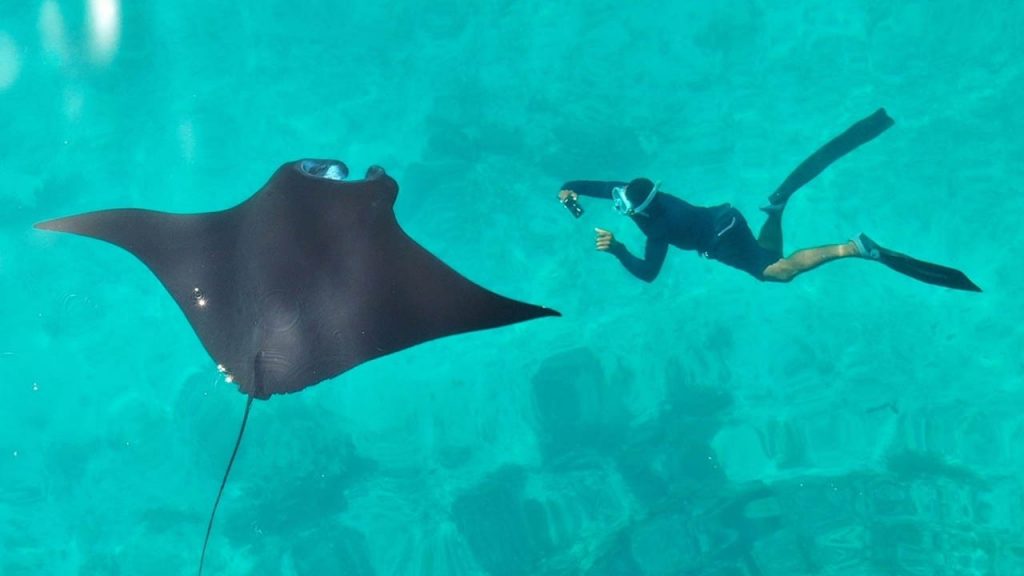
Tracing The Origin Of Kampo: Japan's Traditional Medicine
Genes To Potentially Diagnose Long-Term Lyme Disease Identified
Dam Safety: New Australian Study Indicates Probable Maximum Flood Events Will Significantly Increase Over Next 80 Years
Study Finds Feeling Poorer Than Your Friends In Early Adolescence Is Associated With Worse Mental Health
Half Of Replanted Tropical Trees Don't Survive
A Chemical Reaction As Good As Gold
- Difficulty in targeting only one specific bond for reaction (poor selectivity).
- A lot of energy is required to break these bonds (high activation energy).
Scientists Say Sea-Level Changes Formed Australia's K'Gari Sand Island: Great Barrier Reef
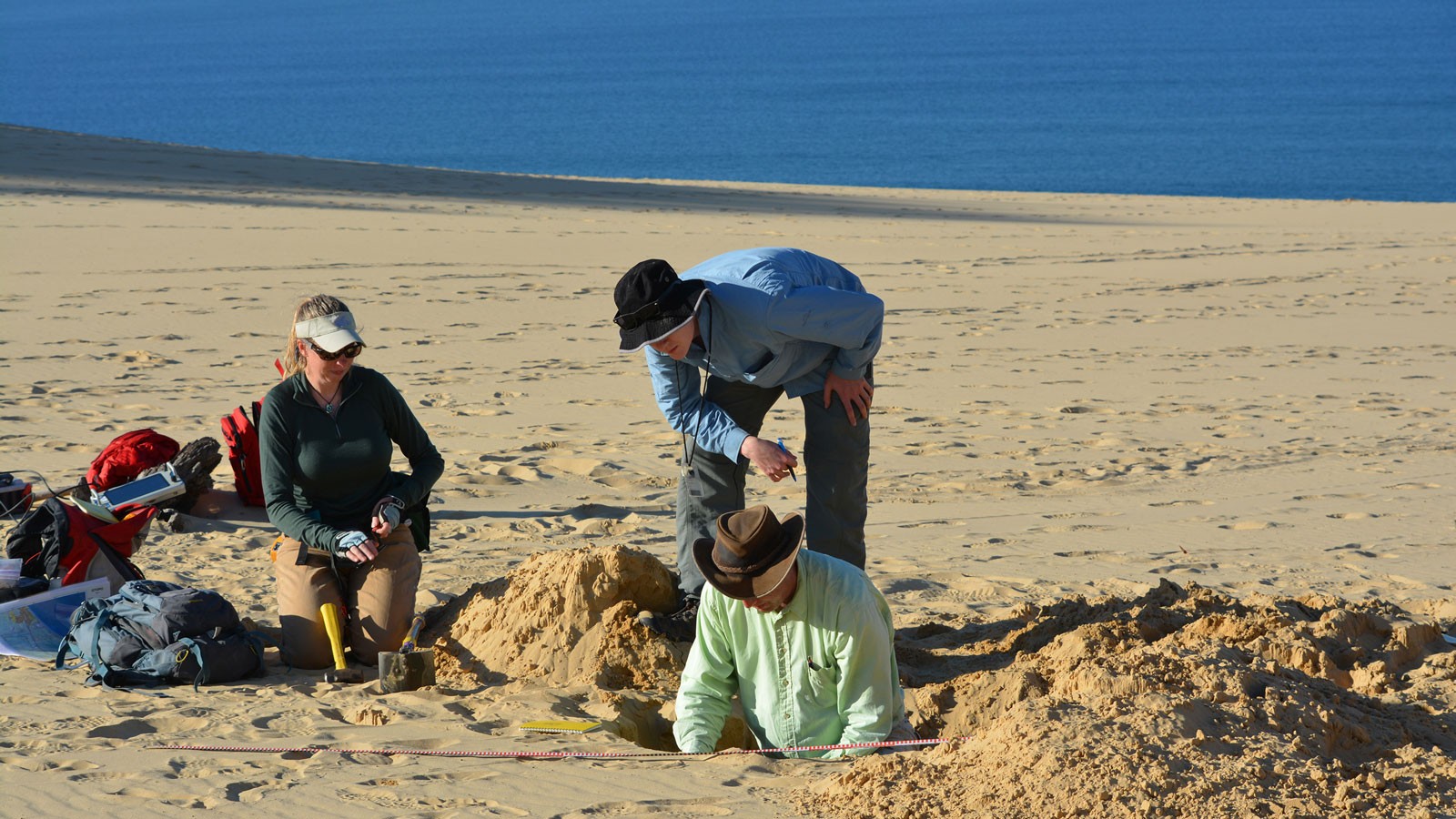
Prehistoric Predator? Artificial Intelligence Says No
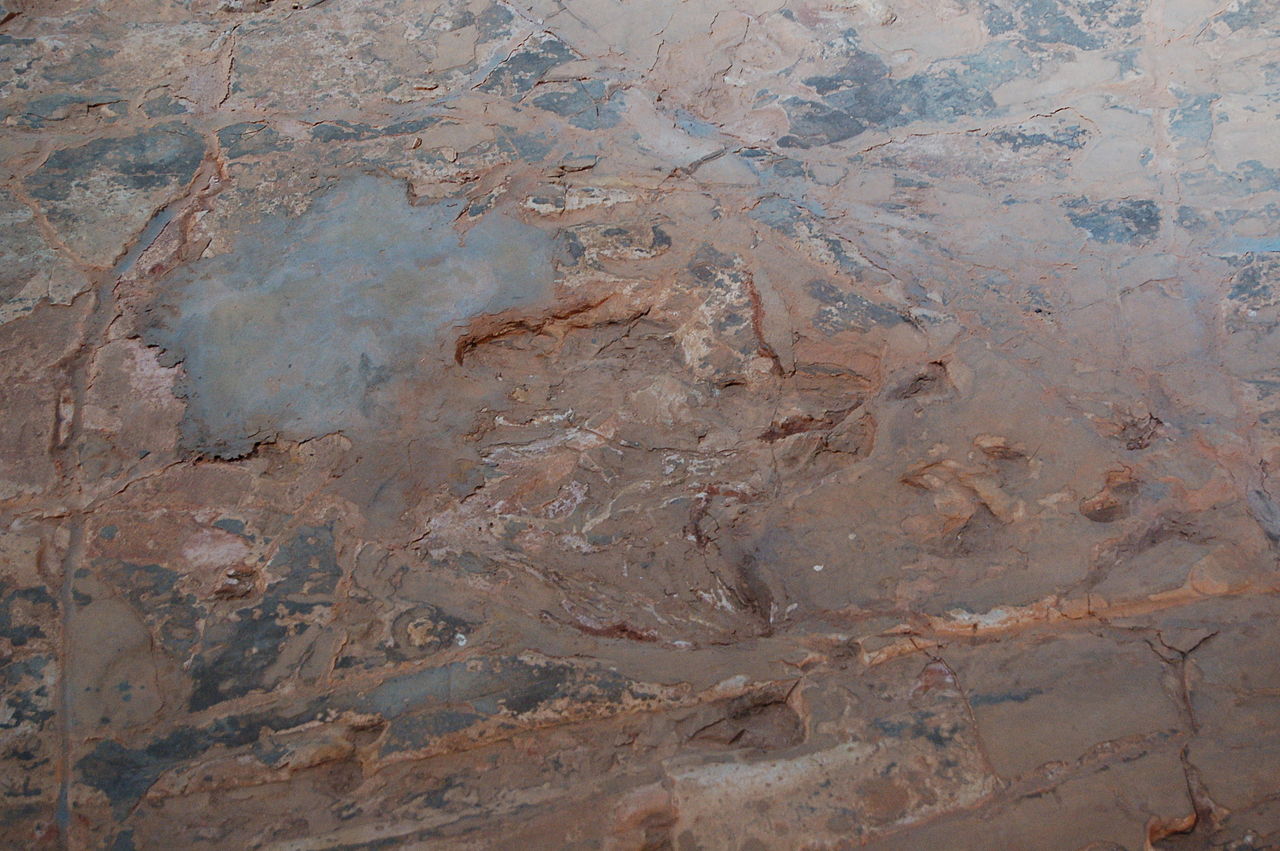
Disclaimer: These articles are not intended to provide medical advice, diagnosis or treatment. Views expressed here do not necessarily reflect those of Pittwater Online News or its staff.